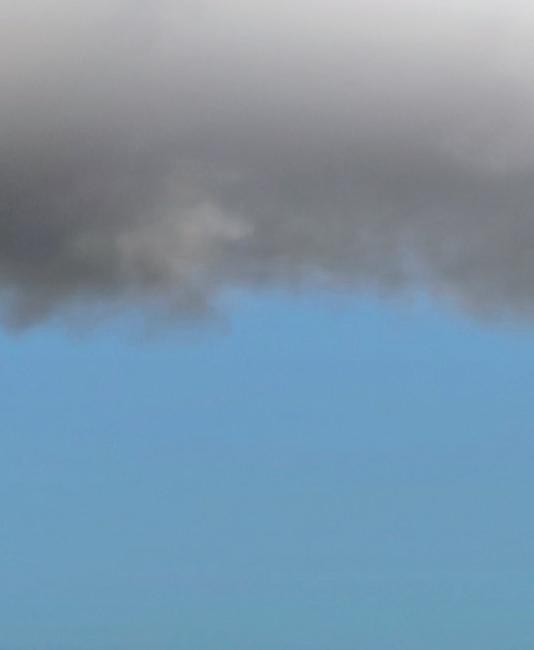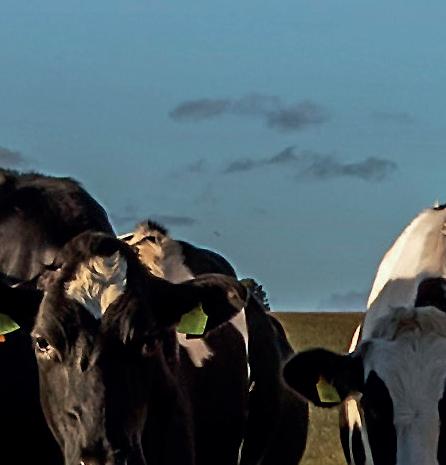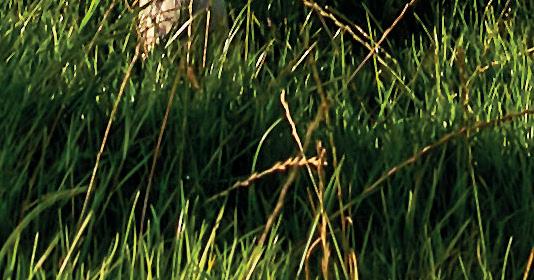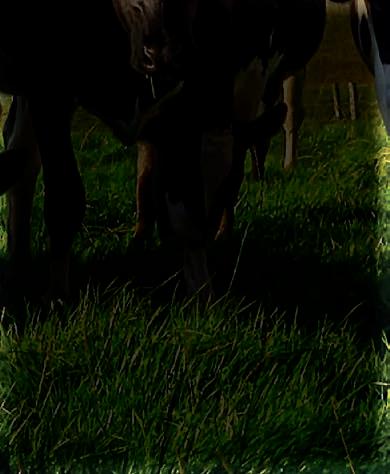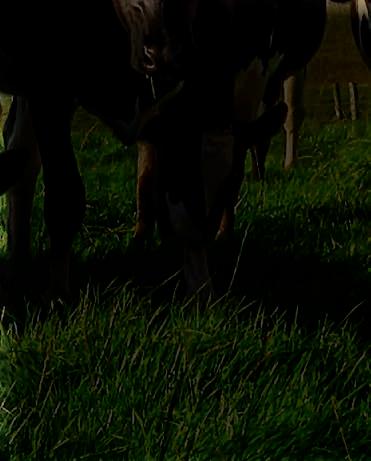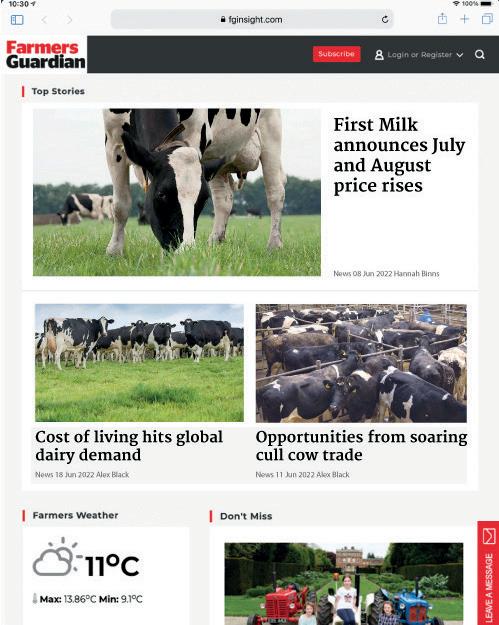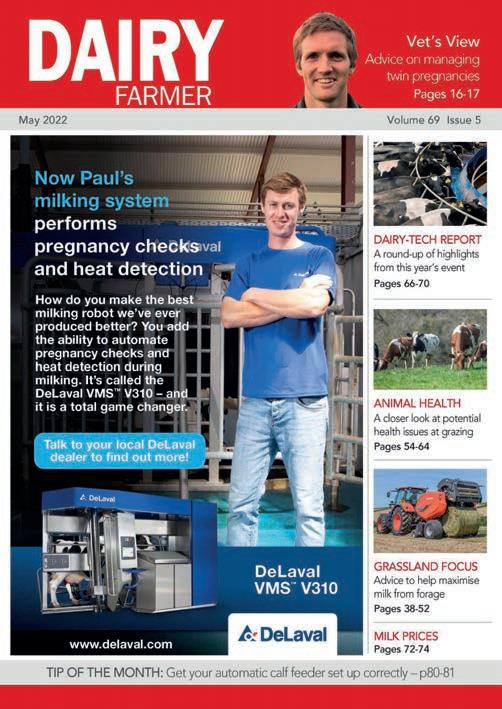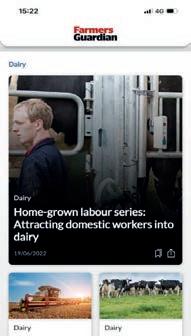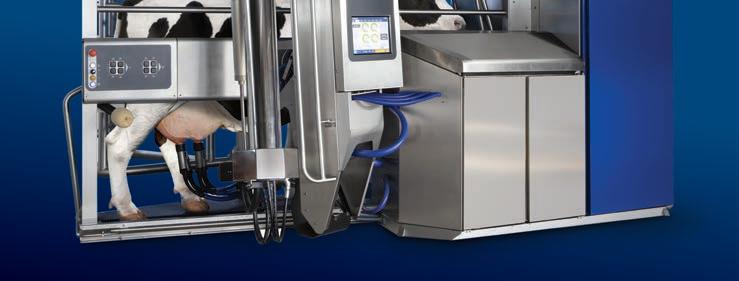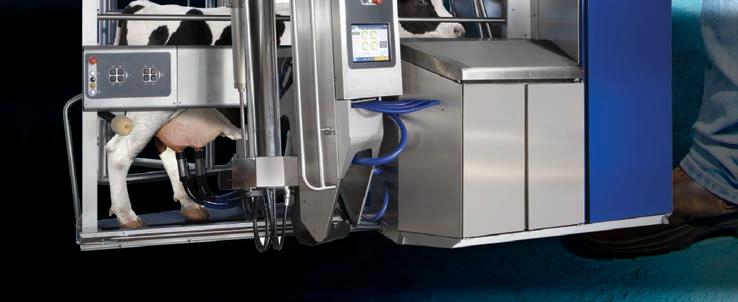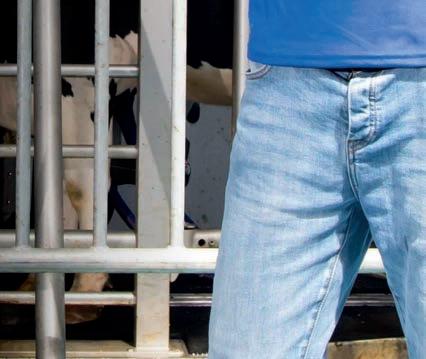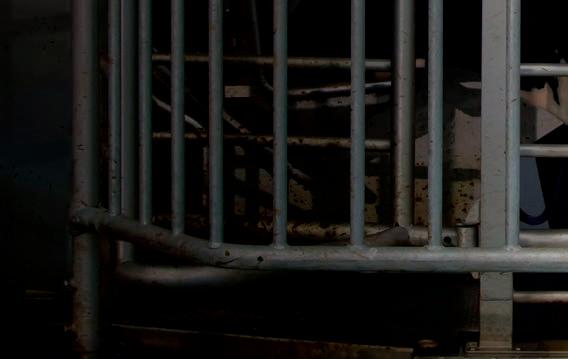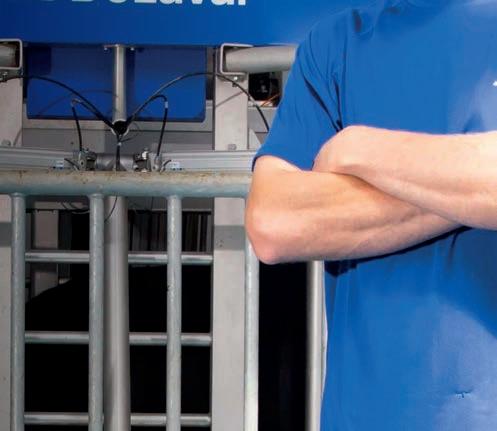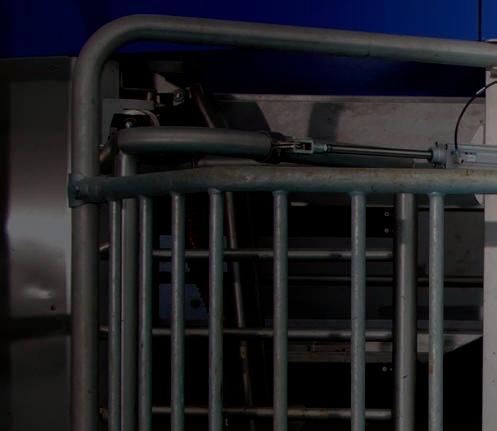
















Mike Begley
Picture Editor
Marcello
marcello.garbagnoli@agriconnect.com


Head of Commercial Solutions
Mike Hartley
Account Manager
Mark Jackson
Classified
Advertising Production
Circulation
Subscription
Dairy
Iusually try to steer clear of ‘weather talk’ in these columns. Mainly because more often than not the weather will have changed before the magazine lands on your kitchen table.
But in this case I am hoping the weather does indeed change, with much of the country now desperate for rain.
Over the last few weeks we have seen heatwaves, extreme weather warnings, hosepipe bans and official drought declarations for some parts of the country.
And while England experienced the driest July since 1935, the reason for the current drought situation is also down to the rainfall we have had in previous months. For the UK as a whole, nine of the last 12 months have been drier than average.
Livestock farmers are having to deal with
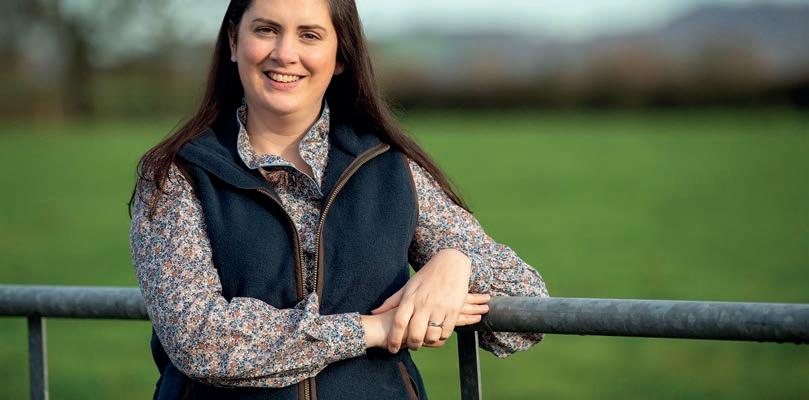
limited grazing and the prospect of lower conserved forage stocks going into winter, due to lighter silage and maize crops. Many will be looking at the options of buying-in feed, opening up precious winter feed clamps early or reducing stock.
This feels like a double whammy, given the well-documented rise in input costs farmers are also having to factor into their budgets. What is clear from milk production data is that production globally is down on previous years and for the UK in particular that trend looks set to continue, given the current weather and feed situation (for more on global milk shortages, see pages 92-93).
What impact will this have on the price of milk? I’ll ponder this while I join farmers up and down the country in perfecting my rain dance.
DAIRYING
RISK
Farmers are having to make di cult decisions ahead of the winter time, as they turn to feeding winter forage to ca le following the drought.
A lack of grass has meant farm ers are using their winter feed now with concerns already for forage stocks in the winter.
Amy Eggleston, a dairy farmer from Leicestershire, said they had not had any ‘proper rain’ since early June.
“My dad has been farming here his whole life and says this is the driest he has ever seen the
farm. Essentially, we do not have enough grass to feed the cows.
“We are using our winter feed now to feed the cows,” she said.
ForageAid trustee and Som erset farmer James Winslade said while nobody had asked the charity for help yet, there could be a serious forage shortfall this winter.
“Quite a few southern dairy farms are feeding rst cut silage and some have yet to get their second cut as there is no grass around,” he said.

J ieves are looking to make up for lost time a er the Covid19 pandemic, with Land Rover Defenders the s spiking in 2021, NFU Mutual has warned. e insurer has urged farmers to be on their guard, despite new gures revealing that the cost of rural crime fell for the second consecutive year in 2021, down 9.3% to an esti mated £40.5 million.
Rebecca Davidson, rural a airs specialist at NFU Mutual, high lighted security measures, rural crime initiatives, quieter roads and community vigilance had
played their part in suppressing countryside crime in 2021.
But she warned there was no time for complacency, as initial claims gures for the rst quarter of 2022 showed costs were up by more than 40% on the same per iod the previous year.
Her comments followed the pub lication of its latest Rural Crime Report, which found Land Rover Defender the costs were up 87% to £2.6m in 2021, as criminals stole the iconic vehicles and stripped them down.

According to Met Office statistics, England experienced the driest July since 1935.
“While there may be an oppor tunity for another cut, most will not have their usual three cuts.
“Hopefully it will be a short winter or the charity will be needed more and more.”
It comes as processors an nouncing prices spoke of the markets ‘stabilising’.
But NFU dairy board chair Michael Oakes said there were still question marks over where the prices would go next with milk pro duction not picking up and traders he had spoken to trying to gure out if the market had peaked or if it was the ‘normal August lull’.
“ ere is still not a lot of con
dence from farmers to produce more milk.

“ en you have commodity traders who buy forward wonder ing whether they should be buy ing or they risk being le without product,” he said, adding there did not seem to be much news to push the price back down.
Farmers were not pushing for more milk, said Mr Oakes, and were considering their options ahead of the winter period.
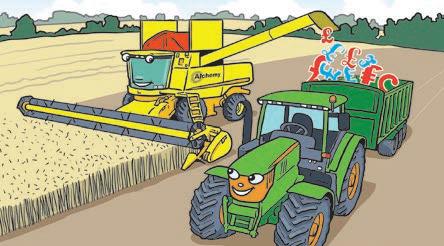
He said many were consid ering selling cows ahead of winter with prices good, which would have a knock on e ect on production.
JA group of more than 60 farmers has called on the Government to support a transition to regenerative agriculture in response to soaring fertiliser and fuel costs.
According to the alliance, brought together by the Sustainable Food Trust, the crisis has highlighted the scale of the UK’s dependence on imported inputs. It said a shift to regen methods was ‘essential’ for longterm domestic food security in an increasingly volatile world.
JNinetyfour per cent of respondents to a new Countryside Alliance (CA) poll have rejected the claim that the BBC covers rural issues fairly and impartially.

The survey, which canvassed more than 3,400 CA members, was launched in response to the broadcaster’s recent announcement that it had set up an internal content review for specific programmes.
The poll found 92% believed the BBC’s national news failed to represent rural issues, while 89% felt the same about Countryfile 79% about The Archers.
While there may be an opportunity for another cut, most will not have their usual three cuts
JAMES WINSLADE
Milk prices need to remain at record highs to preserve the Sco ish dairy herd, a er the latest Sco ish Dairy Ca le As sociation (SDCA) gures showed there were 13 fewer dairy herds since the start of the year.
at was the message from NFU Scotland milk commi ee chair Gary Mitchell as the SDCA revealed its latest set of gures.
ere are now 819 herds in Scotland with average cow num bers standing at 231, an increase of two animals per herd since the beginning of January.
Lanarkshire was the county most a ected by the reduction in the number of farms involved in dairying, with a net loss of four herds. Dumfriesshire and Wig townshire each lost three herds. e gures also showed that the percentage of cows being o cially milk recorded had remained static at 72%.
Jane e Mathie, SDCA secre tary, said: “ ere is a continued
There are 13 fewer dairy herds in Scotland since the start of the year.
increase in individual cows regu larly monitored for somatic cell count, pregnancy diagnosis and health testing, especially Johne’s, IBR and BVD, through milk samples.
“ is gives more accurate infor mation to assist be er nutrition, fertility and health management.”
Mr Mitchell said: “Milk prices must continue at record levels and keep running ahead of unpreced ented input costs if the latest dairy herd gures for Scotland are to be maintained in 2023.”
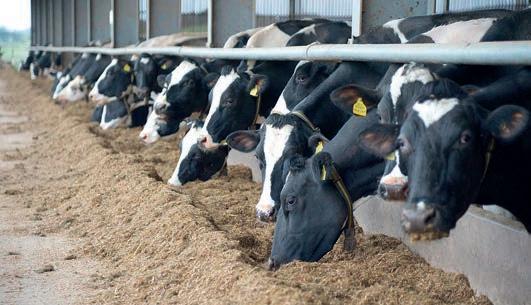
He added it would be fascinat
JFor some years now, farm groups have been asking Govern ment where food production sits in policy terms, writes Abi Kay.
But now, they are starting to ask where it sits in practical terms too.
At the moment, we are hear ing a new story every day about how viable farmland is being lost to housing developments, solar farms or afforestation.
This rush to plant trees to help meet the country’s net zero target is particularly con cerning for the tenanted sector.
Recently, Defra reported a 3% reduction in the area of land let under Farm Business Tenancies (FBTs) between 2019 and 2020 – the first ever drop since FBTs were introduced in 1995.
The Tenant Farmers Association has laid the blame for this contrac tion at the feet of landlords who have been quick to take back land in order to cash in on Government tree planting schemes.
And with a further £44.2m being allocated by Ministers to plant 2,300ha as part of the Nature for Climate Fund, the
ing to see the gures in January 2023 following the in ation agri culture is facing.
“Not only are many dairy farmers receiving the highest milk price they have ever seen, but they also have a long list of costs and invoices to match,” he said.
With processor prices now approaching or surpassing 50ppl, Mr Mitchell said it was vital they remained high.
“ at price momentum must be maintained if the size and scale of Scotland’s dairy herd is to be preserved,” Mr Mitchell said.
problem is set to get worse. We cannot let this situation continue – a way has to be found to balance all the competing demands on our land.
Defra Secretary George Eustice has, belatedly, come to the same conclusion, promising recently to put together a land use strategy, despite his earlier reservations.
But the chances are he is on his way out when the new Con servative leader comes in.
No one wants to see the state in full control of land use, but the market is already being distorted
J
e biggest increase in inter est rates in 27 years will provide a further squeeze on margins for those with borrowing as the Bank of England a empts to slow in ation.

e bank announced the sixth consecutive increase, with rates rising from 1.25% to 1.75% in August.
Martyn Dobinson, partner at Sa ery Champness and a mem ber of the rm’s land and rural practice group, said it would hit farm businesses with borrowing.
“ e climate is looking very di cult now for farm and other rural enterprises operating with the tightest margins and li le, if any, prospect of respite as we move closer to a likely reces sion,” he said.
Interest rates were set to rise from 1.25% to 1.75% in August.
by Government targets. Ministers have a duty to protect farmers, farmland and food production, and that means taking action to mitigate the impacts of their earlier decisions.
They can start by keeping the pledge of a land use strategy alive.

Ketosis has a domino effect on the stability of the health of your herd, allowing damaging and costly disease conditions to topple their performance.
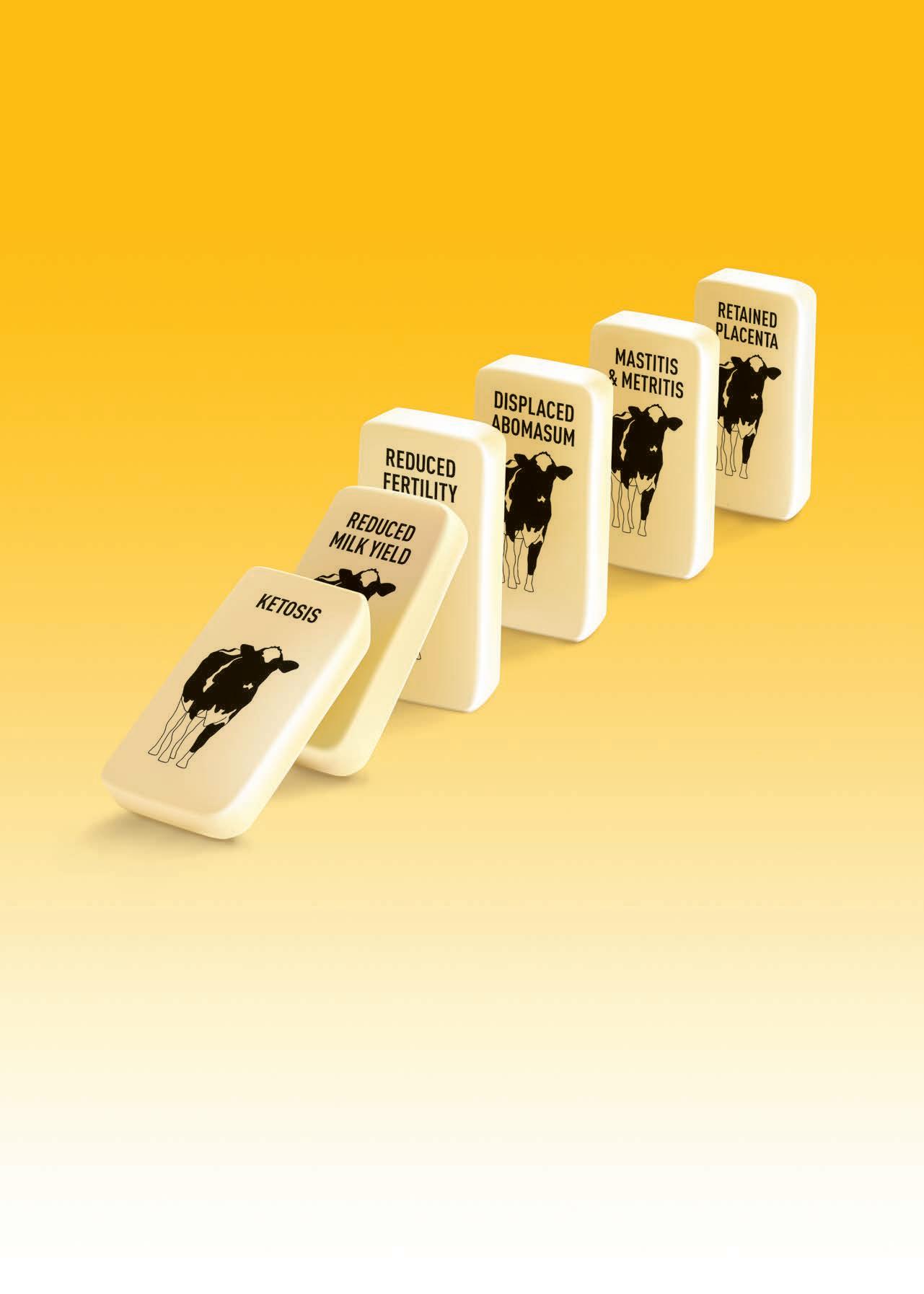
average, 28.5%1 of cows suffer from ketosis with SOFT* cows especially at risk. Identifying and protecting these vulnerable animals
a big step towards
cows
Dan and his family own and run the 300-hectare (741-acre) Cockhaise Farm, near Haywards Heath, West Sussex. The farm is home to an organic autumn-calving herd of 240 Holstein and Friesian crosses. He also contract farms another organic autumn-calving herd of 220 cows at Bore Place, near Edenbridge, Kent.
Although you will be reading this in September, I am currently writing this in mid-July, with temperatures knocking on the door of 40degC and my feet in a cold bucket of water to stave o self-combustion in my tropical o ce.
Although the temperatures are certainly on the high side, we are fortunate it is only really for a couple of days, before normal summer weather resumes later this week.
In recent months, I have spent more and more time looking at the cost of running an autumn calving herd through winter, with ever-escalating feed costs making the production of milk uneconomic.

However, with every dry summer we receive, I feel relieved we are able to dry all of the cows o to far ung corners of the farm onto standing hay, therefore taking the pressure o the grazing platform.
As a simple self-feed farm, we are just not set up for bu er feeding, so the ability to stockpile grass through the good months to feed out now is our saving grace.
I have been fortunate enough to have had several groups of farmers and advisers here over the last month, although by the 10th visit the well-trodden route around the farm was looking a bit worse for wear.
I love the challenge of hearing honest views on what we are doing here. It is important I am able to come out of my comfort zone in order to keep on making progress.
Topics for discussion included the breeding of our cows, with question marks as to whether they really were the same 550kg average as when weighed four years ago.
We have nailed our colours rmly to the Irish Holstein Friesian mast over the last seven years and we have seen the bene ts of improved fertility and constituents, but I can’t a ord to milk bigger cows, particularly on an organic system, so will be weighing cows this winter to make sure we are still on the right track.
One of the other main talking points was slurry handling and the confusion over upcoming legislation and how that a ects what we do on the ground on our individual farms. At Cockhaise we have a lagoon which wraps around our cubicle shed, so completely incompatible with any sort of cover system.
We also use straw for bedding which then needs to be dug out once a year, again, not compatible with a cover.
We also use a Briggs irrigator to apply the watery slurry that comes through the weeping wall, a system which enables us to follow the cows round during the grazing season. But will this be allowable?
One thing for sure is that at some point in the near future we will need to invest signi cant capital in order to continue dairy farming, but for the time being I am happy to watch and wait, both for the clari cation on the rules, but also how other farms tackle these issues.
Before we start calving later in August, I am o for two weeks of yet more heat in Corfu. Having had our last three years of holidays cancelled, this is long overdue and a great opportunity to leave the farm, turn o my phone and have some much needed R and R.
As the challenges become greater in the coming years, it is really important to look a er yourself and those around you.
Becky Fenton and husband Paul milk 200 pedigree Holsteins under the Springlebee prefix at Centenary Farm, a Cheshire county council farm. In 2021, they bought a farm in Staffordshire and they plan to farm there once the new dairy set-up has been built.

Istart this column with achievement. A er several years out of the show circle, we decided it was time to get back out there. So at the end of July we a ended our local agricultural show, Nantwich Show. e show has been cancelled the previous three years and was newly relocated this year. We decided to take just one third calved cow and three calves for our boys to show.
I am pleased to say we came away with overall su preme dairy championship. is is something that we are proud of and the rst time we have achieved this accolade in our showing history.
All three of our boys took calves into the showman ship class and our eldest son took home the award for champion calf handler.
We have always been fond of showing and I can appreciate a good cow, but two things I always remem ber about judging of any kind really is ‘it is only one per son’s opinion’ and ‘is it best to have one amazing cow for everyone to see at a show or a good uniform herd of unrecognised cows at home?’
One thing myself and fellow exhibitors noticed at Nant wich Show was there was a real engagement and interest in the livestock from the general public. We were happy to answer questions they had and let them stroke the ani mals. We sometimes take for granted how lucky our chil dren are to grow up on a farm. A farmer once said to me ‘if you have not lived on a farm you have not lived at all’.
Since our farming journey began, we have always been keen to build our portfolio. is has always proved us well when applying for farms and other opportunities.
We recently entered the Cheshire Farms Competition and were fortunate to win two classes and were awarded rst prize in the ‘combined west and east Cheshire county farms’ class and also the and ‘dairy herd black and white’ class. is led us to be in with a chance in the overall supreme competition. Unfortunately we did not win but I would like to congratulate the Beck family of Sandbach on their success. We a ended their open evening and it demonstrated that they were worthy winners.
Here at Centenary Farm, we graze our cows day and night in the summer months, alongside silage fed twice daily.
In normal circumstances we have enough grass in front of them to rotate elds. However, in June and July we experienced exceptionally dry months with very limited rainfall and therefore limited grass.
We were forced to open rst cut silage and bu er feed 8kg of brewers’ grains and 1kg of blend. Adding moisture and palatability to the diet li ed intake and resulted in an increase of 2.8 litres per cow. at said we have nally had a downpour of rain and now ceased the blend. ird cut silage was minimal and disappointing due to the weather. Fourth cut is looking more prom ising and bulking up well. And we have shut o grazed elds for extra silage.
We recently completed our carbon footprint assessment, it was relatively painless, some might think pointless. Our next inspection is from the Environment Agency, who are carrying out routine visits in Cheshire to see if we are complying with regulations and discuss ways to protect the environment.
Meanwhile, I strive to get through the summer holidays without loosing the plot.
“ There was a real engagement and interest in the livestock from the general public
Holstein UK president John Jamieson made a switch to organic milk production in 1999 and has just completed a five-year plan to modernise the facilities on his farm near Dumfries. Wendy Short reports.
The 240 Holstein cows at the Jamieson family’s Upper Locharwoods Farm produce a 10,000kg yield from a simple organic diet of silage and home-grown grains, supplemented with a protein mix which is fed in the parlour.

e unit is run by John Jamieson and his wife Helen, together with their son Graham.
e Firth herd, which calves all year round and is milked with a 12-hour interval starting at 3.30am, is housed from early October until mid-March.
Milk production totals 2.2 million litres at 4.22% bu erfat and 3.02% protein, with milk sold to Muller.
e ve-year modernisation plan included the 2020 replacement of the 20:20 herringbone with a GEA T8900 rotary parlour, which is one of the rst models to have been installed in the UK.
Another new feature is 180place accommodation which has been designed speci cally for sand-bedded cubicles, although the transition group continues to be kept on sawdust-topped ma resses.
John says: “A fully sand-bedded cubicle can require up to six tonnes of sand per cow per year, but we have cut usage to 1t by applying a thin layer over ma resses.
“A sla ed se lement channel

runs through the shed and the sand is removed twice a year and spread on the land.” e sand bedding has addressed the drive to minimise the incidence of mastitis, he adds.
“As an organic farm, we must consider antibiotic usage as a last resort. If antibiotics do have to be administered, we face a double milk withdrawal period compared with a conventional unit.
“Our policy to use a teat sealant as standard across all dry cows works well and the sand bedding has been highly benecial in reducing the number of mastitis cases, with the current average for somatic cell count at 122,000. is reduced reliance
on the use of antibiotics continues to keep us focused.”
e dairy unit also bene ts from a 50kW solar panel system and a 200kW biomass boiler. Another element of the improvement was the installation of one million gallons of additional slurry storage; it has improved utilisation by allowing for more exible application times.
Sexed semen from genomic sires is used exclusively. Type classi cation is part of the Holstein Complete Package from Holstein UK and the unit currently has 34 EX and 115 VG-scored females.
ese come from families including Vale, Rudy, Missy and Roxe e. Lack of time prevents showing, but the herd has enjoyed previous success at AgriScot, as well as the National Holstein, Royal Highland and Great Yorkshire shows.
In the early days, Hanoverhill Starbuck had a signi cant in uence on the herd and subsequently animals and embryos were purchased from some of the top herds in North America and the UK.
e lower end and repeat breeders are put to an Aberdeen-Angus and their cross-bred calves are sold at four weeks to a local nisher. e aim is to calve heifers at 24 months.
All replacement calves are reared in hutches and fed pasteurised whole milk until 12 weeks and it has been found that giving calves warm water twice a day has improved growth rates.
John says: “ ere is no doubt that the biggest step forward within the dairy industry in recent times has been the introduction of sexed
semen. e technique is a great innovation and has li ed the burden of unwanted dairy bull calves on our farms.
“Our goal has always been to breed cows which have strength, good locomotion with high, wide rear udders and a wide rump.
“Another desired trait is low pin se ings, which aid fertility. ere is a great selection of genetics within the
breed and it is a question of picking the one which suits the farming system and the producer’s criteria.”

e herd is not subject to a formal health scheme, but the cows are monitored for a range of diseases through the Ca le Information Service (CIS).
e milk is routinely tested for leptospirosis and IBR, while cows are individually tested for Johne’s
every three months and calves are ear-notched for DNA and bovine viral diarrhoea control.
Some 24 hectares (59 acres) of the 275ha (680-acre) farm total are dedicated to winter cereal crops, with a similar acreage sown with spring cereals.

e grain balances the grass silage
and protein mix by providing starch for the total mixed ration, says John.
He says: “As an organic farm we do not have as many tools in our toolbox as a conventional farm when it comes to formulating diets.
“We have no access to organic by-products, so we tend to stick to a simple system. Our herd is proof that the Holstein can convert forage e ciently and we are always in the

top three organic herds in the country with our costings.”
e average cow weighs about 650kg, but the breeding policy is moving towards a slightly smaller animal.
John says: “If we can keep a smaller cow which requires less maintenance but can match our current yields then it makes sense to go in that direction; research shows it is possible.
“We have a responsibility to continue to look a er the environment and I think we must all do our bit, although we also have the added challenge of feeding a growing population.
“Organic farming has been an interesting journey and we have learned a lot about managing the soil so that the soil in turn looks a er the crops.”
e family has farmed at Upper Locharwoods for 70 years
rDuring summer, the herd is grazed on a paddock system
rFive cuts of ryegrass and clover silage are taken each year
rConcrete cow tracks were installed three years
The farm’s 40-point rotary parlour.


and changed from pedigree Ayrshires to Holsteins when the Firth Herd was rst registered in 1982.
John says: “I worked in Canada

ago and they are considered a very worthwhile investment
rLand is a heavy, droughtresistant loam at close to sea level in a high rainfall area, all of which makes for good grass production
for a spell and came home very impressed with the Holstein. I felt it was the breed for the future and my father was good enough
rThe farm includes 40 hectares (100 acres) of site of special scientific interest peat land which is only lightly grazed; it is believed its value may be more fully appreciated in the future
to support my decision to grade up the Ayrshires.
“Grading up the herd allowed us to retain the strong cow families we had established over the years.”
Having invested in facilities to improve production e ciency, the only potential change in the near future would be to slightly increase cow numbers to 300 cows, he says.
Meanwhile, he is enjoying his term as Holstein UK president.
e role normally lasts for 12 months, but he agreed to stand for an additional year, due to the restrictions imposed by Covid-19. is year’s celebrations included a visit to Upper Locharwoods, where visitors appraised the cow families and took a great interest in the new dairy unit.
John says: “ e organisation is doing well and we have about 6,000 members, which includes a strong Holstein Young Breeders movement.
“ e sta members are eagerly anticipating our imminent move into new headquarters. Our location will remain in Telford, Shropshire, but the new building will also accommodate CIS and the National Bovine Data Centre.
“In my opinion, the Holstein as a breed is in a strong position to face whatever the farming future holds.”
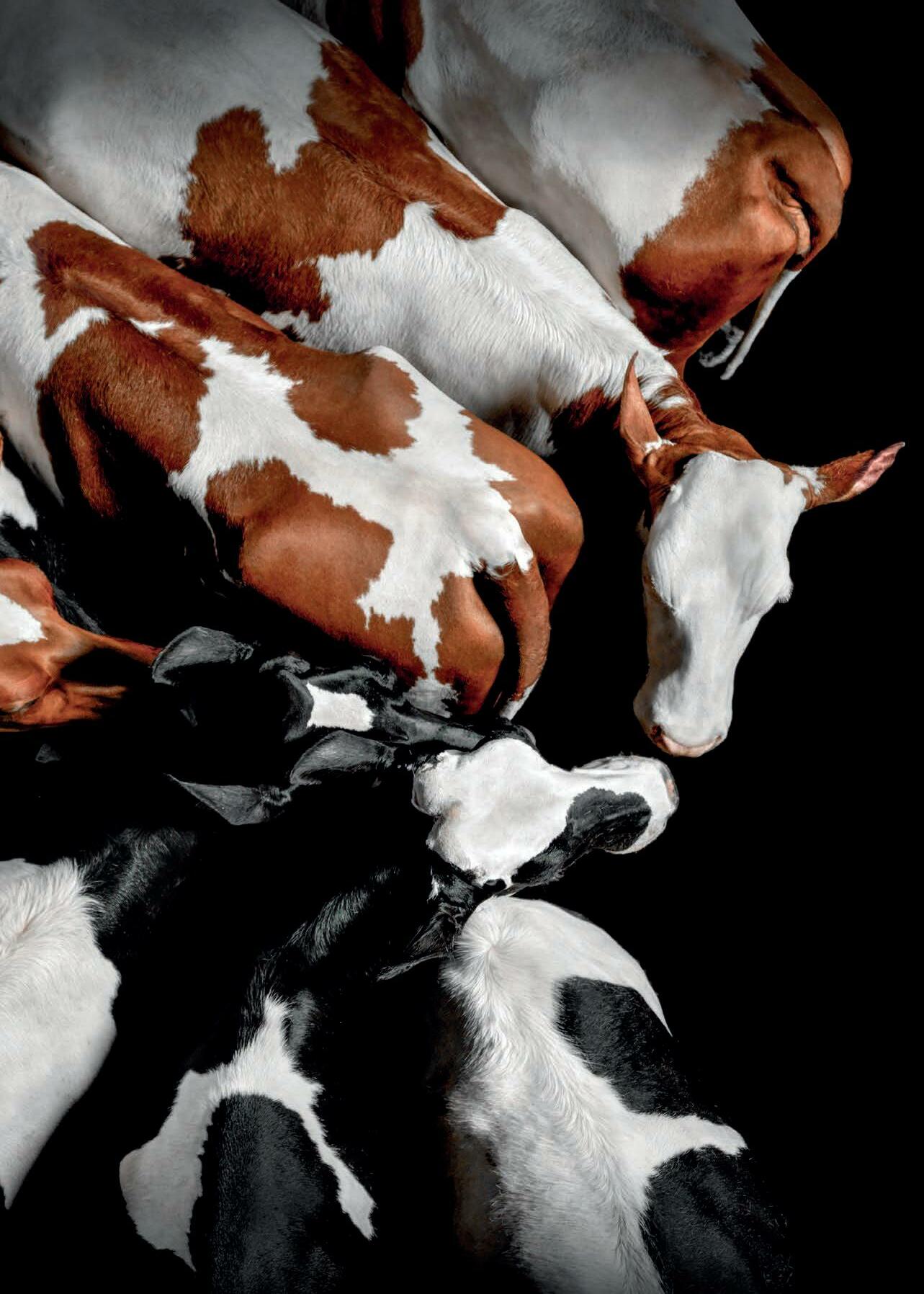
whole herd approach for
Dairy farmer Andy
Venables farms in partnership with his family, milking 330 cows in Cheshire, selling milk on a Co-op contract. He is also managing director of Hillsgreen, a marketing agency dedicated to agriculture with many high-profile clients, including NFU and Cereals.

We are well aware of the e ects the current nancial situation is having on our dairy farming businesses and, therefore, the impact it is having on our buying decisions.
In ation in food prices is now hi ing consumer pockets and with the crisis in Ukraine starting to make our Government realise the bene ts of domestic food production, we as an agricultural industry have an opportunity to connect be er with consumers and in uence their buying decisions.
In recent years, we have been doing more to tell our story and get closer to the consumer with initiatives such as Open Farm Sunday growing in popularity and farmers-turned-YouTubers, such as Tom Pemberton, gaining large audiences online. However, collectively, there is so much more to do.
Alternative and plant-based food and drink brands are be er at this than us and it contributes to the cat egory’s ever-increasing popularity.
We can’t just assume that British consumers understand the nutritional bene ts of buying dairy and the bene ts of a lower carbon footprint through buying British; we need to tell them.
ere are many misconceptions around farming too, such as those around its environmental impact, that we must educate the wider world on. If we don’t, it’ll damage the industry’s reputation.
All of this is why it’s so important that we start to share more about what we do. Not only will it educate people, but it will encourage more people into the sector, helping diversify our workforce and it can open up another revenue stream for farmers.
If you’re connecting with consumers, you can also sell to them. Selling direct for some farmers could help to provide the additional revenue stream needed to plug the gap due to the reduction in Basic Payments.
A cultural shi in how consumers shop can be used massively to our advantage. People now want to ‘shop small’ and endeavour to support local and independent businesses.
Vital
Farms should be a vital retailer in local communities. People can buy fresh as well as supporting hyper-local economic growth. Not travelling as far to shops will also result in less CO2 emissions from vehicles as we shorten the supply chain.
e demands of consumers when it comes to online grocery shopping are high too. ey want choice, good quality, good price and good customer service. Whether they’re buying from Amazon, Uber Eats, Tesco or their local milkman or veg box supplier, the expectations are the same, but local, friendly, face-to-face contact is always going to rank more highly when it comes to customer service. While the variety, quality and price of products can be in your full control.
Back in 2019, I looked to utilise online channels and launched the ‘Mission 4 Milk’ campaign, which aimed to dispel the myth of ‘full fat milk’ and raise awareness of the health bene ts of milk.
Andy Venablesis campaign started on social media and soon gained traction o ine too, with many farmers pu ing up roadside banners. is was a small self-funded cam paign, but it showed the opportunity to raise awareness with the consumer. So, while the bene ts of connecting with the consumer are clear, how to go about doing it can be overwhelming.
Whether you are looking to build your own brand and sell direct to consumers, wanting to promote agriculture via social media, or wanting to execute a national campaign which promotes your industry, it can be daunting. ese are the reasons why we have launched Mission.AG for farmers. Mission.AG will o er free marketing education resources developed speci cally for agriculture.
We need to upskill our sector in digital marketing, then the concept of connecting with consumers via digital channels will not be as intimidating. ere are many ways to e ciently and cost-e ectively build a relationship with consumers, particularly by utilising digital methods.
We are building a positive community of likeminded farmers with a forum where you can share marketing best practice, ideas, industry knowledge and experience, as well as ask questions and learn from others.

Over time, we then see the opportunity to work with our community to launch national consumer marketing campaigns.
If you need inspiration or are questioning the importance of direct-to-consumer relations, then think about industries such as insurance, travel, fashion and ultimately, a lot of non-fast moving consumer goods retail.
ey utilise technology and digital platforms very well. For some of these, consumer sales are only a small part of their business, such as insurers or banks, which sell their product through brokers.
However, they have still built a consumer-facing brand and engage with consumers because it builds brand recognition and trust, which means we are more likely to buy from them, even if it is indirectly.
is is our industry and we have a real opportunity to make a di erence to our future, but I strongly believe the biggest di erence will come if the consumer is be er informed and makes buying decisions based on the bene ts to the British farmer.




rFor more information, visit mission.ag


The abomasum is nor mally suspended in the omentum, or adipose tissue layer, on the right side of the abdomen
and in a low position inside the last rib, says Brendan John, of Somer set-based Evolution Farm Vets.
He says: “In most cases, a displaced abomasum will slide to the le of the abdomen and come to rest between the rumen and the body wall as an LDA. is means that food and gas cannot move out of the abomasum and it will subse quently swell with gas, trapping it in the wrong place.”
Cows respond to an LDA with a range of severity of clinical signs and the disorder can be di cult to spot, because the full range may not be present in every case, he says.
“An a ected cow may have decreased appetite and depressed milk yield, with rumination absent or in decline. It may lose body condi tion and the dung can become loose, while a veterinary examination will reveal an increased heart rate.
“One classic nding is for the vet to hear a high-pitched sound through the stethoscope when the abdomen is ‘ icked’. Overall, the
Abomasal disorders are an all too common problem in high-yielding adult dairy cows, with left-displacement of the abomasum (LDA) the most frequently reported. Wendy Short reports.
signs are similar to those associated with acetonaemia/ketosis.”
Abomasal displacement occurs when there is poor muscle tone in the abomasum and above-average gas production. A number of factors can reduce muscle tone, with low blood calcium being one of the most frequently observed. However there are several other causes, he says.
“In a pregnant female, the abom asum can be displaced as the foetus grows. Post-calving, it will generally slide back into place, but if it does not rectify itself, it can lead to an LDA.
“Feeding high levels of rapidly fermentable concentrate feed, which is associated with acidosis, is also believed to have an association with LDA.
“ e abomasal lining can be dam
aged due to the ingestion of sand or gravel, while pregnancy-linked stress or metabolic disease, particularly hypocalcaemia, will reduce alimen tary system motility and increase risk.
“Systemic diseases associated with toxaemia, such as metritis, can also trigger LDA, along with inad equate long- bre dietary roughage.”
Research into genetic links for LDA has focused on predispos ition to low abomasal muscle tone. High-yielders are thought to be at greatest risk, particularly in early lactation, due to the high levels of calcium being diverted to the milk.
Any fresh calver should be monitored, as this is the point when the abdominal space is at its greatest.
JThe graph shows the onset of LDA and recovery post-surgical correction, taken from robot milking data.
The green line plots rumination minutes per day. A target value is about 600 minutes/day, although this varies between individuals.
The line shows post-calving rumination climbing to 600 minutes, followed by three periods of poor rumination over the first fortnight.
The squares indicate times when the robot alerts to this cow; they occur frequently, especially between days 10-15.
At the same time, milk yield (black line) dips, with the robot alerting to insufficient yield four times. The cow was identified by the farmer as having an LDA on the evening of day 14
However, an LDA can occur at any time, especially in late winter and early spring, when ca le are housed.
As with most disorders, early diagnosis will increase the chance of a favourable prognosis, he says. Faced with an LDA case, the vet has recourse to two main treatment options: non-surgical and surgical.
Mr John says: “Non-surgical inter vention has variable success rates.
e cow can be cast on to its right side and rolled, in an a empt to move the abomasum back into the correct position. e animal will need to be re-examined two days later, because the recurrence rate is high, at about 75%. In addition, a chronic LDA case can lead on to problems including ulceration, reduced milk yield and adhesions in the abdominal cavity.
and the cow had an operation on day 15. Rumination and yield recovered rapidly, as expected in uncomplicated LDA cases.
“ e other non-surgical but invasive technique is the use of toggles, which are suture materials with plastic or metal pieces at the end to form an ‘H’ shape.
“One end of each toggle is inserted into the abomasum using a large, needle-type device and the two are tied externally. is provides an anchor point to keep the abomasum in place. e method will reduce the chance of recurrence, but full recovery is by no means guaranteed.”
In his experience, surgical methods of treating LDAs are usually the best option for saving the cow. e standard operation involves making an incision in the abomasal wall and stitching the abomasum to the body wall muscles to prevent further movement.
Mr John says: “ ere are several techniques to choose from if surgical treatment is chosen. e incision can be made on either the right ank, the le and right ank simultaneously or to the right side of the midline with the cow lying on its back.
“ e right ank or paramedian, beside the midline, approaches are most o en favoured by vets, although no one method stands out as being signi cantly more e ective compared






with the others. Some practices have started o ering keyhole surgery for LDA treatment, but in my opinion it is unlikely to become commonplace. e technique has pros and cons, compared with standard surgical correction.
“We all recognise the lower infection risk with the small access holes needed for keyhole surgery. Nevertheless, the paramedian, non-surgical approach is already minimally invasive; the incision is only the width of a hand and the wound is le open for less than 10 minutes. is curtails the chance of the post-operative infection.

“ e equipment required for the keyhole technique is expensive and a practice may choose to buy only one set. is would need to be collected and returned to headquarters for sterilisation before and a er each surgery. In a practice which has multiple vets working on farms up to an hour from the centre, this would waste valuable time.”
e national average for cases of LDA in the dairy herd is estimated at 2%, says Mr John.
“ is gure sounds relatively low, but in terms of the total cow population, it means a fairly high number of individuals will be diagnosed with an LDA. Where we have been working on prevention, we have reduced average incidence to well below 1% of the herd, but this still means large farms are likely to see several cases a year.
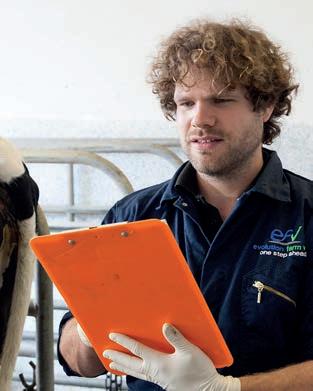

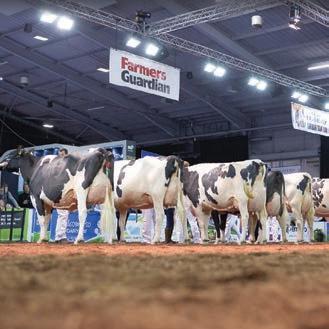
“One case is too many and, as an industry, we must work to minimise health disorders in general. In my opinion, good transition management is key and milk producers are recognising that a ention to detail during this period will pay dividends on herd health in the long-term.”
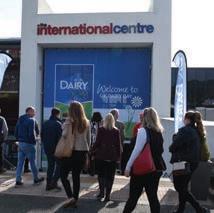

Holstein sire Geno source Captain has held the number one position he regained earlier this year in the young genomic sire ranking, pub lished in August by AHDB Dairy.

He a rms his place by smashing the £1,000 barrier for Pro table Lifetime Index (£PLI), achieving a comfortable lead over two of his sons, which join their sire to take the top three places.
High production Captain im proves his £PLI to £1,014, thanks to small improvements across the board, most notably for Calf Sur vival (CS).
With a CS of 5.8, thanks to the addition of new UK data, he becomes one of the breed leaders for this trait. His index of 4.9 for EnviroCow also tops the breed for green credentials, aided by excellent transmission of feed conversion e ciency (Feed Advantage 257).
e Captain son (out of a Redrock dam) in second place is the new entry, DG Peace (£PLI £962), whose transmi ing pa ern is similar to that of his sire, with high Predicted Transmi ing Abilities for milk (1,025kg) and protein (41kg).
Moving up the ranking to third place is Cogent Koepon Rocky (£PLI £959), a UK-bred Captain
son from a Kenobi dam. Each of the top three sires score well for resist ance to digital dermatitis, helping them achieve above average scores for Lameness Advantage.
e next six places are taken by new entrants since the previously published genetic evaluations in April, and leading the pack is De novo 17835 Lennon-P.
is Mendel son transmits high daughter Lifespan Index (+162 days) and strong daughter Fertility Index (FI 13.6), helping to earn him one of the highest indexes for HealthyCow, at 315.
In h position, Peak AltaSeverus (by Peak AltaPlinko) is another high fertility bull (FI 15.3) with strong lifespan (LS 156) who is also predicted to transmit shorter than average gestation length at -3 days.
Sixth placed CherryPenCol HighCloud (by Peak AltaZazzle) is a high fat transmi er (54.2kg) with a very favourable Lameness Advantage of 3.7, while seventh and eighth position are taken by two full brothers – Pine-Tree Denovo Aleo (£PLI £946) and Pine-Tree Denovo Avon (£PLI £922).
Both are by Aladdin out of the same Legacy dam and o er very high fat transmission for both
weight (56.7kg and 59.6kg fat) and percentage (0.34% and 0.37%, respectively).
is revised ranking gives Holstein producers plenty of scope to add new sires to their breeding strategy, with the usual caution advised to ensure there is a divergence of bloodlines chosen among so many previously unknown names.
Marco Winters, head of animal genetics for AHDB, says: “It is par ticularly important to take steps to ensure genetic diversity as so many previously unknown sires enter the market and it is no longer realistic for most to memorise each of their pedigrees.
“We would strongly recommend
the use of a computer breeding program, such as our own Inbreed ing Checker included in AHDB’s Herd Genetic Report.
“ is will ensure a proposed mat ing does not narrow bloodlines un duly but with this proviso – and the need to spread risk by using a team of young sires rather than focusing heavily on individuals – there is a wealth of genetic improvement to be made from these high £PLI sires.
“All of the leading group and many more have exceptional health, environmental and e ciency credentials, all of which will help breeders improve the welfare, sustainability and pro tability of their herds.”




Anew frontrunner has emerged in the daughter-proven sire ranking. Bomaz Monument-P takes this position for the rst time, as the in uence of his early daughters milk ing outside the UK begins to be felt. ese help earn this polled ABS Medley son a Pro table Lifetime Index (£PLI) of £785, along with high Predicted Transmi ing Abilities (PTAs) for fat (43.9kg and +0.22%), daughter Lifespan (LS +134 days) and Calf Survival (CS +3).
Monument-P also has the best EnviroCow index of any proven sire at 3.8. is means that thanks largely to his ability to transmit high milk solids, with strong lifespan and im proved feed conversion e ciency, his daughters are predicted to create fewer greenhouse gas emissions in their lifetimes for each kilogram of solids-corrected milk they produce. e next three places are all occu pied by sons of the popular mating sire DG Charley, who now has a total of four sons in the top 10. e rst of these is Denovo 14566 Crosby, the former frontrunner from the April run of genetic evaluations. Now in second place with a £PLI of £737, his index features strong udder health (Somatic Cell Count -25 and Mastitis -3), with breed-leading Calf Survival (CS 6.1).
Moving up to third position is Hurt genlea Richard Charl, with a £PLI of £730. This high milk bull (PTA milk, 966kg) also features a very favourable
Maintenance Index of -16. New in fourth place is Neal, the best Feed Advantage bull in the rankings with a score of 197. Neal also features a good genetic index for digital dermatitis, at 0.7, which helps earn him the best Lameness Advantage in the top 20 at 3.5. e familiar name of Westcoast Yamaska appears in equal h position, his 1,183 UK daughters milking in 223 herds helping to earn him a £PLI of £723.
He shares this position with Riethil Summerlake, who features the best udder health data in the top 20 (SCC -30, Mastitis -4) and is the top 10’s fourth son of Charley.
Topstone is a new entry in sev
enth position, with a £PLI of £722. A son of Bomaz AltaTopshot (who incidentally still ranks in the top 20 himself, with 1,757 UK daughters), Topstone transmits long daughter lifespans (LS +165 days) and a short Gestation Length (-4).
Eighth and ninth places are held by bulls which were also high- iers in the previous index run. Both sired by De-Su 13050 Spectre and both o ering outstanding fat transmis sion, the rst is ABS Zebedee (PTA fat 49.6kg), with a £PLI of £706, ahead of ABS Crimson.
With even higher milk solids, Crimson weighs in with PTAs of 50.9kg fat and 33.2kg protein and a £PLI of £703.
e highest daughter fertility bull of the top 20 is UK-bred Stowey Magician. He rounds o the top 10 with a Fertility Index of +16.6 and a £PLI of £700.
Marco Winters, head of ani mal genetics for AHDB Dairy, says: “Sires in the daughter-proven top 10 ranking come with £PLI reliabilities ranging from 70% to 97%, o ering the highest level of predictability in their breeding per formance. is provides reassurance for producers who prefer to use tried and tested bloodlines, which they may choose to mix with a team of high £PLI young genomic sires to make the greatest genetic gains.”

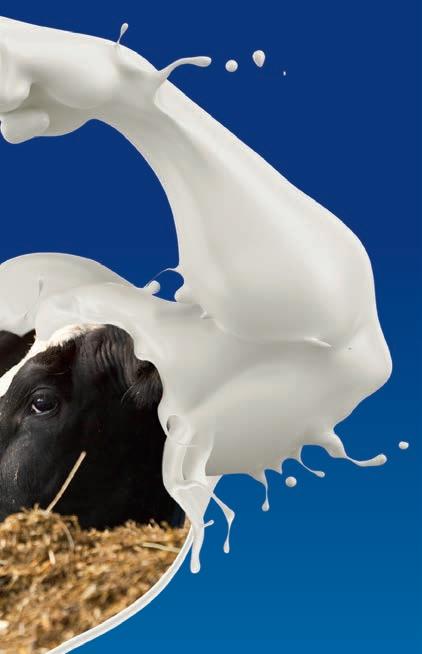
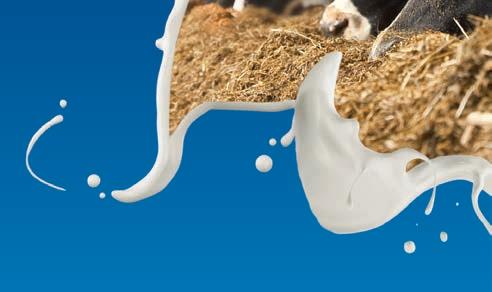

The daughter fertility improver Catlane Caleb maintains his long-held lead in the British Fries ian ranking on Pro t able Lifetime Index (£PLI), with a slight increase in his £PLI.
Now at £PLI £373, he also
o ers high milk components with Predicted Transmi ing Abilities of 0.26% fat and 0.16% protein. His daughter Fertility Index (FI) is 12.1 on the Fries ian breed scale.
Retaining his second place is Inch Persistent (£PLI £352), the highest type transmi er of the breed, with a Type Merit (TM) of 2.32. He combines this with a good index for HealthyCow at 255.
A daughter of Rivervalley Cece Chrome, the leading Jersey sire, ranked on £PLI.

Stability at the top of the Jersey rankings sees the high milk volume River Valley Cece Chrome hold on to the top spot with a £PLI of £478. His 493 UK daughters con rm his
production, while he also has the highest TM of the top ve bulls at 2.1.
In second place is VJ Ravning gaard Huus Hamlet (£PLI £447). High daughter fertility (FI 11.7) and the transmission of good overall health earns him a HealthyCow index of 213. e Ayshire rankings show no change in the top three places, with VR Alatalon Flame Feton retaining the number one position. rFor other breed indexes, visit ahdb.org.uk/knowledge-library/ dairy-breeding-and-genetics
Producers calving in a block this autumn and now turning their attention to sire selection will find the Autumn Calving Index (£ACI) highlights sires most suited to their needs.
At the top of this ranking is Bomaz Monument-P, who makes his debut as a proven sire.
Also leading in the separate Profitable Lifetime Index (£PLI) ranking for year-round calving herds, he shows what a strong contender he is across a range of UK farming systems. In particular, he offers high milk fat, long daughter lifespans
and good calf survival, all of which are requirements of any successful dairy enterprise. Monument-P’s £ACI of £661 is 15 points ahead of second placed Progenesis Wimbledon (£ACI £646) who is also the leader in this month’s Spring Calving Index (£SCI) ranking.
In third place is the UK-bred Holstein, Boghill Glamour Persuade (£ACI £637).
With 10 milking daughters contributing to his index, he just qualifies for these daughterproven rankings on early data.
Following Progenesis Wimbledon in the £SCI rankings is the previous Jersey
frontrunner, VJ Ravninggaard Huus Hamlet (£SCI £548).
Moving up to take third place is another Jersey in the shape
of VJ Groenbjerg Lobo Lobster. His £SCI of £542 reflects his daughters’ high milk solids and good lifespans.
ve way to maximise home-grown feed and ensure ca le have a nutri ous ra on.


There was a clear choice this year, infl uenced by fuel and fer lizer prices. You could take fewer but bulkier cuts or opt for a mul -cut system. Whatever your approach, the hot weather has held back grass growth leaving forage stocks lower than normal years.
As the winter of 2021 was mild, the growing period was prolonged, so 2022 silages are higher in fi brous overwintered material. This promotes rumen health but is less readily diges ble for the cow.
As the energy content is lower than previous years (reported by Trouw Nutri on GB), a balance of rapidly fermentable carbohydrates and proteins is needed to support milk produc on.
The benefi ts of adding Sedagold Syrup to dry forages Hot weather means drier forages, which are less palatable. Adding a liquid feed like Sedagold Syrup to hay or haylage is an easy way to

encourage intake, “A er speaking to Duynie, I realized that I could extend my forage stocks by mixing Seda Syrup with available straw to make a nutri ous feed.” (Duynie Customer)
Not only is the syrup high in protein and energy, but it also reduces dust, binds in smaller mineral-rich par cles, and prevents selec ve feeding by coa ng the ra on. As Sedagold counteracts high lignin values, it improves the diges bility of the feed as a whole and makes nutrients more available.


















Jersey breeder Holger Hedelund Poulsen is aiming to build a sustainable and self-sufficient business against a backdrop of a changing dairy industry. Chris McCullough finds out more.
Selling pedigree Jersey heifers overseas has proven to be good business adding extra value to a Danish dairy farmer’s milk income.
Holger Hedelund Poulsen sells about 20 of his replacement Jersey heifers in-calf each year to farmers mostly in the Netherlands and Germany.
Along with his wife Karen, Holger runs 190 pedigree Jersey cows plus followers and calves at their Ejer Mollegard farm situated in Ejer Bavnehoj, the highest point in Denmark at 170 metres above sea level.
Even now at 72 years old and with no dedicated succession plan for the farm, Holger shows
no signs of slowing down his milk production. In fact, he talks about continued investment into the farm and his cows.
Back in 1972 when Holger took over the farm it only had 15 hectares (37 acres) and 17 cows, but today it has expanded to 270ha (667 acres), of which 125ha (309 acres) are leased.
Back then there were about 100 dairy farms in the area, but today, in trends replicated all over the world, those dairy farm numbers have fallen to just two, albeit with increased cow numbers.

For the past 14 years, three DeLaval robots have milked the cows on Holger’s farm, with annual average yields standing at 11,000kg.
With labour availability a constant issue on Danish farms the robots have proved their worth year a er year, milking the cows an average 2.95 times per day.
Meanwhile, Holger and one worker supplies all the labour required on the farm with a parttime assistant dra ed in when necessary during the busier periods.
Holger runs a speci c breeding programme on the farm which also sees him export heifers to other parts of Europe.
“I use sexed semen from Viking Genetics on the Jersey heifers to produce my replacement stock,” says Holger.
“Half of my replacement heifers,
about 20, are exported for breeding each year and I keep the other half.
“We also use sexed male semen from Aberdeen-Angus bulls on some of the older cows.

“ ese calves are sold at about eight to 10 weeks old.”
He says there is ‘strong demand’ from other farmers for his heifers.
He adds: “Normally, I sell them, robot-ready, at 1.5 years old in calf for about €1,500 each to customers in e Netherlands and Germany.”
Over the years Holger has pushed to become more self-sucient in terms of his feed requirements for the herd, saving money on costs which has been a real bene t these past few months.
Since starting to farm more than 60 years ago, Holger says he has aimed to make his business more sustainable and reducing his reliance on feed and protein imports was very much part of his plan.

Today, he grows more than 80% of the feed requirements for his herd on the home farm, greatly reducing the carbon footprint in the process.
Crops such as maize, grass, barley, wheat, rye, rapeseed and fava beans are grown on the farm with around half of it sold to other farmers.
“We make four cuts of silage each year,” says Holger.
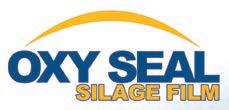


“Plus we grow a range of other crops to feed the cows. Right now we are about 80% self-su cient in terms of our feed production.
“We still have to buy in some protein but I grow about 66% of what I need in terms of that as well.
“ e rapeseed and fava beans are vital crops for us.
“Both whole and ground
rapeseed and ground beans are included in the diet roughage while grain is mixed on the farm with protein, which we still need to purchase.
“On average our feed costs alone work out at 15 euro cents per kilogramme of feed.”
Holger is a big believer in utilising technology to make his farm and herd even more e cient.
Every piece of data generated
by the milking robots is analysed and acted upon if anything could be improved.
“Farmers can increase their herd yields per working hour by acquiring knowledge and new technology,” he says.
“And that helps to save on costs and increase pro ts.”
Holger is also an in uential voice when it comes to the dairy industry in Denmark. When Arla
rThe herd’s average lifetime yield is 50 tonnes over 4.5 lactations with 0.8 calvings per year
rMilk is sold to Arla and at DKK5 per litre (56ppl)

rThe herd is split into young cows and older cows and is then fed accordingly in the shed and at the robotic milker
rOnly the dry cows and younger stock graze outdoors
launched Kaergarden (which is basically Lurpak bu er mixed with vegetable oil) Holger acknowledged the initiative but was quick to criticise the co-op for using imported soya oil rather than locally produced quality rapeseed oil.
ree weeks later the dairy had taken on board his concerns and the new products were manufactured solely by locally produced oils.
Dairy farms should eliminate chlorine-based products in nal rinses to reduce the risk of chlorate residues in milk products.
e latest advice from the Milking Equipment Association (MEA) states that cleaning and disinfection of milking equipment should avoid or replace the use of chlorine in the nal rinses.
MEA chair John Baines says: “EU Legislation has set a new maximum residue limit for chlorates in milk products to ensure that levels do not exceed 0.1mg/kg.
“Chlorates are breakdown products from chlorine-based chemicals used in milking equipment cleaning and disinfection. e risk of chlorate residues is highest in heavily processed products, especially milk powders and infant formula. e European Food Safety Authority has advised that exposure to chlorates for long periods of time can lead to iodine de ciencies in infants.”
Red Tractor standards state that milking equipment should be le free of chemical residues by implementing a nal rinse with potable (drinking quality) water.
When water is used directly from mains supply, it may not be necessary to use any disinfectant in nal rinses. It is a requirement
rDo not use hypochloritebased disinfectants in the final rinse of parlours and bulk milk tanks
rFollowing disinfection, make sure all milk-contact surfaces are rinsed with clean potable water, for example, direct from mains supply rWhere private water supplies are used, or there are doubts about water quality, use alternatives to hypochlorite such as peracetic acid, which degrades over time and does not leave residues
to add disinfectant to private supply water or where there are doubts about water quality.
In this case, sodium hypochlorite has been the traditional disinfectant added to nal rinses.
Mr Baines says for farms cleaning milking equipment manually, the absence of careful measurement of chemicals may result in unsafe levels of chlorine in nal rinses.
He adds: “Using more chlorine will not necessarily improve the cleanliness of milking equipment.”
With automatic cleaning control systems, correct installation, calibration and maintenance of equipment is paramount to regulate the use of disinfectants.
“Automated equipment should be installed, calibrated and serviced by trained dairy technicians, ideally with a Milking Systems Technician Accreditation (MSTA) to ensure correct concentrations of chemicals are used,” says Mr Baines.

Where chlorine-based dis-
JA new chlorate maximum residue limit (MRL) for liquid milk came into force in June 2020 under EU legislation and applies to the UK post-Brexit.
The MRL for liquid milk (raw or pasteurised) is 0.1mg/kg.
The MRL for foods intended for infants and young children is still set at 0.01mg/kg.
Compliance with MRLs will be checked by the Health and

infectants are used in nal rinses, Mr Baines advises that chlorine-free alternatives such as peracetic acid should be considered.
He says: “ e MEA accepts that the use of chlorine-based products is not prohibited. However, milk buyers expect that farms reduce the risk of chlorate residues by using a peracetic acid in nal rinses, boiling water cleaning, or disinfection.”
Mr Baines says robotic technology has taken the lead on cleaning without chlorine, choosing to use
Safety Executive and some milk processors have already added questions about best practices to reduce residues into their Red Tractor Assurance audits.
Historical advice to disinfect parlour systems and bulk milk tanks with hypochlorite as a final rinse is no longer in line with Red Tractor Assurance standards and industry recommendations.
a boiling water alternative. Acid or alkali is added to the early stage of the cleaning to prevent fat or mineral deposits. Most importantly, the high temperature disinfects equipment surfaces, meaning that no disinfectant is required. is removes the risk of chlorates in milk products.
“While technology has some of the answers, installation, calibration and maintenance of all milking systems should be carried out according to manufacturer’s guidelines, by MSTA-accredited technicians.”



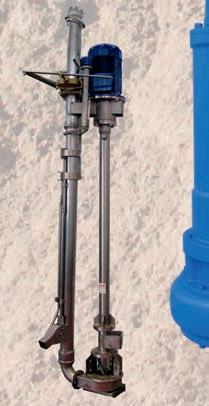





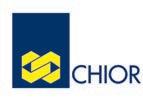











Using min-till to establish a multi-species sward in permanent pasture has rejuvenated leys at a Montgomeryshire organic dairy farm, increasing perennial ryegrass in the sward by 30% and boosting white clover content, too.

e Lloyd family have been farming organically at Gate Farm, Llandyssil, since 2015, in a system that maximises milk production from grass.
eir herd of 170 Friesian Holsteins produces an annual average yield of 6,600 litres per cow, with 4,100 of those litres coming from forage.

Ploughing has traditionally been used in the farm’s reseeding programme, but, keen to trial methods that minimise soil disturbance, third-generation farmer Glenn Lloyd embarked on a Farming Connect focus farm project to investigate how min-till could be used to increase sward diversity in permanent pasture.
Since the farm is organic, a herbicide cannot be used before seeding and the thick thatch at the base of the 30-year-old sward proved a challenge.
Helen Mathieu, of Germinal, who provided technical input into the project, says old permanent pastures bene t from a herbicide treatment because old grassweeds and grasses need to be killed o to allow room for new perennial ryegrass.
In a system when this cannot be applied, Ms Mathieu says it is important to use the right seed drill for the job.
For the Gate Farm project, a Gu ler Greenmaster 300 Tined Seed was used.
Mr Lloyd says it was a ‘tall order’ to overseed permanent pasture with a thick thatch.
“It was a big ask, but it was impressive watching the machine work; it really did rip through the thatch.’’
e eld was overseeded with a mixture of plantain, chicory, red and white clover and perennial
ryegrass at the end of July, when conditions were very dry.
Performance the following spring was impressive, says Mr Lloyd.
“Growth in the spring and late autumn has been exceptional.’’
It had an opening cover of 3,100kg DM/hectare when it was grazed in late February.
Ryegrass content in the eld, which previously had a high proportion of meadow grass, had been boosted by at least 30%. But there had been poor establishment of herbs and legumes – chicory and plantain content was sparse.
“ e herbs have really struggled with the permanent pasture,’’ says Ms Mathieu.
She says overseeding with herbs would be more successful in fouror ve-year-old pasture. e condition of the pasture, the type of drill used and the prevailing weather conditions are all important factors for overseeding, she adds
“If it is really dry mid-summer
and you get good soil-to-seed contact, it is likely to be more successful; herbs and legumes like to be planted in good time, no later than mid-August.’’
Although the results from mintill at Gate Farm had been mixed, Mr Lloyd says the project has given him the con dence to include this technique in his cultivation toolkit going forward.
He says: “It has proved that it is possible, but perhaps the soil needs to be aerated too, to get a be er result.”
Mr Lloyd is also aiming to reduce the farm’s reliance on bought-in feed and, as another Farming Connect project, he grew 4.5ha (11 acres) of brassicas using both conventional and min-till establishment.
He opted for Redstart, a hybrid brassica that grows quickly and vigorously and o ers grazing options from July to around the end of January, depending on sowing date. e crop was grazed with 28 in-calf heifers, each with a daily dry ma er intake requirement of 12kg.
rLand farmed consists of 97 hectares (240 acres) owned and 57ha (141 acres) rented rSoils average 6.5–7 pH and index 3 for P and K rFarm rises from 550-900ft r50% of milk sold to OMSCo and 50% in direct sales through Daisy Bank Dairy r1.3 tonnes of concentrates fed per cow
e crop provided 7kg and round bale silage of 5kg.
Ms Mathieu calculates the conventional crop grew 3t DM/ha at 15-18% protein and 12ME at a cost 4p/kg, and extended the grazing season by 70 days.
Although the conventionally established crop grew well, performance was poor in the section of the eld where the min-till technique had been used to plant the seed into permanent pasture.
“I think this project has shown that conventional cultivation is be er for growing brassicas, as they bene t from having a ne, rm and clean seedbed,’’ says Ms Mathieu.
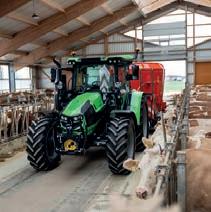





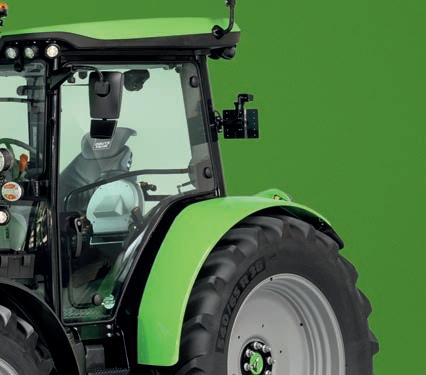






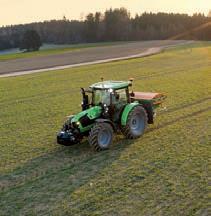
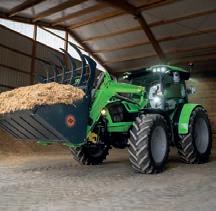
With continued high protein prices this winter a new approach based on increased precision could be the way to tackle costs while improving efficiency. Dairy Farmer reports.
More e cient cows and a re duction in costs per litre requires a rethink in how we satisfy the protein and amino acid requirements of dairy cows, says Dr Sion Richards of Adisseo.

He says protein systems used in ration formulation have evolved over the last 40 years to be er re ect what happens in the rumen, moving from crude protein to digestible protein and most recently to metab olisable protein systems.
While each development increases the precision with which cows’ requirements can be de ned and met, there is still a major aw.
Dr Richards says: “Quite simply, cows do not need protein per se in their diet. What they need is a supply of amino acids which they then syn thesise into the speci c proteins such as milk protein or body protein.”
He explains that all proteins are made up of a combination of 20 amino acids. When protein is fed to the cow, a signi cant proportion of the protein is broken down to nitrogen and amino acids. ese are reconstituted in the rumen into microbial protein, a good source of amino acids. is microbial protein then passes into the hindgut to sup ply amino acids for the cow to use.
Dr Richards adds: “ is is the microbial protein which is the cheapest way to provide protein to the cow, so we want to optimise this. is is done by making sure we drive the rumen by supplying a synchronised balance of energy and protein supply to the rumen
to achieve maximum microbial protein production.”
In the hindgut the microbial protein is joined by bypass protein which is protein that avoided fer mentation in the rumen. Together these are used to meet the cow’s metabolisable protein and amino acids requirements.
“To be e ective, a diet must provide the supply of amino acids the cow requires. As soon as an amino acid becomes limiting, the performance of the cow is a ected, usually by sparing amino acids from functions like the immune system, fertility, or milk protein to maintain production.”
Dr Richards says in most UK
dairy diets, methionine is the rst limiting amino acid with an esti mated 95% of diets being de cient, with lysine being the second limiting amino acid.
“ e usual approach when for mulating diets is to formulate to metabolisable protein and usually to over feed metabolisable protein to try and ensure the cow is sup plied with all the amino acids re quired. e problem is that this is a blunderbuss approach, pushing up protein use and costs and increases nitrogen excretion.”
Dr Richards says a more precise way to meet requirements is to for mulate to amino acid requirement and if required, supplement the diet with rumen protected amino acids.
“A typical UK dairy diet is 17-18% crude protein and this oversupplies metabolisable protein by 8-10% while o en still failing to supply su cient essential amino acids. A typical diet formulated to balance amino acids will be 14-16% crude protein, with a metabolisable oversupply of less than 5% while delivering more closely what the cow requires.”
He observes that the average dairy diet in the EU is already 16% crude protein while diets in the US are closer to 15%. e reason is that there is a bigger uptake in these countries of feeding for speci c amino acid balance. Currently fewer than 5% of the UK dairy herds are fed this way.
“Products are available to allow diets to be formulated to lower total crude protein but with speci c amino acid sup plements to meet requirements more precisely. For example, MetaSmart is a rumen-protected source of methionine.
“Adding 35g/cow of this would improve methionine supply and allow a reduction of 1kg/day of soya in the diet.
“With soya predicted to be well over £450/t this winter, saving 1kg would reduce diet costs by 45p/cow/day. Adding 35g of the rumen-protected source of me thionine will typically cost less than 20pp/day, allowing a reduction in feed costs while feeding the cow be er and helping boost milk price through superior milk quality.”
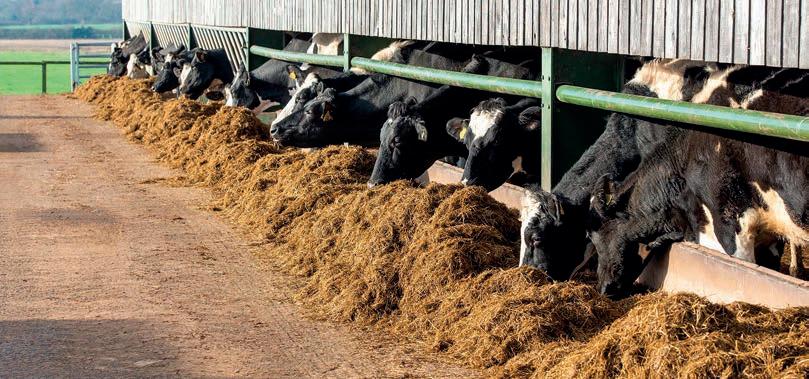
Quite simply, cows do not need protein per se in their diet
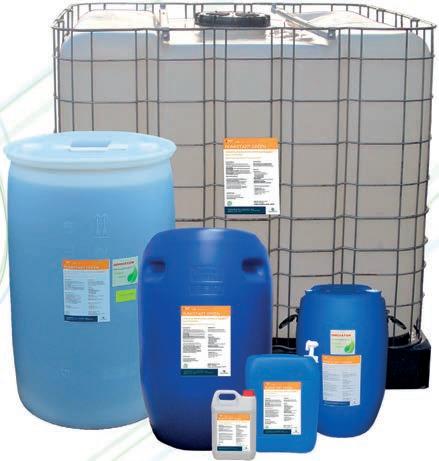
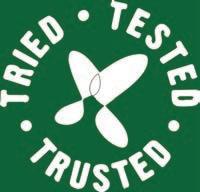
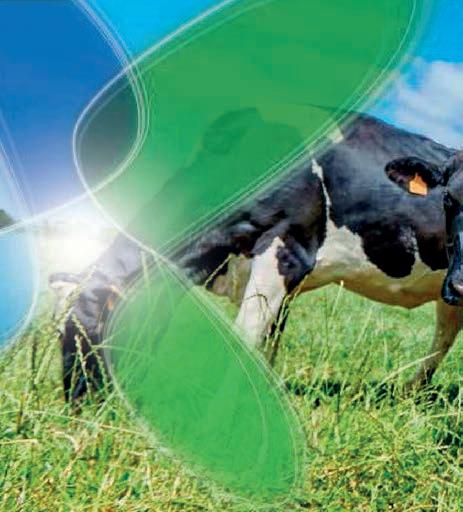

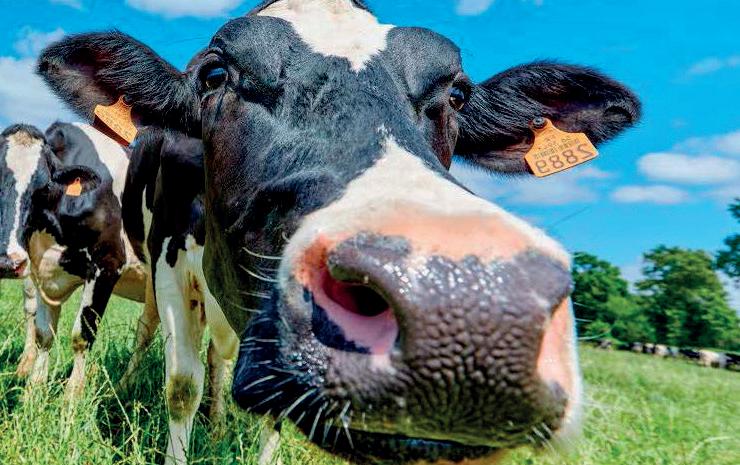








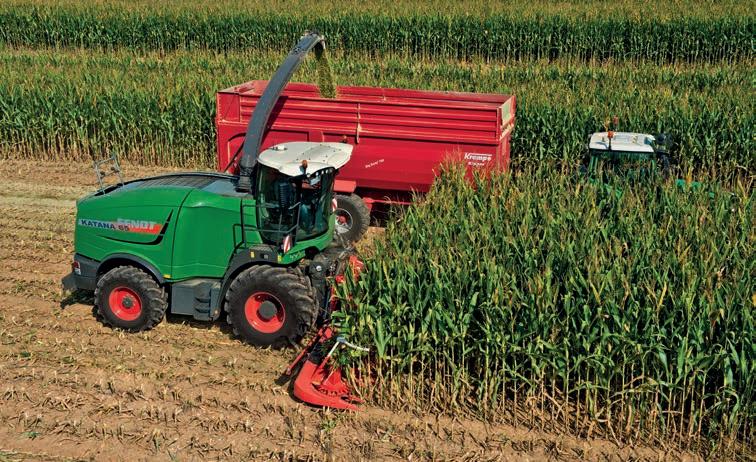
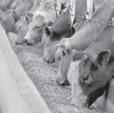
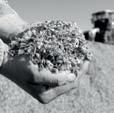 JOHN THOMAS Regional Business Manager Lallemand Animal Nutrition
JOHN THOMAS Regional Business Manager Lallemand Animal Nutrition

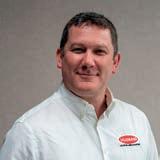
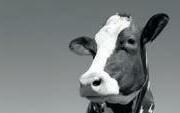
Bought-in feed prices are soaring and this coupled with variable maize yields up and down the country, means that the value of forage in the clamp is going to be higher than ever. That applies to maize just as much as grass silage and it is vital to take steps to preserve its quality and reduce waste, all the way through from harvest to feed-out.
Alongside the use of a silage inoculant, attention to detail at every stage of the process is key to yield the greatest benefits.
Harvest timings will vary hugely across the country depending on time of planting and soil type, and the key is to cut when the crop reaches the correct dry matter –ideally averaging 30-35% for the whole plant.


It’s important to balance the rate of the maize coming in with the weight of the packing tractor to make sure it goes into the clamp in tight, even layers, as the first step for effective fermentation is to remove as much air as possible.
If the clamp is left poorly compacted and spongy, the beneficial microbes cannot start to work as quickly and there is an increased risk of spoilage microbes interfering with fermentation. Good compaction increases the likelihood of a more stable silage during feed-out.
Magniva Platinum Maize, which is formulated specifically for maize, will ensure an optimal fermentation as well as keep the silage stable, reducing dry matter losses and contamination with yeasts and moulds.

An oxygen barrier cling film under the top sheet is really beneficial; the film is drawn down into the undulations left by the tractor wheelings eliminating air pockets and helping to prevent any air moving down into the silage through the winter. Ordinary black plastic sheet is much more porous and allows air in over time. After ensiling, it’s important to keep an eye on the sheet weighting system.
After a few days, the sheet can blow up like a balloon, which is a sign that fermentation is working well, but it can lift up gravel bags so once the sheet has settled you should recheck the gravel bags/tyres. Also remember to keep an eye out for vermin.

If there is brown/orange gas seeping from the silage do not approach the silage until this gas has completely dissipated as it could be nitrogen dioxide which is highly toxic. With the variability in growing conditions seen this year, some maize crops may be particularly susceptible to the formation of silo gas due to drought stress.
All the above factors will combine to help reduce dry matter losses – it is worth comparing the number of tonnes going into the clamp with the tonnes actually fed. The level of ‘shrink’ or wastage will have more of an impact than ever this year.
At feed-out, you should ideally cut to a depth of one metre per week, across the silage face. If that is not possible, then you should still aim to cross the entire face each week, trying to keep up with the oxygen infiltrating the clamp.
If it is taking more than a week, consider taking ½ shear grab depths across the face which will result in a more consistent feed. It is better to have a small, but consistent, amount of loss across the face. Defacers are a good option to help ensure a more consistent feed goes into the mixer wagon.
Feed-out is when the benefits of inoculants really become evident. Magniva Platinum Maize has a unique combination of homofermentative microbes, which produce lactic acid, to drive an efficient fermentation and heterofermentative microbes which produce acetic and propionic acids which are needed for silage stability at feed-out. The microbes change the type of yeast present, and the pH of the silage remains stable even 10 days after exposure to the air, slowing the natural growth of yeasts and making the silage last longer and retain more nutritional value.
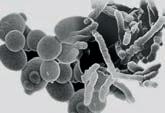









Farmers can reduce the fermentation, feed-out and peripheral aerobic losses by 10% by using a combinationof good management principles and a Magniva Platinumforage inoculant designed for maize.



Taking an example where 1,000 tonnes of 30% DM maize silage is required, we can calculate the potential costs.If the farmer did not treat their silage with an inoculant,they would stand to potentially lose 100 tonnes of silagewhich would have cost £39/tonne to grow, making thesilage that is left to feed £3,900 more expensive.
The financial cost of maize silage waste, both in the clamp and in the ration, can easily run into thousandsof pounds. With feed prices so high and less foragelikely to be available this year, there’s no room for thesestaggering losses.
The key message is to not cut corners with clampmanagement at any stage and maintain close attentionto detail as, once maize starts spoiling, it loses a lot of its energy value quite rapidly.
Cumulative dry matter losses from maize silage betweenclamp filling and feeding can be significant, with theMaize Growers Association providing typical figures in October 2020, shown in table 1.
If the 100 tonne shortfall then had to be made up by buying inmaize silage, it would cost the farm a total of £6,500, assuminga maize silage purchase price of £65/tonne fresh, excludingdelivery, for autumn 2022 (our own forecasted price).
Taking the scenario further, if there is no maize silageavailable and the farmer needed to replace the lost energy and protein by purchasing straights, it would cost£7,083 for the 100 tonnes required. This is based on a maize silage with 30% DM, 11 MJ/kg DM metabolisableenergy and 80g/kg crude protein having a relative feedvalue of £70.83/tonne fresh, compared to barley at aprice of £250/tonne and rapeseed meal at £300/tonne.
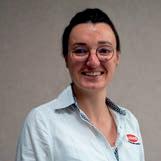


There is a good return on investment for protecting yourmaize silage crop with an inoculant, especially given thecosts involved in growing and storing maize.
Inoculating maize with the Magniva Platinum forage rangewill give a return on investment of at least two to one if onlythe additional growing costs are considered, and this returngoes up to four to one and higher when considering the replacement costs using either maize silage or straights.

Table 1 Maize silage dry matter losses (MGA, Oct 2020)
In short, it takes a very small reduction in waste to pay forthe inoculant, which can be visualised as a shallow layer ofsilage across the clamp. For a 1000-tonne clamp of silage,the cost of treating the crop with a Magniva Platinumforage inoculant, would equate to growing about 43tonnes, just 4% of the total amount of silage with equates toless than a 10cm strip across the entire face of the clamp.
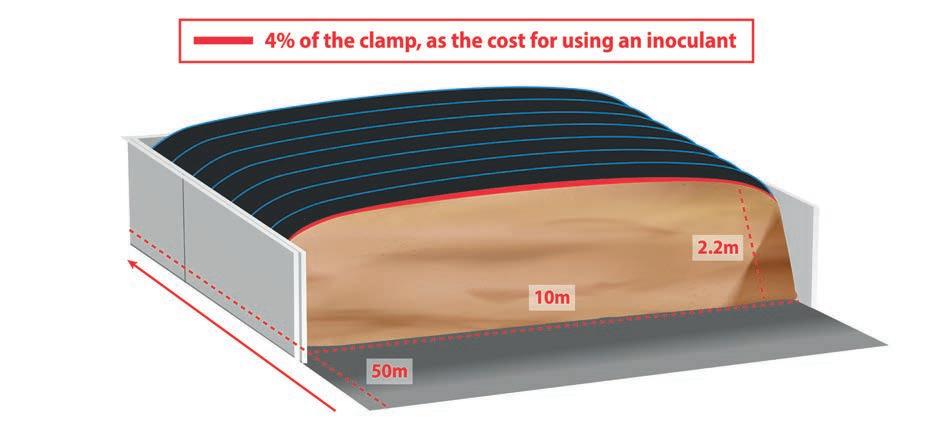




A salmonella infection can be devastating to a dairy herd, as dairy farmer Derek Semmens found when he experienced an outbreak in his calves and milking herd. Dairy Farmer reports.

Farming on the south west Cornish coast, Derek Semmens milks a 210-cow dairy herd, grazed throughout the summer, alongside an arable operation which includes growing cauliower for a well-known retailer.
e cows at Trendrennen Farm, Penzance, are milked through a 14:28 herringbone swing over parlour, averaging about 9,500 litres annually, with the milk sold to Saputo Dairy UK for cheese.
It is a closed herd, with replacement heifers reared on-farm and beef calves sold as stores.
“ e calves were sick in the morning and dead by the a ernoon.
“We thought it was pneumonia, but the post mortem our vet sent o con rmed it was salmonella Dublin. en the cows started aborting – it was a distressing time.”
Salmonella Dublin is the most prevalent strain found in UK dairy herds and has a range of clinical signs, including abortion, which typically occurs between ve and eight months of pregnancy.
“ e infected cows were aborting
about ve or six days a er drying o ,” says Mr Semmens.
“Several cows died a er aborting and milk yields dropped. e calves that recovered from the infection still stand out now, because they are behind on growth.”
e outbreak in the calves was particularly damaging because it happened when Mr Semmens was breeding heifer replacements, meaning that he has fewer heifers coming through in that age group.
Mr Semmens has a good relationship with his vet Ma hew Berriman, who has worked with the farm business for 20 years.
“We have a routine visit every two weeks, which I used to see as a major farm expense, but Ma ’s advice is invaluable.”
“Up until last year I was not really aware of salmonellosis in dairy herds, as I had not experienced it.
“I turned to Ma for advice. He said we needed to vaccinate, alongside implementing other biosecurity measures, so we did that.”
Mr Berriman suspected the disease had been present in the herd for a while, but some trigger prompted the outbreak of clinical disease.
He says: “Ca le that become infected with salmonella Dublin can go on to become carrier animals, shedding the bacteria intermi ently and contaminating the environment around them.
“ ese carrier animals o en do

JFarmers who are concerned about salmonella should work with their vet to establish the risk of disease.
Alongside quarterly bulk milk testing for salmonella
antibodies, this can be done using MSD Animal Health’s new Salmonella Risk Assessment app.
The checklist tool helps vets and farmers to work
not show any symptoms and can be di cult to detect, which is why routine monitoring and biosecurity measures are so important.”
As a closed herd, Mr Semmens’ farm was not exposed to the risk of buying in ca le infected with salmonella. erefore, to control the disease within his herd, his vet recommended a vaccination programme supported by wider biosecurity protocols.
“We went straight into vaccinating all the cows and heifers,” says Mr Semmens, who also vaccinates against BVD, IBR, and leptospirosis.
“ e cows will get an annual booster and the heifers will be done three to four weeks before they calve, to help ensure antibodies are passed via colostrum to the calves.”
together to analyse six key areas and consider a multitude of factors on-farm, from calving hygiene to the threat of infection from other herds.








We asked a range of children aged between four and eight what question they would most like to ask a farmer, and worked with farmers to provide them with the answers in our Ask a farmer video series.


biggest digital campaign, #Farm24, has taken its profile to new heights this year following unprecedented activity across social media and beyond.


Sponsored by Morrisons, farmers and ancillary organisations embraced the event to educate consumers about where their food comes from and what a typical day across the industry can look like. This year’s messaging also highlighted the affordability of local produce as part of the solution to help tackle the cost-of-living crisis.
It took less than two hours before the hashtag was trending at number one on social media, along with our umbrella campaign #FarmingCAN (see panel, right)
joined by a string of celebrities and leading figures including Miranda Hart, Dan Lydiate, Kelvin Fletcher, Phil Vickery and Alexander Armstrong to name but a few, who all wasted no time in dedicating their support and pride towards the role of British farmers and associated communities.


Radio 1’s Greg James raised the awareness stakes when he dedicated a shout out to the campaign after being alerted by one of his contributors, Young Farmer Tom, about how and why the event was taking place.
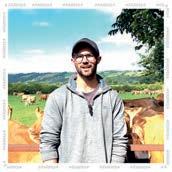

Kicking off at 5am on Thursday, August 4, 2022, 24 Hours in Farming exploded across Twitter, Instagram, Facebook and TikTok as farmers proudly shared posts, videos, pictures, vlogs and hosted a diverse mixture of events to mark the much-loved farming event.
Sophie Throup, head of agriculture, fisheries and sustainable sourcing at Morrisons, said: “What a fantastic 24 Hours in Farming it’s been. Such a range of stories and some really creative posts too bringing the story of farming to customers and citizens - worldwide.”

A host of industry organisations welcomed the chance to tell consumers about what they do, producing engaging videos to share with the British public.
Prime Minister Boris Johnson was

Alongside the promotion of farming and its associated organisations, there was a significant drive for consumers to watch, learn and share key information about how farming contributes to key pillar areas such

as the economy, environment, science, technology, careers and mental health and well-being.
For more information on each of our ambassadors and to read more about the campaign, visit FGinsight.com/farm24
WE teamed up with 12 new ambassadors in a new move for the initiative to share with consumers a snapshot into their everyday
farming lives and how they each have entered and progressed their farming careers, dispelling many myths along the way. Taking to Instagram for a

number of lives throughout the day, thousands of users joined to hear more from about their individual farming journeys.
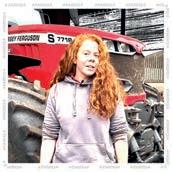
annual event returned to social media for an highlights which soared to record heights.


Farmers Guardian editor Ben Briggs said: “Once again, 24 Hours in Farming showcased the very best of British agriculture and allowed farmers to shout about why they love doing the job they do.
“With huge engagement across multiple social media channels, it showed the wider appetite among the general public to interact with and understand more about what farmers do.
“Buying local and shopping local remains key and is as relevant now as it was at the height of the pandemic and #Farm24 sought to highlight that fact.”


1 Ambassador Paul White joined forces with BBC Radio Lancashire for the duration of 24 hours
2 88-year-old Grandma Norma proudly backing #Farm24 at her grand-daughters dairy farm

3 Young contractor and Clarkson’s Farm Kaleb Cooper called upon his followers to share their #Farm24 stories

The Prince’s Countryside Fund ambassadors Alexander Armstrong, JB Gill, Jimmy Doherty, Phil Vickery and Sally Gunnell all showing their support
Our Ambassador Maria Warne’s Tik Tok and her amazing ‘Granfer’. If you are not following her, you do not know what you are missing
615-year-old Max Robinson, aka the_farm_apprentice, Instagram reel and his poem British Farming A Sport of the Land
7





Exclusive cook-a-long of three of their signature dishes with group head chef at the Hawksmoor Restaurant in support of #Farm24 and buying British produce.
Hawksmoor hosted a cook-along with group head chef.


JOur #FarmingCAN campaign, which launched last year, aims to educate consumers about the key pillars of what farming offers the economy and how it contributes to our social and emotional well-being. This year, as part of #Farm24, we utilised the opportunity to raise awareness about what farmers do through our #FarmingCAN social media channels, which takes place all year round. With interest in food provenance and increased trust in British farmers, local produce, sustainability and the countryside at a record high, there has never been a more prominent time to continue engaging with the public.

FOR a behind the scenes look at the events of the day, you can listen to the latest episode of our
Over the Farm Gate podcast available on all the main podcast platforms.

For Craig Mo at, who farms with his wife Alison, at Kirtle Bank Farm, near Gretna, the installation of two robotic milkers in January this year has meant yields have increased by more than 1,000 litres.

But in a more unusual move, the farm still operates the existing herringbone parlour, with a portion of the herd milked through this each day.
Mr Mo at explains: “I am fourth generation and started working with my father in the late 1990s.
“I remember he put in meters just a er the turn of the millennium and we still use the old herringbone parlour that he installed in 1996 to collect milk for our vending machines.
“By spli ing the herd, we can milk 48 cows through the parlour in an hour and the robots manage the rest.
“It was taking us more than three hours twice a day to milk through the 10/20 herringbone and it was not sustainable.”
e farm has always grazed lower yielding cows, choosing to maintain a traditional grassland system.
“Higher yielders have been kept in and the family built a new shed to house the robots in 2021.
Mr Mo at says: “I think it sends a good message that we

are able to have some of the cows out, but the economics of robot milking, and keeping cows in, is signi cant to the overall sustainability of the farm.”
He says that he is sure yields will increase further as the robot system becomes more established and they make further improvements to diet and breeding.
He adds: “High yielding cows are visiting the robots up to ve times a day which is the main driver for the increased yield.
“It would be impossible for us
rKirtle Bank Farm extends to 124 hectares (330 acres) of owned and rented grassland
rThe Moffat family has a herd of 200 milkers of which 127 have been recently moved to robot milking, with two DeLaval VMS310 robots yielding 11,305 litres per cow each year
rThe family is hosting an open day on September 1, 2022, from 10am to 3pm rMore details on delaval.com
to milk cows at that frequency, but with the robots I am targeting a 13,000 litre per cow average, which would have been inconceivable without the investment in this technology.”
e new shed has improved the air space and cow comfort and is split into two halves with DeLaval VMS310 robot servicing each.
Cow brushes, more cubicles

High yielding cows are visiting the robots up to five times a day CRAIG MOFFATCraig Moffat Cow







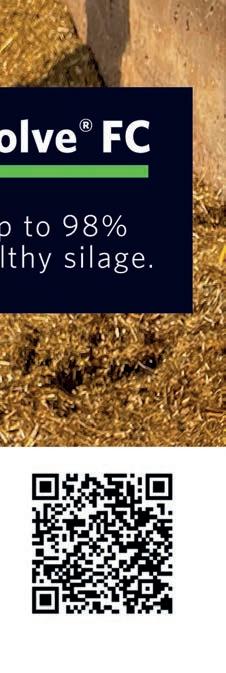


and the ability to milk the cows more o en, has all contributed to cow health and well-being.
SCCs have dropped from 175 to 85 and mastitis cases are as low as two a month, compared to eight to 10 cases a month previously.
Mr Mo at says: “ e drop in SCCs happened almost in stantly.
“ e cows took to the robots so well and a er the rst week of training, we felt we had cracked the new system.
“ e robots also milk so much faster and our box time at the robot is just six minutes.
“ is is be er for the cows and has been a signi cant part of our yield increase.”
Some robot farms have chosen to use a free access sys tem, but Mr Mo at has opted for a guided system.
“We visited a variety of farms with DeLaval robots and we saw how others had chosen to manage their herds.
“I believe the guided system is the best way to maximise the robots because only cows with milking permission can be milked.”
By using a guided system, he has been able to feed less
concentrate at the robots com pared to a conventional free access system.
is encourages the cows to eat a higher energy TMR and re duces costs. On average, a cow passes the selection gate 11.5 times and is only given access 2.8 times a day.
is means the cows are moving around the shed more and early lactation cows can be milked three or more times a day, while later lactation cows can be reduced to just two milkings.

Mr Mo at has taken on the AI and foot trimming for the herd himself and is proud that there are very few cases of lame ness in the herd.
He also explains that before
JAlison Moffat has headed up the farm’s diversification into milk vending machines, with one machine located opposite the farm and the other at the Caledonia Park outlet village.
The farm is happy with how sales have grown from the vending machines and Mrs Moffat sees further growth in the future.
The machines, supplied by Daisy’s Vending, were an
moving the milkers to the new shed, he housed the farm’s heif ers for six weeks in the new shed to lower the pH of the concrete.
“We have had some dermatitis issues, so to mitigate against this and foot issues, I read that con crete can be changed by using slurry to change the pH.”
He has chosen not to use any genomic testing and instead breeds o what he sees as the best of the herd.
He believes strongly in estab lished bloodlines and choosing cows with good feet and legs, well a ached udders and good overall robustness.
“We calve a lot of heifers now because our replacement rate was down to 16%.
“We could choose to grow the
investment of approximately £36,000 each and the family is hoping that they will be a useful income stream for the farm in the future.
Mrs Moffat says: “All the machines sell milk and a selection of flavoured milkshakes. A 375ml milkshake cup retails at £1.50 and a litre is £1.90.
“Whole milk is £1.20 a litre.”
herd to 300 cows quite quickly, but the income from selling heif ers is be er for us at this time.
“We can also be really select ive about the ones we keep.”
He opted to install DeLaval’s Repro, a progesterone testing system that takes daily samples from milk for heat detection.
“We load casse es of sample sticks that the system uses to collect and test milk from each cow individually.
“ e data is fed into the DelPro management system which gives us information about every cow.
“It is more accurate and has made heat detection so much easier.
“We are only ve weeks in to using the system, but I can al ready track cows from service to in-calf more accurately.”
The cows took to the robots so well and after the first week of training, we felt we had cracked the new system
CRAIG MOFFATThe family built a new shed to house the robots in 2021.










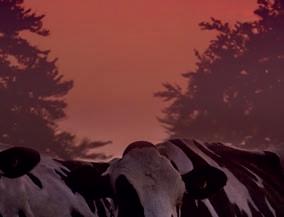



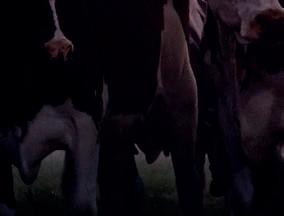

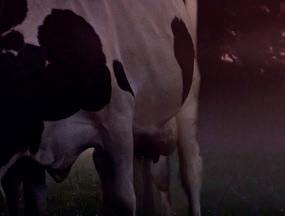















dairy farmer
Lewis
Geo Lewis is the h generation at Pearson Farm, Haverfordwest, which he manages in partnership with his mother Mary and wife Lucy.

As part of an ongoing improvement programme, the family moved from twice-a-day milking to the installation of ve robots in 2019.
He estimates that the new system has increased yields by about 2,000kg/head for his 300-cow fully housed herd, which is registered under the St Brides Holstein pre x. e herd lactation average, including heifers, is 10,900kg, at 4.1% fat and 3.35% protein, with all-year-round calving and milk sold to a local supplier.
Most buildings have been modernised over the years and
Maize has been grown at

taken several measures
the dairy housing includes a set of roomy cubicles, auto-scrapers and LED lighting. e switch was carried out in two stages, prior to the sale of the 20:40 swing-over parlour.

Mr Lewis says: “It was fortunate
that the building design allowed for a straightforward transition to robots. e rst three installations went in while 100 cows carried on being milked through the parlour and the remaining robots were brought in to use in a di erent area a week later.
“Nobody got much sleep that week, but overall the process went smoothly. It took about three weeks for the cows to get used to the routine. We had looked at a number of robotic systems before deciding upon the Fullwood Merlin.
“ e robots have changed the working pa ern, but like all livestock farmers, our job is a 24-hour, seven days-a-week commitment.
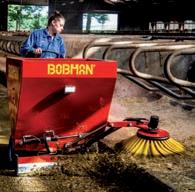

“If there is a problem, we are alerted via our mobile phones and

that can occasionally occur overnight. With a high-yielding herd, we cannot a ord to have a machine out of action for any length of time.”
While the farm no longer requires relief milkers, the sta ng requirement has otherwise remained unchanged, with a herdsman and three full-time employees. One sta member is dedicated to the maintenance of the robots and making sure the cows are being milked e ectively.
Heifers and fresh calvers are kept in an adjacent pen for the week post-calving, so they become accustomed to using the system.
Concentrates are fed to yield in the robots, while the herd’s total mixed ration (TMR) contains a wide range of feedstu s, with maize making up 50% of the forage inclusion, along with grass silage.
Other ingredients include 1kg
of chopped wheat straw, 1kg of molasses, a three-way blend containing soya, rape and sugar beet, plus an omega 3 supplement, yeast and minerals.
Rolled barley is fed separately through an auger bucket at 2kg/ head, to encourage the cows to
leave their cubicles in order to simplify bedding down.
Maize has been grown at Pearson Farm for the past two decades, with 48 hectares (120 acres) allocated to the crop this year.
Mr Lewis says: “ e 2021 maize crop was successful in terms of
both yield and quality and the 2022 acreage has been increased to ensure a 12-month supply. ere was a two-month shortage last year and yields fell by 1.5-2kg/head, along with a dip in fertility which occurred almost immediately. e dung consistency was loose, providing
r
The farm comprises 354 hectares (875 acres) of owned and rented land
r
Most of the soil is a free-draining, fairly fertile red sandstone
r
The aim is to calve heifers at 24 months

r
The calving interval runs at 420 days; the high-yielding cows are not pushed hard for fertility during early lactation

a visual indicator of the importance of maize in the diet. All of these issues were recti ed when maize silage was re-introduced to the ration.”
Mr Lewis has grown KWS Artikus for the past two seasons. It has an FAO, or maturity rating, of 160, which puts it in the ultra-early category. However, the variety has been superseded and KWS Exelon has been sown this year.
Maize silage and the concentrate
blend are omi ed from the TMR until 4pm in winter, because they a ract starlings in large numbers, Mr Lewis says. ey are added once the birds have gone to roost.
He says: “ e Artikus variety yielded 18 tonnes/acre fresh weight and achieved a starch gure of about 33%. As it was very mature, it was not the easiest crop to roll in the clamp. Nevertheless, it would have still been our rst choice for this year, had it been available.
“I am con dent that Exelon will produce similar, or even be er, results. e variety has performed well on my brother-in-law’s farm nearby. It is an early variety, which is important because our harvest deadline is the date when clocks turn back in autumn.
“If maize is cut any later, the soil will not dry out su ciently and there will be a risk of compaction problems with the following crop.
“KWS Exelon has the potential to carry a higher number of grain rings compared with its predecessors and its cobs are positioned
close to the ground to o set the risk of lodging.
“Fields are favourable for maize-growing and I would classify the land as early. e usual planting date is the end of April/beginning of May and although the cold spring of 2021 delayed sowing, the crop managed to catch up.”
e standard rotation is to follow the maize with three- or four-year grass leys, followed by potatoes, then cereals for a couple of years before returning to maize. e soil pH is brought to 6.5 before maize seedbed preparation, which uses the plough and a Teagle multi-disc, one-pass cultivator.
It is followed by a combination power harrow with the drill element removed to produce a ne seedbed which will be sown at a 75cm row width.
In the past, maize seed has been planted to a depth of 5cm, but advice to plant at 7cm last season to establish a secure root was followed and the practice worked well.
DIY arti cial insemination (AI)
from mostly genomic sires is used extensively, with 75% made up of sexed semen. ‘Robot-ready’ bulls are preferred, as they pass on high-scoring udder conformation.

ere is also a Holstein sweeper bull for serving heifers and repeat cows a er three or four AI services.
Sadly, the herd is under TB restrictions and therefore all beef ca le are nished and sold deadweight. British Blue and Aberdeen-Angus AI sires are used on the lower 30% of the herd.


a tightening of Nitrate Vulnerable Zone regulations in Wales.
e next project is to install a larger bulk tank for potential alternate-day milk collection and this will also help to reduce the farm’s carbon footprint, Mr Lewis says. e unit is situated in an isolated location and the additional tank should increase milk marketing exibility.

Mr Lewis has no regrets about switching to robotic milking and feels the family has done as much as nances permit to ‘future-proof ’ the business.

“

e British Blue is an excellent match for our type of Holstein cow for beef calves, but the Aberdeen-Angus is useful for second calvers due to its easy-calving qualities.


“About 80 head are nished each year, achieving pleasing weights on a simple system of grass silage and up to 8kg/head of Maxammon-treated barley.”

A new slurry lagoon was built in 2021, in anticipation of


He says: “We are fully commi ed to milk production and we have invested in modernising our business. e milk price is going in the right direction and I feel we have turned a corner a er a long period in the doldrums.
“However, the price trend will have to continue if we are to absorb the alarming rise in fuel and fertiliser costs the industry has recently been experiencing.”
Reduce crude protein – and boost performance. It’s essential that your dairy cows’ needs for amino acids are met. Methionine is the single most important amino acid for milk production. Including Mepron® mini pellets in your feed mix not only makes your feed more consistent and cost-effective, but also cuts down nitrogen emissions. Use Mepron® for enhanced animal welfare, sustainability and profit.

Kuhn’s launch of the Aura has brought another option for the market of autonomous feeders, however the French machinery giant’s approach to this sector is unique in comparison to its competitive stablemates.


Other designs of autonomous feeding systems successfully rely on a monorail or steel oortrack to control the position of the unit as it navigates around the building, in addition to a dedicated feed kitchen, where
the main ration inputs, straights and liquids are added to the mobile mixing tub. is design is successful at keeping the route and progress of the unit consistent and can utilise an electrically-powered mixer and delivery system – either from ba eries or elec-

A twin-auger 3cu.m mixed tub is posited at the centre of the machine.
trical hook ups, however it does require some infrastructure changes to accommodate the route of the system, and may not easily be adapted or expanded as system demands or building use change. e approach taken by Kuhn uses the manufacturers existing knowledge of self-propelled feeders and has focused on creating a machine which can integrate into an existing system of silos and feed fences without speci c buildings or routing infrastructure being created.
Milling and feeding e Aura is essentially a self-propelled mixer, albeit quite a small one measuring only 2.6 metres high and 1.9m wide, however the combination of repetitive cycles of lling and feeding out, the Aura should be
capable of supplying up to 280 cows.
e design uses a 3cu.m twin vertical auger mixing tub ed with a milling head and conveyor. Positioned at the rear, a discharge conveyor and twin rotary bushes dispense and push-up the feed in one pass. Inside the unit sits a 56hp Stage V Kohler diesel engine and a fuel tank su cient for a weeks’ worth of work, consuming a claimed 3.5-4 litres/hour. A fully electric E-Aura is in development.
All services on the unit are hydraulically-powered and include four-wheel steering and drive to each wheel hidden underneath the body. is gives the machine the capacity of slope climbing of gradients of up to 20%, and
Continues over the page...





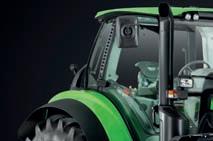
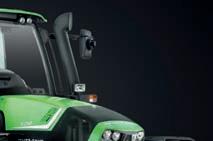





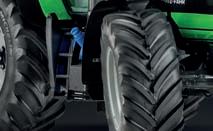
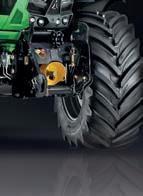

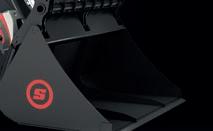















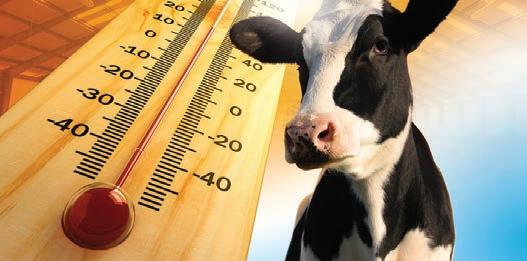
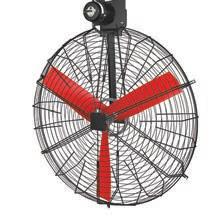

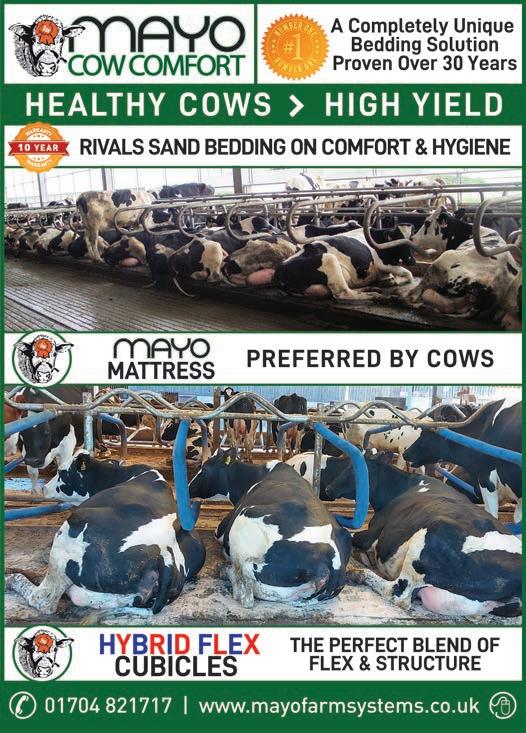
Feeding out uses a conventional cross conveyor and rotating bushes to push the feed up.
allows travel on less than perfect concrete or stabilised hardcore. A maximum forward speed of 7kph is possible when travelling between slio and feed fence, with a maximum feed-out speed of 2kph.
Filling is achieved using a dedicated milling head and conveyor mounted on a sideshi frame. e head can process a range of ensiled products in addition to hay and straw. Conventional load cells are used to measure the intake product.
Surprisingly, the unit is not ed with a metal or foreign object detection system, so considerable care needs to be taken to insure the clamp face is clear from plastic or tyres to prevent some unexpected total mixed ration ingredients. Magnets are positioned in the tub to capture
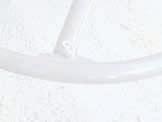

any ferrous anomalies entering the mix.
Baled products require opening out and the string removed before the unit can load them.
e farm used to demonstrate the product had a dedicated straw loading area, where strings were removed and the loose straw bunkered for the vehicle to collect.

Utilising the same building as the straw bunker, the loading of straights from overhead augers is achieved using WiFi-linked switches a ached to each auger motor. When in a de ned position, the Aura requests the motors to start and stop once the correct weight has been delivered.

Feeding out the product is achieved using a conventional hydraulic cross conveyor at
the rear of the unit which can deliver to the le or right of the machine. Feeding takes place in reverse, with the delivery of the ration immediately followed by a rotating nylon bush to push the feed up to the fence.
e volume of feed delivered is calculated by the unit based on the target weight divided by the feed distance. is is claimed to maximise the available feed area for the cows, and deliver a uniform quantity along the complete feed fence. Individual mixes and feed rates can be delivered to di erent buildings, depending on the animals being housed.
Prior to the Aura being delivered, Kuhn will conduct a site survey to determine the layout
and routing of the feeder. A complex network of data connections is established alongside an array of autonomous vehicle warning signs, in conjunction with any structural changes to the yard, however these should be limited. Once this been completed, the responsibility of the machine to operate safely is signed over to the end user
Surrounding the machine are an array of sensors reporting the location and external information interfacing with it. e overall position of the feeder is determined using RTK GPS derived from a dedicated network and connected using two receivers at the rear of the unit. A WiFi network covering the whole working area is used to communicate with the unit and provide information updates,
The clamp face is kept very clean, the Aura returns to the same position to refill as it works across the clamp.
also it allows the Aura to communicate to external control modules.
When working in buildings and to identify any object in close proximity, motion sensors on multiple surfaces detect movement and xed surfaces the machine needs to avoid.
A Lidar system is used to visualise the surroundings. Functioning in a similar method to sonar, Lidar uses light pulses to measure distances and create a vision of the environment surrounding it, nally nudge bars on each side of the machine will


stop the unit if they contact any obstacle.
Real-time data from the Aura is managed through a PC portal which overlays the machine and its route onto a Google-derived map. is gives a visual location and function for the unit and highlights where it has been.
If the feeder encounters any obstructions or errors, it can text multiple mobile devices to alert an operator of an issue, which can either be cleared remotely, or may request a site visit to visually check the problem.
Progress around the farm is
predictably repetitive, with the machine following the same route across the yard. is was particularly noticeable at the demonstration farm, where the unit has been running for nearly 3,700 hours over the last 12 months and le some tell-tale tyre marks on the concrete.

When working against the silage face, the unit will return to the position from where it previously lled. e incredibly precise action of the milling head creates a very clean clamp face, with an obvious step when the machine stopped. A potentially

limiting factor is the maximum operating height of 4m, meaning clamps can be wide, but not high.
e Aura is in its early stages of distribution with two production machines currently working in France. e infrastructure and sta expertise to install and maintain a unit is considerable and as a result Kuhn is being cautious in the expansion of the sales area with machines limited to the French market. As the manufacturers experience grows, so will the market area with the rst units expected in the UK by 2024/2025.
UK Dairy Day returns to the International Centre in Telford on Wednesday, September 14, 2022. Katie Jones takes a look at what visitors can expect to see at the event.
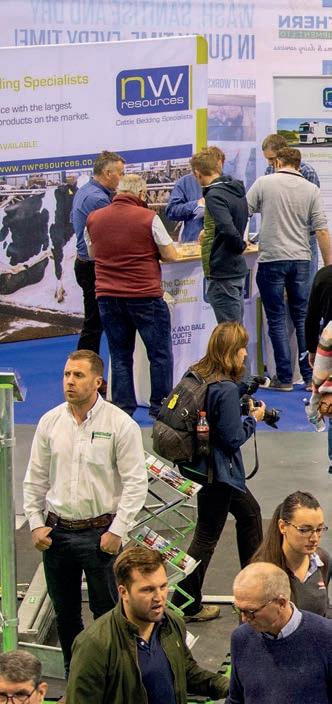
see the
Now in its eighth year, UK Dairy Day provides an opportunity to network,
share knowledge, learn and, importantly, do business.
The event is organised by Holstein UK with support from representatives at The Cattle Information Service, National Bovine Data Centre (NBDC), The International Centre, Stagecraft UK and
J Sadly this year’s UK Dairy Day will be without Holstein UK chief executive and UK Dairy Day event director Sue Cope, who was instrumental in making the event happen year on year since 2014.
Sue sadly passed away in May this year after a short but courageous battle with illness.
In her memory, fundraising will take place at the event for the Brain Tumour Trust.
other key businesses within the industry.
Last year was one of the first events of 2021 to take place following the Covid-19 restrictions, with attendance of more than 7,000 visitors, and this year it is hoped to return to pre-Covid-19 visitor numbers.
The event’s cattle show has established itself as one of the UK’s most prestigious, with breeders from across the UK competing under the spotlights in Telford.
UK Dairy Day will be hosting the established National Holstein Show, along with the National Ayrshire Show and the National Brown Swiss Show.
Classes will run during the morning for Dairy Short horn, Guernsey and Jersey.
The external areas at the International Centre will feature practical dem onstrations on calf anatomy painting, as well as foot trim ming and knife sharpening.
Scarsdale Vets, Derbyshire, will present an innovative and
r
When: Wednesday, September 14, 2022
r
Where: The International Centre, Telford, Shropshire, TF3 4JH
r
Tickets: Entry and car parking is free
rMore details:
ukdairyday.co.uk
engaging demonstration using paint to visualise and understand calf anatomy.
Tim Carter returns with practical demonstrations on foot trimming, blocking and knife sharpening. e quali ed team of independent foot trim mers will demonstrate the key to the success of any task is hav ing the right tools for the job.
The team will also highlight the Cattle Hoof Care Stan dards Board, a self-funding non-profit organisation aimed at improving the health, welfare and mobility of the national herd, by ensuring its members promote, achieve and maintain a recognised and validated standard of cattle hoof care.
Internally by the Hall 3 cattle stalls will be the NBDC Breed Village, where members of the NBDC classification team will run type classification and linear scoring demonstrations for the Ayrshire, Jersey and Holstein breeds.
In conjunction with the linear scoring demonstration, a virtual cow demonstration will run on a TV screen.
Virtual Cow is an educa tional tool which graphically illustrates the linear scale for cow conformation traits.
This allows for an improved understanding of dairy cow conformation and easy visu alisation of anatomical differ ences within each trait across the linear scale.
UK Dairy Day is an accredited event with Dairy Pro for three CPD points and BASIS for two CPD points.


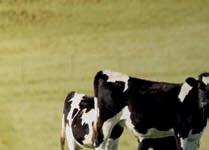





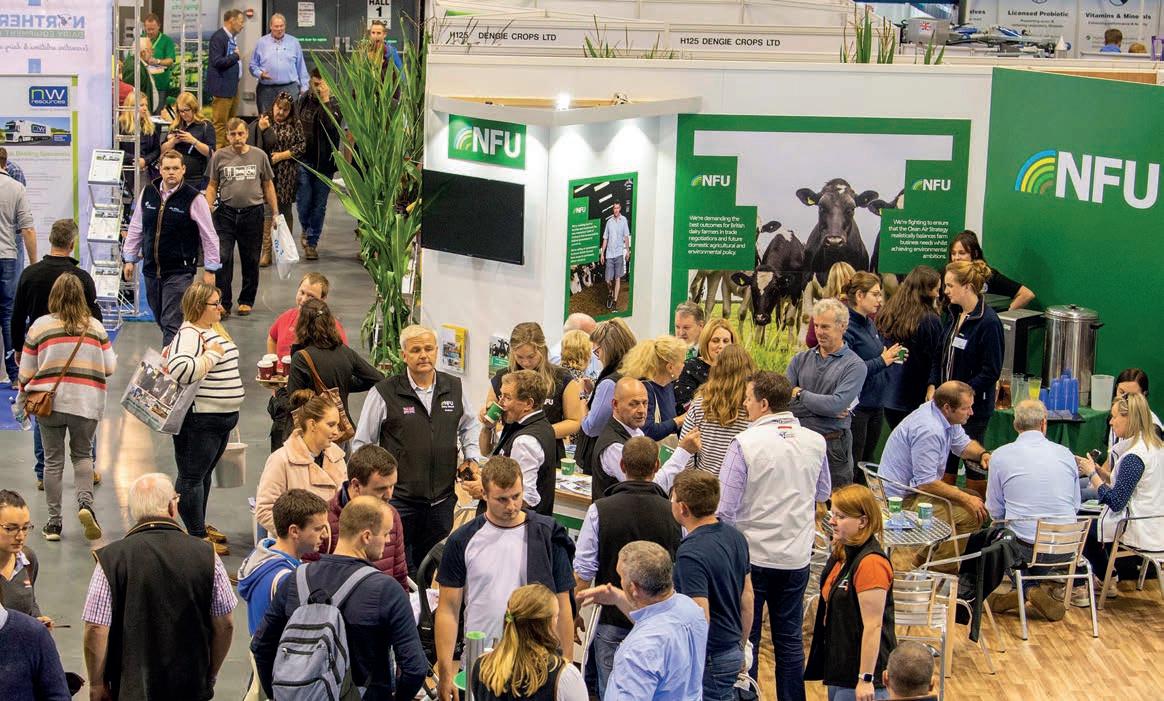

To showcase new products, exhibitors and sponsors have had the opportunity to enter the new product competition.
Entries were for new products launched into the market in the last 12 months between August 1, 2021, and July 31, 2022. e competition looks for the most innovative or in uential new products on the market.
e nalists will be displayed on a counter display in the concourse ahead of being judged by repre sentatives from IDEXX during the morning of UK Dairy Day.
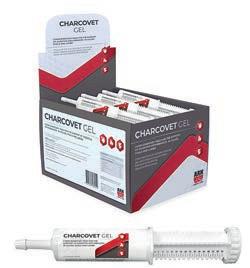
JCharcovet Gel, from Ark Animal Care, contains 30g of activated charcoal in a 60ml syringe. It is an activated charcoal gel that is given as a complementary feed to support recovery from digestive disturbances in calves, foals
JNWF Fusion Pro, from NWF Agriculture, is a highperformance ration that contains high levels of Ultra Pro-R and Ultra Starch W to
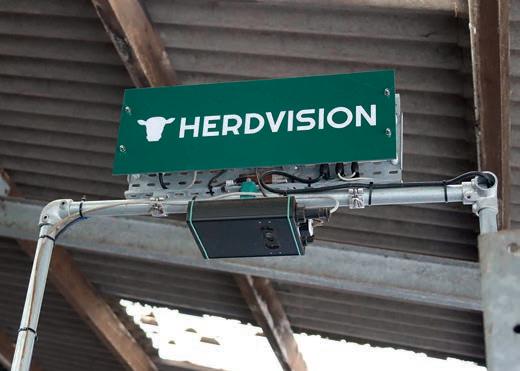
JHerdVision, from Agsenze, is a vision-based system which automatically identifies key health and welfare measures in cattle.
Using 2D and 3D cameras, a dedicated EID reader, computing and cloud-based machine learning, the system records every cow passing under the camera, measures its mobility score and body condition score and reports any changes via an app and web user interface.
rFor more details, visit STAND L29
JOmyaFeedC MgO, from Omya UK, protects herd health by suppressing sub-acute ruminal acidosis. It buffers rumen pH to optimal level with magnesium oxide and provides available calcium and magnesium nutrition.
Trials showed it to be an effective rumen buffer with a low feed rate of 130g/cow/day leaving space in the ration for other materials.
rFor more details, visit STAND L11
and lambs. Activated charcoal is a 100% natural, nonantibacterial, non-medicinal material with well-known abilities to aid a return to normal gut function in many species.
rFor more details, visit STAND F3
ensure high levels of bypass protein and starch to support high performing cows.
rFor more details, visit STAND H217
JFeedAlert, from Collinson, is a low-cost silo monitoring solution for inventory control. Suitable for all makes of silo, FeedAlert is a strain gauge weighing system.
It is non-invasive and can be installed on the leg of the silo in under 30 minutes, making it the perfect solution for existing silos with no need to lift the silo for load cells.
Data is transmitted to the cloud and can be viewed on a display local to the silo, via an App or desktop portal.
Alerts will provide reminders for feed management and users can manage their own data or choose to share it with their feed supplier.
rFor more details, visit STAND H210
JGenomic tested female embryos, from Semex UK, can be tailor-made to fit any dairy herd’s milk contract and genetic plan.
Rather than rely on parent average embryos and test
the resulting progeny, this service means the genomic results are known before a pregnancy exists.
rFor more details, visit STAND H226


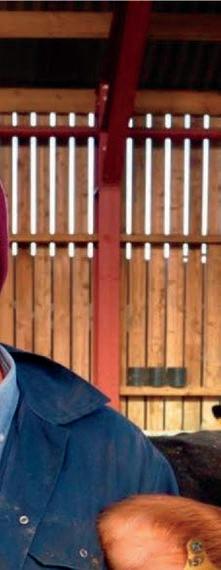


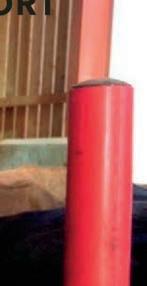


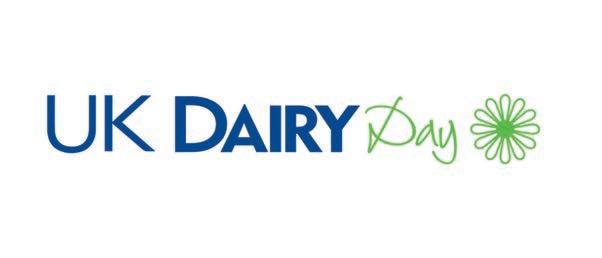
JHeader manufacturer Kemper has launched a grass pick-up specifically designed for Claas Jaguar forage harvesters. The C3003 has a working width of 2.56 metres, with an overall transport width of 3m.
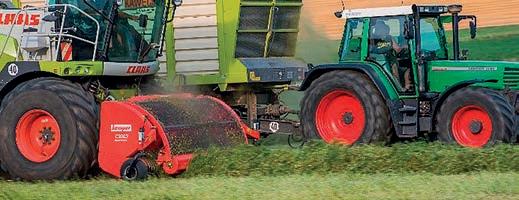
The manufacturer claims the redesigned cross auger is more suited to handling a larger and more varied intake swath. A hydraulic accumulator is used
JRumistart Green, from Kersia, is a fast acting liquid complimentary feed, designed to be given to new calves and their mothers as soon as possible.
It contains a high- quality mix of energy boosting ingredients. All of which help
to support a proportion of the augers weight, allowing for a consistent crop compression.
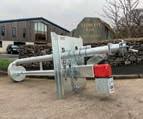
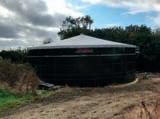

The smaller diameter, four bar pick-up reel is fitted with 40 tines per bar. This combination of diameter and tine position is claimed to offer improvements when collecting short or leafy crops.
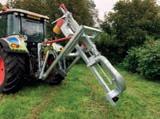
rFor more details, visit STAND E9

JThis transition dry cow feed, from Carrs Billington, has been designed to help promote a smooth transition from one lactation to the next.
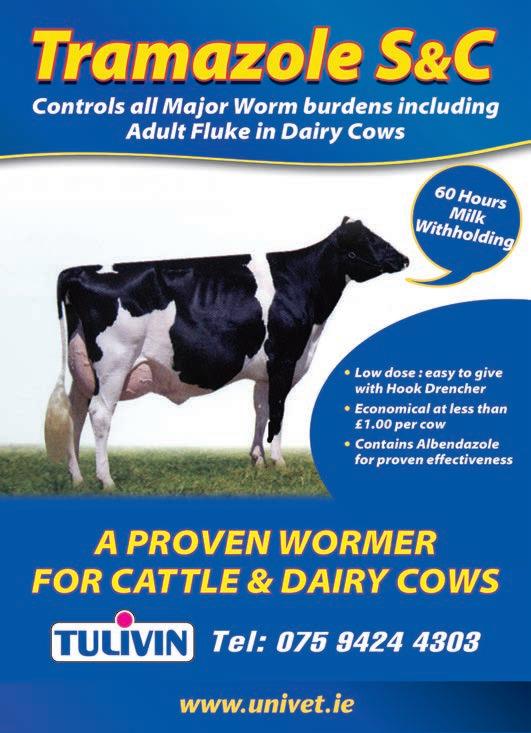
to provide a clearer balance of nutrition from sources, which include propylene glycol, sodium propionate, sorbitol, volatile fatty acids, cobalt, yest extracts and molasses.
rFor more details, visit STAND H154
It contains VetAgro MecoVit - a combination of rumen-protected microencapsulated choline, methionine and betaine.
Its high digestible undegradable protein status comes from AminoMax, combined with high starch levels to efficiently feed the rumen microbial population.
Controlled calcium and phosphorus levels and high levels of magnesium, vitamin D3, and anionic salts help to reduce the risk of milk fever.
It also contains Safmannan and selenium yeast to help increase colostrum IgG levels for the newborn calf, and highly bioavailable Availa Zinc and Intellibond Copper to aid immunity and helps fight inflammation in the cow at calving.
rFor more details, visit STAND H142
JSustel, from DSM Nutritional Products, is an intelligent sustainability service. It combines an advanced environmental footprinting calculation tool with expert sustainability, animal production and nutritional
JVistaPre-T, from AB Vista, is a pre-treatment that can be formulated into the ration to get more energy from home-grown forage, reducing reliance on other costly cereals or additives. Said to be a revolutionary feed technology that directly impacts fibre usage, the first of its kind to enter the ruminant market.
knowledge to create tailormade, practical solutions and business development projects that enhance the environmental sustainability and profitability of animal farming.
rFor more details, visit STAND TB11
It improves fibre use, reduces emissions and provides a rumenfriendly source of energy to help productivity. It helps to maximise forage, reducing the need for expensive concentrates, helping to lower emissions, feed costs and improve performance.
rFor more details, visit STAND L16
J is year sees the return of the dedicated ‘sharing knowledge’ zone with industry panels and seminars. ere will be four industry panels with leading rep resentatives discussing sustaina
r10am Seminar - Volac International
r10.30am Industry panel -
Sustainable Farms
r11.30am Seminar -
Feeding the modern dairy cow – Adam Clay, NWF Agriculture
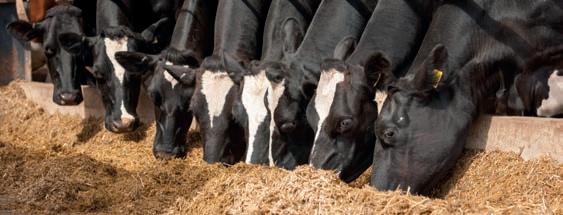
bility within the dairy sector. e hour-long panels will run alongside four seminar presenta tions, sponsored by Volac, with speakers covering key dairy indus try subjects.
level
protected feeds to support
performing
by-pass protein (Ultra Pro-R) can help achieve an efficient and cost-effective diet,
r12 noon Industry panel -
Sustainable Finance
r1pm Seminar - Crystalyx
r1.30pm Industry panel -
Employment
2.20pm Seminar - Lely
2.45pm Industry panel -
Dairy Market
JUK Dairy Day will also recognise the hard work that goes into planning, designing and building the display of trade stands. The trade stand competition will see judges from sponsor Hettle Andrews review the exhibition areas and award prize cards for the best small internal
stand, best medium internal trade stand, best large internal trade stand and best external trade stand.
There will also be awards for best presented and tidy lines, Holstein UK premier herd, premier breeder banner, premier exhibitor banner, and Harold Sneesby award.
high yielding
for early lactation
Starch-W can aid rumen health helping
achieve feed utilisation, reducing the rate of
fizz’ in the rumen which can help prevent rumen pH drop.
British and/or European grown raw materials where possible can help to reduce agriculture’s carbon footprint.
New Product Competition finalist at
Dairy Day

Dairy Day 2022 Principal & Cattle
Sponsor
Breeders from across the UK will compete at the cattle show held at UK Dairy Day, and this year’s Dairy Shorthorn classes will be judged by David Winnington. Wendy Short reports.

David Winnington is well known in the world of Dairy Shorthorns and will bring a lifetime of experience when he judges the classes this year.
His criteria have changed li le over the years, with strength, good mobility and a well-formed udder among his top priorities. ese features are uppermost in his mind when he is selecting females for his noted Rantonall herd in Sta ord-
shire. Mr Winnington has been judging Dairy Shorthorns for almost three decades and is vice-president of the breed society.
Despite undergoing some subtle changes, the breed’s characteristics have remained basically unchanged for many decades, he says.
“It has slightly increased in size and become a li le more angular and dairy-like, but in my opinion it has lost none of its positive a ributes along the way. e Dairy Shorthorn
is based on a durable, e cient and low-maintenance animal with good conformational traits.











Ideal cow
“My ideal cow will weigh 550-600kg and she will be able to cope with a long grazing season, while producing plenty of milk from forage. Dairy Shorthorns are also renowned for their exceptionally good temperament.”
His judging career began while he





was a Young Farmers’ Club member and the hobby has since taken him all over the country and beyond.
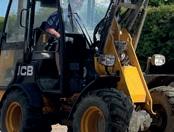
Highlights include judging the Royal, Great Yorkshire and Royal Highland shows, as well as numerous herd competitions and top events in Northern Ireland and Ireland.
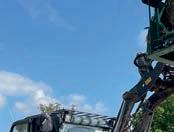
It is not unusual to nd Mr Winnington in a reversed role and facing the judge himself with his 160-cow herd, which is based at Moor End

Farm, near Gnosall. e ca le have achieved considerable success in the ring, last year taking the reserve supreme championship at the National Shorthorn Show.
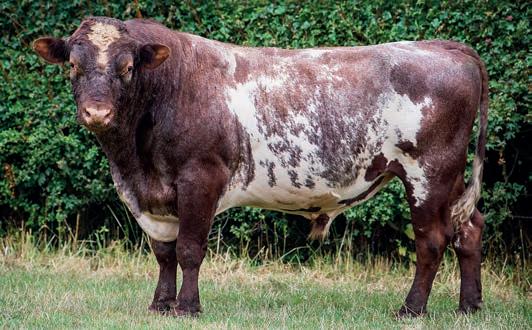
e award went to Rantonall Songstress 50, an EX95 sixth calver by Rantonall Stephen, while the herd also picked up the reserve ticket for the best junior on the day, among several other placings.
In 2019/20, the herd was runner-up in the North Midlands
Reality judged the top stock bull.
By Rantonall James, Reality scored 90 points as a two-year-old and his semen is being o ered privately.
Mr Winnington says: “ e female lines are the foundation of a good herd. e breeding policy is rmly based upon picking from the top female lines and the system has
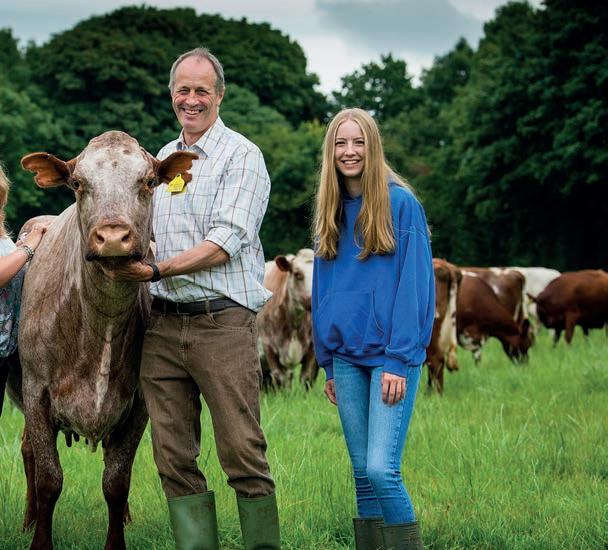
paid o , with 17 EX females identied at the most recent inspection.” e cows are testament to the longevity of the Dairy Shorthorn, with 12-13 lactations ‘not unusual’, says Mr Winnington. e herd calves all year round and has an average yield of 5,200-5,500kg at 3.9% and 3.4% protein, with milk sold to the local Wells Farm Dairy.
He says: “ e lactation average for the herd is six to eight, but our oldest cow is 16 years old and still

going strong. Ca le are free from metabolic diseases and I think I have seen only one case of twisted stomach in my association with the breed.
“I rarely have to pick up a cow’s foot and their feet do not have to be trimmed on a routine basis.
“ ere is no requirement for a routine veterinary visit for fertility; we are perfectly content with our 360- to 370-day calving interval.”
Heifers are calved at 28-30















The HerdVision 3D camera system automatically
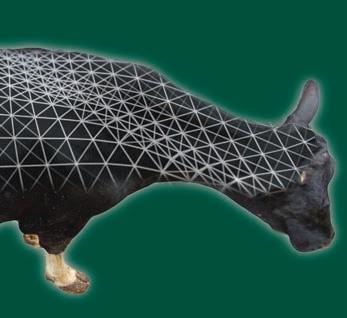
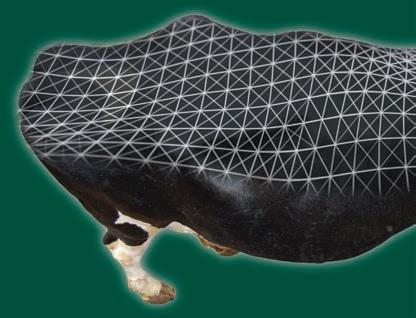


and condition scores every cow every
they leave the parlour
to meet requirements of milk buyers
Reduced labour scoring cows

alerts of problem cows
management decisions
costs

months, but Mr Winnington has taken note of research indicating that milk producers should aim for 24 months in order to maximise pro tability.
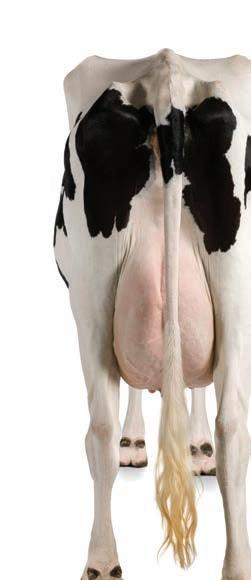
He says: “ ere is not so much pressure to calve heifers early within an all-year-round calving policy, but they will be inseminated at a slightly younger age in the future, although the target will not be as low as 24 months.
“A heifer calved at a young age will require additional feed and it will also command additional time and a ention, so I am not fully convinced of the economic bene ts.” e all-grass unit is made up of a mixture of owned and rented land, totalling about 137 hectares (340 acres). Situated at about 120 metres (400 ) above sea level, the soil is a fairly free-draining medium loam, which allows for the grazing period to run from the beginning of March to December.
During the short housing period, cows are kept in cubicles and fed a
simple diet of grass silage, topped up with concentrates o ered in the 10:20 herringbone parlour.
He says: “Dry cows and youngstock were fully out-wintered until four years ago, when we had the opportunity to rent some buildings.
e housing does incur some additional costs, but it is useful as we are


in a six-monthly testing area for TB.
“A combination of paddock and strip-grazing systems is adopted while cows are at grass. ese have traditionally been made up of perennial ryegrasses and white clover, but there are plans to include some herbal leys in the next round of reseeds.
“ e farm does not currently have land in an environmental scheme, but the plan is to sign up for one next year. e herbal leys should help us qualify for scheme membership and there have been a lot of reports that they have potential to bene t cow health.”

e Rantonall herd has a long
JEddie Barrett is the dairy breeding programme manager with the National Cattle Breeding Centre (NCBC) in Ireland.

Along with his team, he is responsible for the delivery of an elite selection of top dairy sires for the benefit of NCBC shareholders and farmers and the export requirements of Ireland Genetics.
Mr Barrett grew up on the family farm which is home to the Laurelmore herd. He is a member of the Irish Holstein Friesian Association official Holstein judges’ panel, having been first selected in 1992.

He has also been on official breed and inter-breed judging assignments in Ireland, the UK and France, including the inter-breed judge at Royal Ulster Agricultural Society Balmoral and Welsh Dairy Show, along
with numerous national and regional Holstein and Jersey herd competition assignments.
JLaura Sales comes from Radstock, Somerset, and works part-time for the Walters family of Creech Hill Ayrshires, where she helps with the calf rearing and relief milking, alongside bringing up her two children.
She was born into a Guernsey background and has a lifelong association with the breed. She has spent most of her working life in Bristol with the Bickfield herd of 300 Guernseys, owned by the Durbin family.
She has been on the Guernsey Society’s judging panel since the age of 19 and has judged all over the country at local and county shows, judging all breeds along the way.
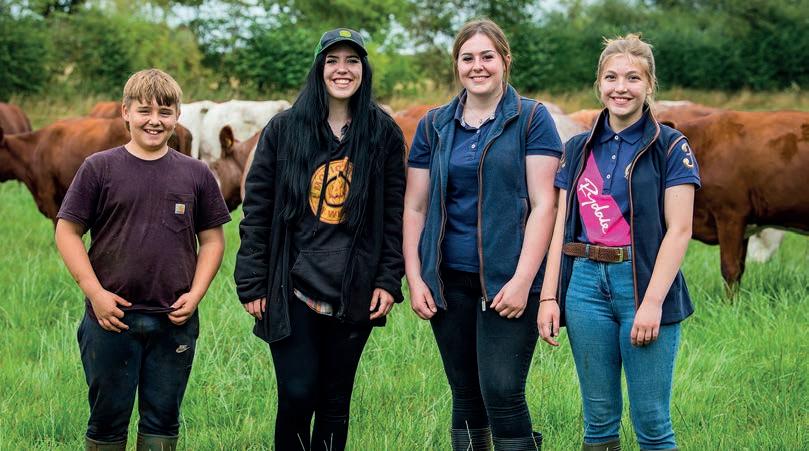
Dairy Shorthorns is associated with encouraging the next generation, he says. At any one time, the farm will employ one or more young people, many of whom remain in the industry a er gaining dairy experience.
He says: “It is marvellous to see a ve-year-old child, for example, leading a calf in the showring and doing well. Another aspect is the delight in having a line of people facing you and knowing that their animals are their pride and joy.
history, having been registered in 1978 by Mr Winnington’s parents, John and the late Doreen. However, the herd goes back even further, as his grandfather Bill Winnington started milking the breed in 1933.
Mr Winnington and his brother Stanley joined the partnership in the late 1980s and Moor End, which he now farms with wife Debbie, was purchased to allow the two brothers to run their own businesses.
Stanley and his wife Anne have
also continued to milk pedigree
Dairy Shorthorns and, although they have no involvement in ca le showing, the two separate businesses provide mutual help and support.
Some of the recent changes in UK agriculture have boosted the popularity of the breed, Mr Winnington says.
“A number of dairy farmers are looking for a low-input cow which will thrive on a simple, grass-based regime and the Dairy Shorthorn ts the bill. My father was a huge

fan, but he was very wise and let me experiment with other breeds. I quickly found that they did not t in with the system. I would not consider a move away from the Dairy Shorthorn, because it does exactly what I want it to do on this farm.”
Mr Winnington and his wife have two daughters: 17-year-old Grace is studying horticulture, while 15-year-old Naomi is keen on sheep and keeps a ock of Zwartbles. Part of his passion for judging
“ is applies whether the show is at national or local level.
“It is a privilege to be part of such a wonderful spectacle and judging also provides the opportunity to socialise with fellow enthusiasts.
“We live close to a village and fortunately do quite well with a racting sta , although we put a lot of e ort into creating the right environment and treating them well. It is very satisfying to see them go on to bigger and be er things and hopefully becoming bi en by the ‘showing bug’ like I have.”
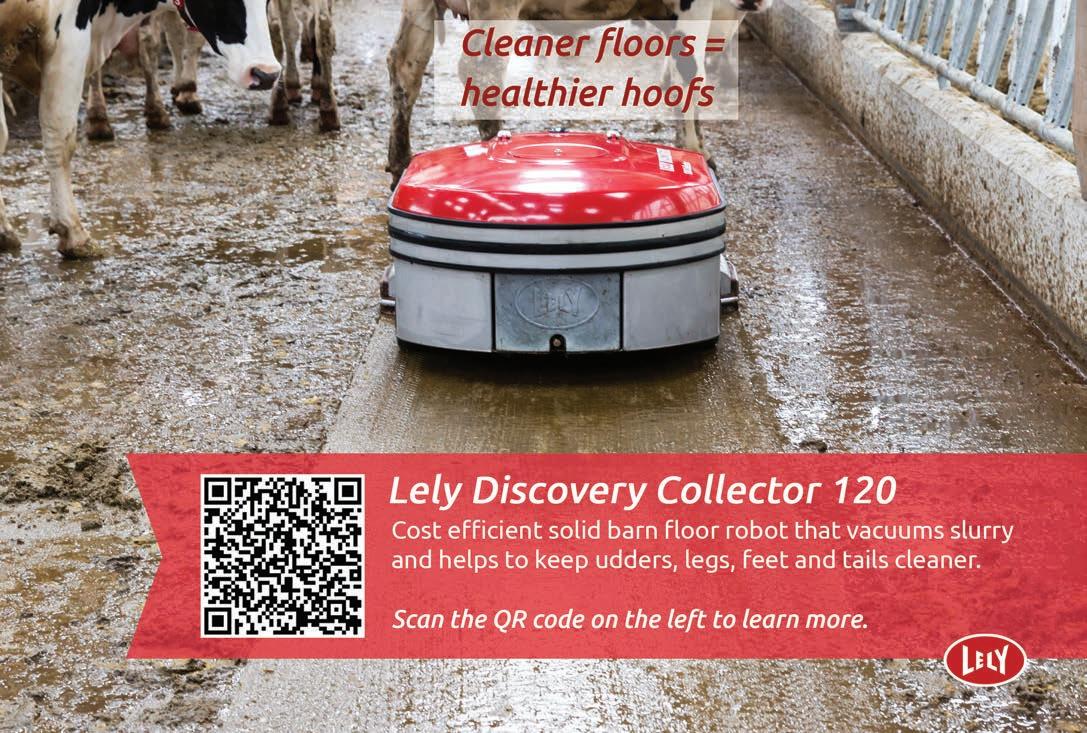
This year, UK Dairy Day will welcome an international line-up of judges to cast a professional eye over the National Shows for Ayrshire, Brown Swiss and Holstein, which will be featured in the cattle show, alongside Dairy Shorthorn, Guernsey and Jersey breeds.
JThe Ayrshire Cattle Society’s National Show will be judged by Lynn Lee from Smyrna, Tennessee.
Mr Lee is a lifelong dairy cattle breeder with a wide range of experience and has previously worked as an auctioneer, a type evaluator for the American Jersey Cattle Association and a show judge.
Mr Lee’s judging assignments over the past several years have included World Dairy Expo, the AllAmerican Dairy Show at Harrisburg, Pennsylvania, Eastern States Expo, and the Ayrshire, Guernsey and Holstein shows at the North American International Livestock Expo.
He judged the 2007 All-American Junior Jersey Show, the 2008 National Jug Futurity and the 2010 Western National Jersey Show.
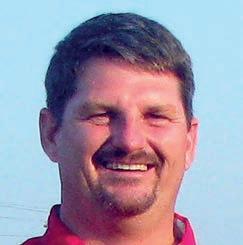
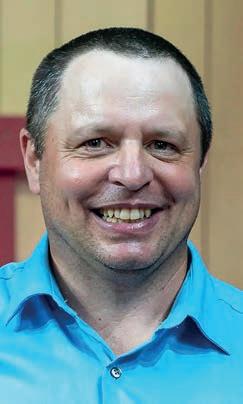
He has also travelled to Colombia, Canada, Finland,
Guatemala, South Africa, Australia and New Zealand to judge the National Shows in these countries.
Mr Lee and his family operate a 137-hectare (340-acre) farm and, over the years, they have bred and owned numerous All-Americans and reserve All-Americans bearing Lee’s Dixieland Prefix.
He is also co-owner of Tradition Auction Services, which is a full service auction company selling dairy cattle, beef cattle and farm equipment.
JAmerican judge Adam Liddle will preside over the National Holstein Show. Mr Liddle and his wife Nicole own and operate Liddleholme Farm, Argyle, New York, with their children Anthony, Brock and Hailee.
Liddleholme Farm covers 121 hectares (300 acres) and is home to 70 milking Holsteins. The farm has a strong focus on breeding with 37 cows currently scored as Excellent. One of Liddleholme’s greatest achievements was breeding the
four times excellent Liddleholme Resurect Lu EX97 4E.
The Liddles have had numerous All-American nominations and they are very proud to have bred or owned an All-American nominee for 13 consecutive years.
Mr Liddle judged the red and white Holsteins at the 2012 World Dairy Expo, along with the International Holstein Show in 2018. He has also judged National Shows in Canada, Brazil, Argentina, Switzerland, Italy and Australia.
JThe Brown Swiss National Show will be judged this year by Italian judge Daniele Galbardi.

From a small village close to Iseo Lake, in the province of Brescia, north Italy, Mr Galbardi and his brother run Galby Farm.
The third generation brothers have a herd of 50 Brown Swiss cows in-milk, along with followers. The average annual production is 11,000kg with 4.15% fat and 3.84% protein.
Their showing highlights include winning reserve grand champion at the Italian National Show in 2010, winning junior champion in 2013 and taking grand champion and best udder in 2014.
Since 2008, Mr Galbardi has been a multi-breed classifier, assessing Holstein, Jersey, Brown Swiss and Fleckvieh
cattle, and he has classified about 100,000 cows.
He has been judging Brown Swiss for many years and, since 2016, has been a member of the European judging panel.
He has judged more than 100 shows across Italy, including three times at his National Show. In 2020, he was honoured to be the official judge for the European Brown Swiss championship and his judging has taken him to France, Switzerland and Peru.
JLynden Bustard, UK Dairy Day cattle show manager and chief steward, says: “UK Dairy Day is delighted to welcome an international leading line-up of judges from across the channel in Europe to the other side of the Atlantic in America.
“The cattle show continues to be a major part of the event and is continually supported by breeders and competitors across the UK and Ireland.”
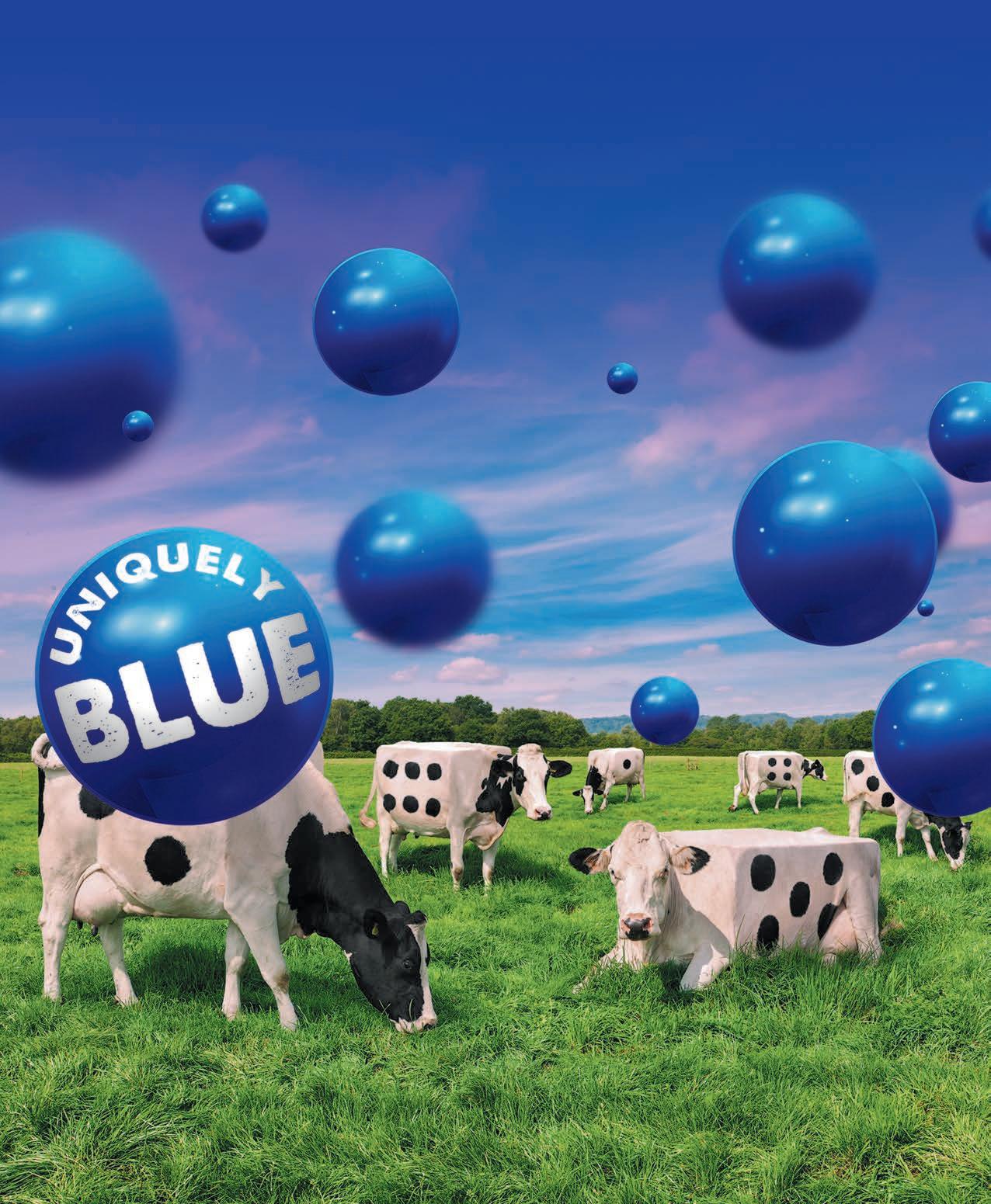
Remaining at the show’s heart are the dairy cattle.
Visitors to this year’s Dairy Show can once again expect a showcase of the latest innovation, trusted merchants and rst-class stockman ship. e dairy sector is a fundamen tal part of British agriculture, says acting head of shows, Jess Chiplen. She says: “We are in the heart of it here in the South West – within the sector are world-class farmers and agricultural companies who are responsible for pioneering new technology, genetics and practices.
rWhen: Wednesday, October 5, 2022; gates open at 8.30am
“It is a privilege to host many of them here.”
e event’s theme this year will be muck, with the focus on ways organic manures can be collected, stored, optimised and applied to maximise soil health and, ultimately, the performance of crops and grazing livestock.
Ms Chiplen says: “At a time when milk price and costs, such
as feed and fertiliser, are so high it is important that ideas and know ledge are shared to capitalise on marginal gains and opportunities.”
Remaining at the show’s heart are the dairy ca le, with exhibitors travelling from all over the country to compete in a variety of breed classes before respective champions go head to head for the sought-a er supreme champion title.
the incredible up-and-coming talent we have in the industry.”
For the rst time ever, the British Cheese Awards will be taking place at the Dairy Show, providing an impressive display of dairy produce, including cheese, bu er, yoghurt and cream.
Ms Chiplen says: “ e Ayrshire, Dairy Shorthorn, Guernsey, Hol stein and Jersey breeds will all be well represented.”
Judging of the awards will take place on the day, with visitors able to view the display and take part in the all-important People’s Choice Award.
r
Where: The Bath and West Showground, Shepton Mallet, Somerset, BA4 6QN
rTickets: Advance tickets are available at £15 per adult,
increasing to £18 on the gate; students, with proof, will have discounted entry at £14; children under 15 years old will have free entry rMore information and to book tickets: bathandwest. com/the-dairy-show
e Jersey Ca le Society of the UK and the English Guernsey Ca le Society will both be holding their national shows at the event.

Ms Chiplin says: “On top of that, we have calf classes and the popular showmanship competition. e la er is always a ne example of
Ms Chiplen says: “We are delighted to be welcoming everyone back to the show. It is particularly exciting to encompass the British Cheese Awards, providing the perfect platform for producers to showcase the complete journey from farm to fork.”


Understanding mineral nutrition for dairy cows is an evolving science, with considerable advancements being made since the introduction of sulphate and oxide minerals in the early 20th century.

New categories of trace minerals have been established along with a greater understanding as to how mineral supplementation impacts animal efficiency, farm profitability and sustainability.
With the latest guidelines to dairy cow nutrition recently published by NASEM, which incorporates an ever-growing body of independent research, means 2022 is the year to get mineral nutrition right. The research confirms the absolute need to deliver both the most bioavailable form and optimal levels of trace minerals to support animals’ requirements while reducing environmental impact. Mineral bioavailability refers to the proportion of the mineral consumed which is absorbed by the animal. Many factors influence mineral bioavailability, but the most defining factors are the solubility, bond strength and structure. The use of inorganic minerals such as sulphates and oxides have dominated the market for many years and as a result of their extremely low bioavailability, recommendations have been based on levels which greatly exceed actual requirements.

Oxide trace minerals such as zinc and manganese are inexpensive, yet the mineral contained within

their structures is largely insoluble, meaning bioavailability is generally very low and variable. This makes it all but impossible to actually determine the amount of oxides required to meet animals’ needs. Sulphate minerals such as copper suffer several negative side effects, including their high reactivity. When copper sulphate comes into contact with water, either in damp conditions or the rumen, the mineral is released meaning it may bind with other nutrients known as antagonists. Once bound the mineral is no longer available for the animal to use, making accurate mineral balancing in a ration difficult.
To compensate for these downfalls the newest trace mineral technology comes in the form of hydroxy trace minerals (IntelliBond) which support both optimised bioavailability and economics. These minerals have a unique structural composition which means they are insoluble in the rumen and dissolve layer by layer in the intestines for a slow, steady and consistent release of mineral. As a result, the minerals are less susceptible to antagonism and greater amounts are delivered to the intestines for absorption into the bloodstream and actual use by the animal. Optimised absorption also means less environmental excretion
due to their improved bioavailability. Research shows IntelliBond minerals are 2x more bioavailable than inorganic sources, meaning 1000mg/kg copper IntelliBond supplies the same bioavailable copper as 2000mg/kg copper sulphate with fewer negative interactions and less risk for greater reward.



Now that a greater emphasis is placed on efficiently meeting animal requirements, research validated products are becoming more important. IntelliBond enables producers to work towards a responsible mineral strategy and offers a unique and technologically advanced solution to help drive superior animal performance whilst also delivering environmental benefits due to a reliable and predictable supply of minerals.

• Addresses real requirements










Maximises animal absorption
Increases overall efficiency
Minimises nutrient destruction
Considers environmental impact






Bioavailability is not the only benefit to the use of IntelliBond minerals. Follow on over the next 3 issues to discover how ration availability, palatability, quality and sustainability are all positively influenced. In the meantime, if you want to start to take action now reach out to us at trouwnutrition.co.uk/intellibond

Aer a two-year hiatus, the British Cheese Awards is set to return this year, and for the rst time ever, the awards will take place at the Dairy Show.

e awards will include impressive displays of dairy produce, including cheese, bu er, yoghurt and cream.
Judging of the awards will take place on Wednesday, October 5, with visitors at the Dairy Show being able to view the display and take part in the all important People’s Choice Award.
Julius Longman, chair of the British Cheese Awards at the Bath and West, says: “We are delighted to nally be hosting the British Cheese Awards again, particularly with a brand new date later in the year which will provide the perfect platform for producers to showcase their products just in time for Christmas.”
e British Cheese Awards is now in its 28th year and continues to a ract entries from more than 75% of UK producers.


Judging at the British Cheese Awards.
JLast held in 2019, the British Cheese Awards saw the supreme champion title go to White Lake Cheese, for the third year in a row, a first in the awards’ history.

The 2019 winning cheese was the English Pecorino, which is made from sheep’s milk, by Roger Longman and Pete Humphries, at White Lake Cheese, Pylle, Somerset.
It was named the top cheese from just under 900 cheeses which were entered into the 2019 awards, which were held on the first day of the Royal Bath and West Show at Shepton Mallet, Somerset.
English Pecorino is made from thermised sheep’s milk with vegetarian rennet. It has a sweet smooth, long-lasting creamy flavour with subtle nutty notes. It is washed in brine three times a week and is matured for about six months.
Mr Longman, a third

generation farmer and cheesemaker at White Lake Cheese, says: “The British Cheese Awards is a great competition for artisan cheesemakers. The level of judging is superb as the judges are extremely experienced, they are the best in the UK, and we really value the feedback we get from them.”
White Lake’s home is set at Bagborough Farm, near to the Glastonbury Festival site in Somerset. Milk from Mr Longman’s herd of Toggenburg, British Apline and Saanen goats is used to produce goats cheese. A local Guernsey herd provides the cow’s milk and the sheep’s milk is also sourced from a local flock.
In 2017, White Lake Cheese won the supreme award with Pave Cobble and in 2018 it won for Sheep Rustler. Both are sheep’s cheese.
We are delighted to finally be hosting the British Cheese Awards again
JULIUS LONGMAN




















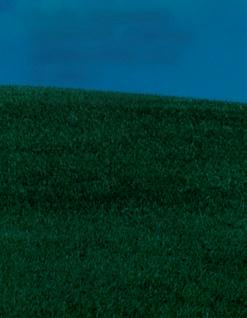





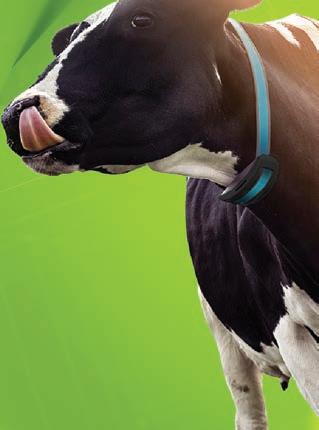




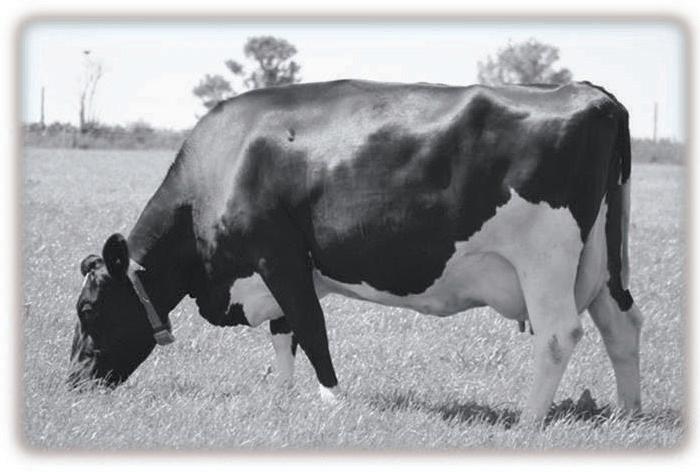


dairy breeder and judge Paul Harrison, from Northumberland, heads to this year’s Dairy Show
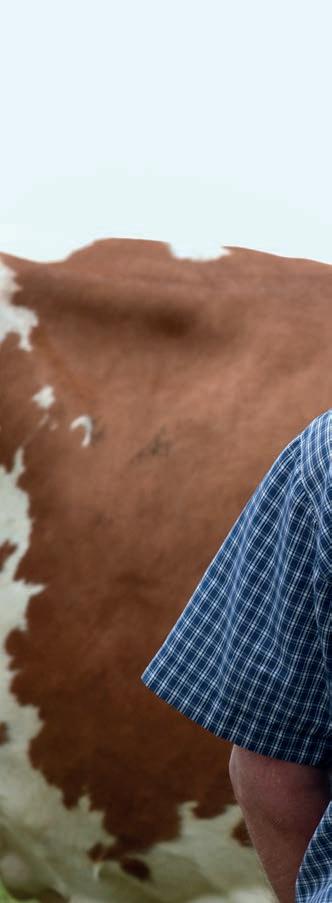
Fallon
judge the Dairy Shorthorn classes
Surrounded by Northumberland countryside, Paul Harrison, his wife Ann and their two daughters Joanna and Victoria, milk a 100-cow closed herd of pedigree Holsteins and Dairy Shorthorns at Breckney Hill Farm, near Heddon-on-the-wall.
Originally residing in the North Tyne Valley, Mr Harrison’s parents initially milked
r67 hectares (165 acres) of grassland

Silaging begins in mid-May with three cuts taken annually

Milk sold to First Milk
Herd averaging 8,500kg at 3.2% protein and 4% butterfat
Calves fed on whole milk
British Friesians, establishing their Chishillways pedigree British Friesian herd in 1958.
It was in 1972 that Mr Harrison and his parents moved to Breckney Hill Farm as tenants, which they later purchased in 1996.
Following a stint away at college and ve years working at the Hunday Herd, at Peepy Farm in Northumberland, Mr Harrison returned home to
work on the farm in 1983 when the family began introducing Holstein genetics into the herd.

But it was not until 1989, following Mr and Mrs Harrison’s nuptials, that they decided the farm needed a new direction.
In the spirit of trying something new, they purchased their rst Dairy Shorthorn cow.
and weaned at eight to nine weeks of age
rBull calves are sold at 10-12 weeks of age at Carlisle Auction Mart
rHeifers served at 16 months of age to conventional Holstein and Dairy Shorthorn semen
Mr Harrison says: “Ann used to work at George and David Dent’s dairy farm in Kirkby Stephen, milking Dairy Shorthorns in their Winbrook herd, so that is where we bought our rst Dairy Shorthorn, which established our Breckney Shorthorn herd.”
Following this, the couple bought a cow from Sam Wilson at Castle Douglas, called Screel Goldie 6, which marked the
beginning of a very successful Goldie line for Mr and Mrs Harrison.
Mr Harrison says: “Her daughter Breckney Goldie was such an excellent cow that she won classes at the Great Yorkshire Show several times.
“We had her all set up for the Dairy Event at Stoneleigh, but then foot-and-mouth broke out, so we could not take her. She went on to develop E.coli mastitis and we thought we


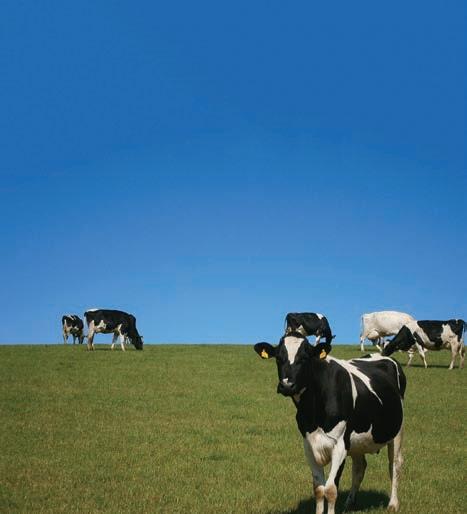







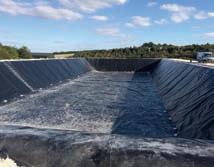
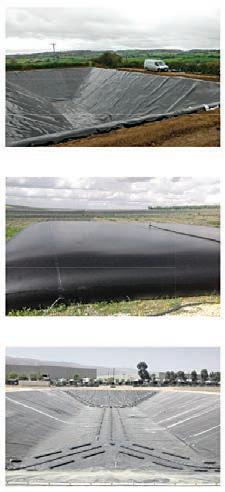
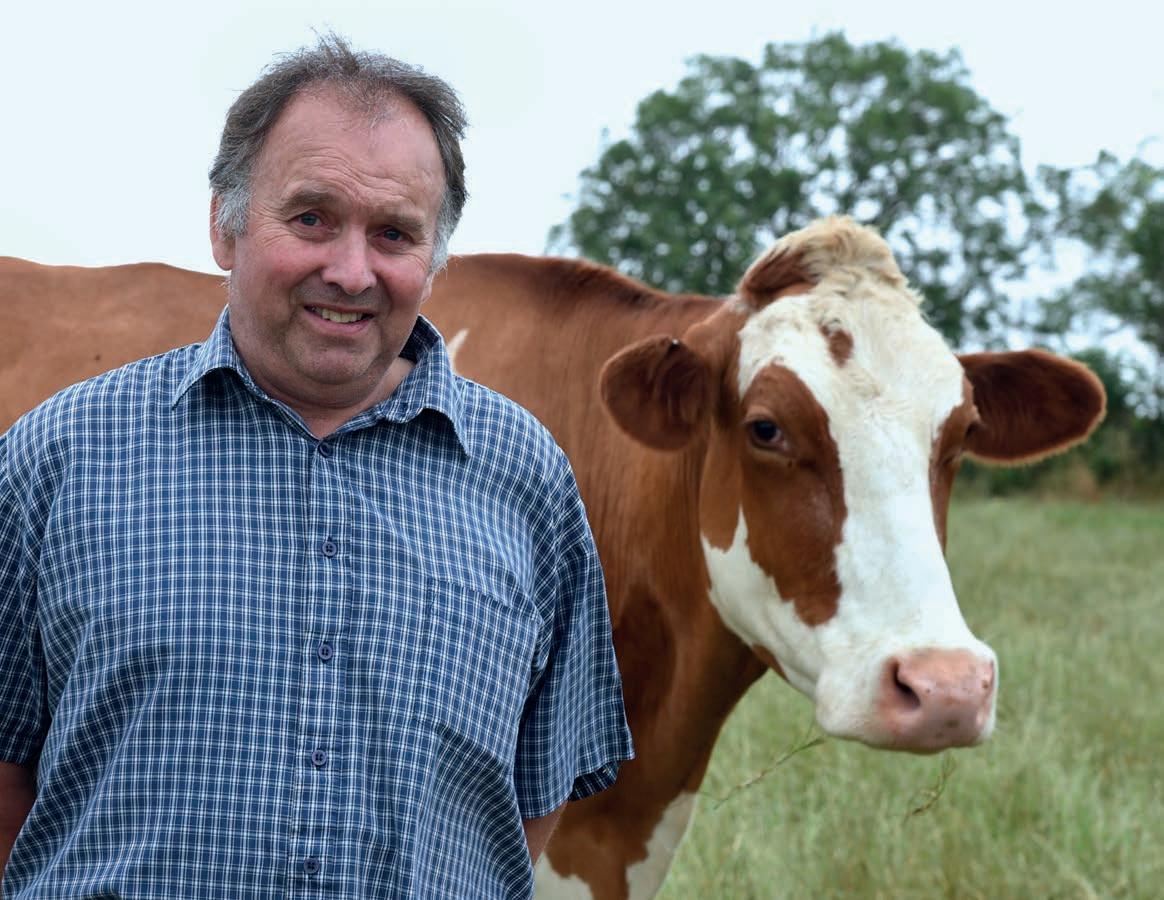
were going to lose her, but she survived and we decided to ush her.”
From two ushes, 23 embryos were collected, with 11 heifer calves and three bull calves being registered.
Mr Harrison says: “One of those bulls went onto to be an arti cial insemination bull, Churchroyd Goldwin.
“His semen is still available today through Red Ca le Genetics and he went on to sire the winning cow of the Great Yorkshire Show in 2017.”
at one Goldie cow went onto develop the foundations of the Breckney Shorthorn herd which are still present today, with all four Dairy Shorthorn ca le Mr Harrison took to the Great Yorkshire Show this year being from the Goldie family.
Today, Mr and Mrs Harrison run 30 pedigree Dairy
Shorthorns and 70 pedigree Holsteins under their Breckney and Chishillways pre xes. With no sta , they run the farm between them, with help from their daughters and friends when needed.
Mr Harrison says: “Both daughters work away from the farm, but will always help whenever we ask.”
e family milk through a 7:14 Fullwood herringbone parlour, with the herd currently averaging 8,500kg, at more than 4% bu erfat and 3.2% protein.

Cows are grazed from April until October and are fed self-feed silage through winter, which Mr Harrison says is a ‘simple system for simple people’.
e herd operates at a high health status, with annual
vaccinations for leptospirosis, bovine viral diarrhoea and regular blood sampling for Johne’s disease.
Mr Harrison says: “You can never ever say you are disease free, but we try to operate at the highest health status possible.”
Mr Harrison does all the breeding himself, with very li le beef semen used. All heifers are served at 16 months then followed up with a Holstein bull to catch anything which has not held.
He says: “We serve at 16 months to get natural growth, because when you are on a self-feed silage system you need robust cows. Also, the cows and heifers run together, so they need to be big enough to survive.”
Calving takes place all year round, with surplus newly
calved Holstein heifers sold monthly through Carlisle.

He says: “I have always bred for type not gures, because if you breed the right type, the milk will come. We have to breed functional cows with good feet and legs which sell well at market. If you breed good type, buyers will come back every time.”
Regulars in the sale ring, Mr Harrison and family have also had great success in the showring, with Breckney Hill Farm claiming a vast number of rose es over the years.
Mr Harrison has been involved with both showing and judging for the last 40 years, with the showring having always been a part of his and his family’s lives.
He says: “It all started
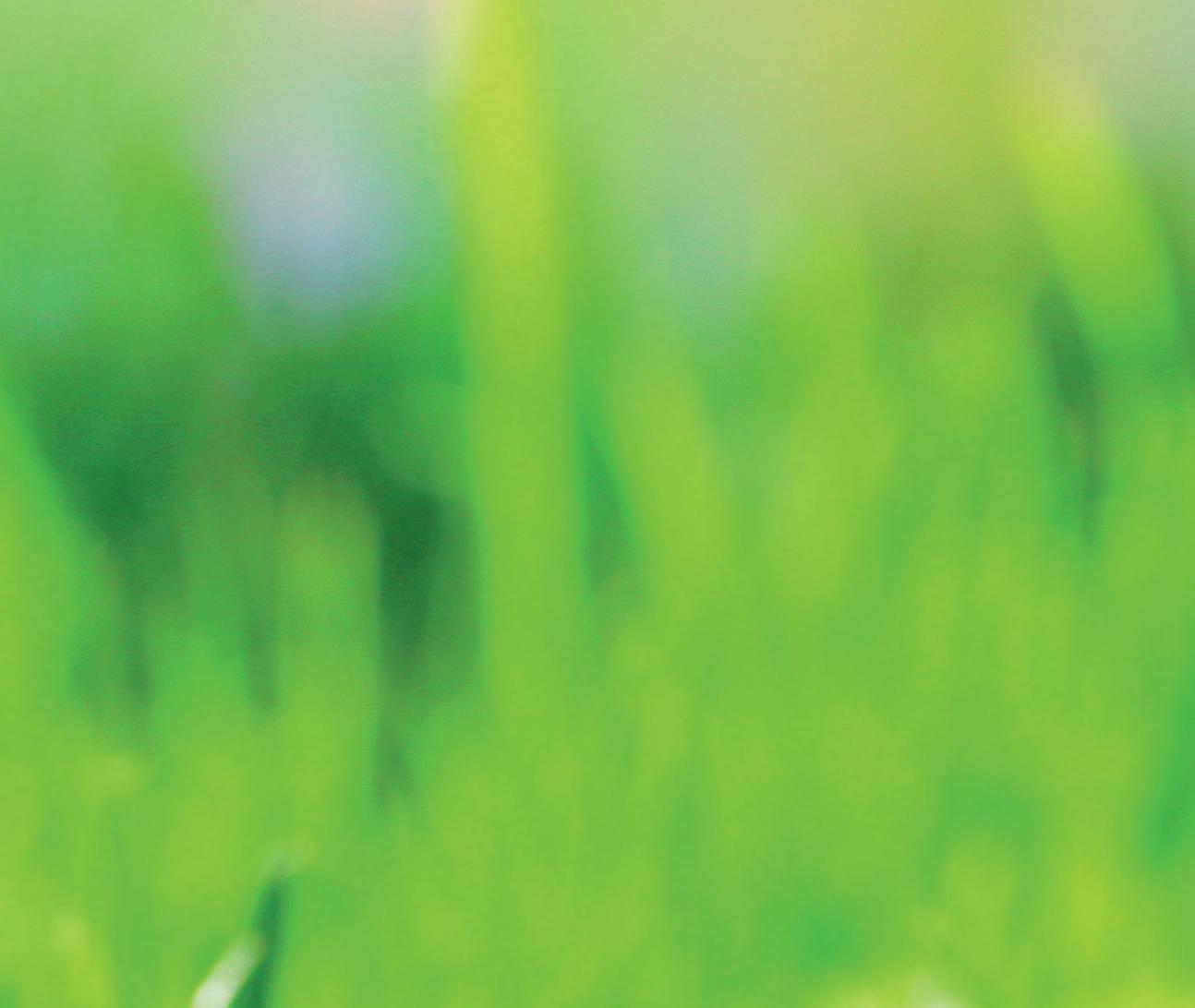

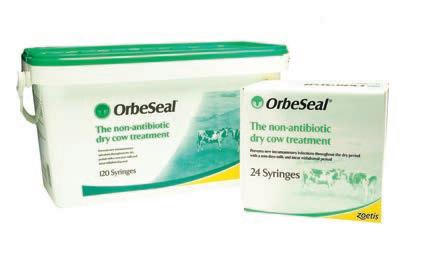

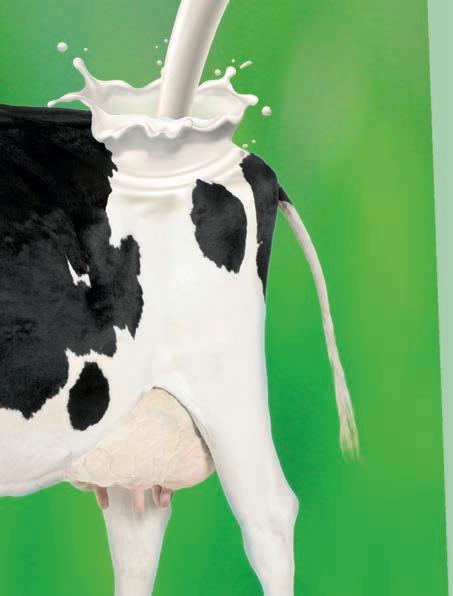
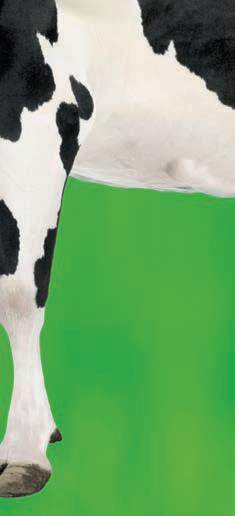














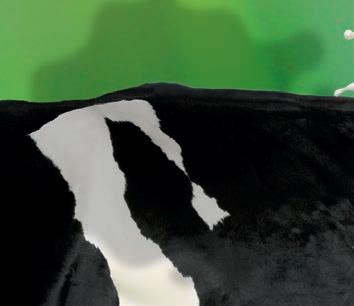



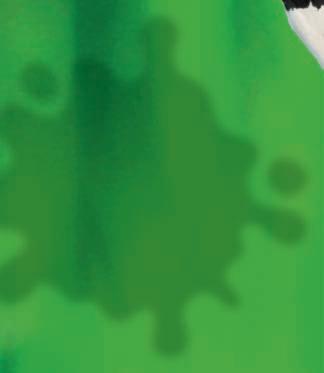

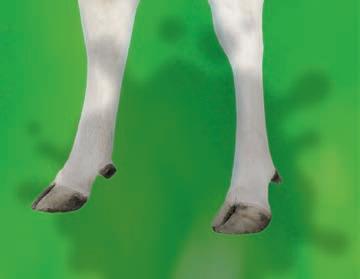












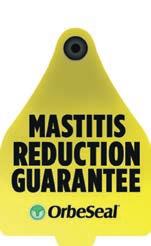

through my uncle. He wanted something to show at a local show, so my dad sold him one of our cows.
“I told Dad o for not selling him the best one, but he had method in his madness, as he told me he had not sold him the best because we were going to take the best and beat him.”
Having shown since the early 1970s, the family have been triumphant with their Holstein and Dairy Shorthorn herds.
As winners of the Holstein Friesian championship and inter-breed championship at the Great Yorkshire Show in 1996, they have also taken the national All Breeds Calf Show, Shorthorn championship in 2012 and 2013, junior and reserve champion at the Great Yorkshire Show in 2017, as well as championships at Dairy Expo and class winners at AgriScot. e family complete all the show preparation themselves, with Mrs Harrison taking charge of halter training and Mr Harri son responsible for clipping.
He says: “Our daughters have
both competed in showmanship classes and have done really well across national competitions –they both really enjoy it.”
As a result of their showring success, Mr Harrison has been lucky enough to judge at many shows and competitions, travelling the length and breadth of the country.
His stockman’s eye took him further than British waters in 2018, a er being asked to judge at the Australian Inter national Dairy week in 2019.
Mr Harrison says his Australian debut was complete luck, a er meeting an Australian judge at the Royal Cheshire County Show, he received a phone call 18 months later ask ing him to judge the Australian Illawarra Shorthorn ca le.
He says: “It was an amazing experience and I got to spend time looking at red ca le gen etics while I was out there.
“I have since been asked to judge at the Royal Adelaide Show as soon as Covid-19 restrictions allow.”
A er building such a reput
able presence in the judging arena, it is di cult to imagine a time when Mr Harrison was not judging.
However, it all began where most good things do, through his local Young Farmers’ Club, which saw him go onto repre sent the club at both county and national levels.
Mr Harrison also began representing the Northumber land British Friesian Breeders Club on both a local and national level.
Since these early days, Mr Harrison has gone on to judge inter-breed and breed classes at the Dairy Event, National Shorthorn Show, Royal Highland Show, All Breeds All Britain Calf Show and the Royal Show to name a few.
However, this year marks the rst year Mr Harrison will judge at the Dairy Show. Judging the Dairy Shorthorn classes, Mr Harrison says he will be looking for a well-balanced cow, with a lot of dairy strength, body and
capacity, with good feet, legs and udders.
Having shown both Holsteins and Dairy Shorthorns over the years and being a self-proclaimed Holstein en thusiast with a passion for both breeds, Mr Harrison says the Dairy Shorthorn is the easier managed breed, with a greater drive to survive.

He says: “In all the years we have had Dairy Shorthorns we have never had to li one up. ey have that willingness to live and thrive, with so much vigour and ght in them.”
Other than virility, Mr Harri son says there is not much dif ference in breed performance, particularly production. How ever, he considers that large Holstein cows are harder to manage compared to the Dairy Shorthorns on his system.
He says: “A good cow is never a bad colour. I still look for the same traits in all of them as they must have good feet, legs and udder. But it is the easy manage ment and the ght to survive I like about the Dairy Shorthorn.”









The Jersey Cattle Society of the UK is holding its national show at this year’s Dairy Show. Here, Hannah Park speaks to Duncan Hunter, who will be taking to the ring to judge the breed.
Duncan Hunter, owner of Hunter Dairy Consulting based in Hertfordshire, has judged at a number of xtures across the UK as well as overseas and this year’s assignment at the Dairy Show will be the third time he has judged at the event.

We nd out more about the judge and what he will be looking for.
AI was brought up on a dairy farm and had an Ayrshire and Holstein herd up until 2011 when the decision was taken to disperse.

A er this, I worked as breed manager at the Ayrshire Ca le Society until 2019 before se ing up my own dairy consultancy business which specialises in developing breeding plans and diversi cation projects for dairy farmers around the country.
Q Which shows have you judged at in the past?
I want to see animals which excel in their functional traits, says Duncan Hunter.
Australia, South Africa, Sweden, Finland, where I judged Jerseys at Finn Dairy Expo in 2018, and Latvia.
In 2017 I judged Jerseys at the Royal Jersey Summer Show on Jersey, which was probably one of the biggest sections in terms of numbers I have ever judged.
dairy quality with strength, along with strong mammary traits and good legs and feet.
businesses will need to commit to having sustainable goals in the future and environmental sustainability is set to continue to be high priority.
A
I am lucky enough to have done a lot of judging over the years in the UK and overseas at Ayrshire and Jersey shows, as well as many interbreeds.
Alongside many national and local shows around the UK in both ca le and showmanship sections I have judged internationally out in
Q
What will you be looking for in your champion?
I am ultimately looking for longevity. I want to see animals which excel in their functional traits that will aid them to live long and healthy lives.
A
I will be looking for animals with balance and correctness, showing me
It has been a real honour to judge at all the events I have been asked to, but one of my most enjoyable experiences has to be when I judged in Jersey at the Royal Jersey Summer Show in 2017.
You could not fail to be impressed by the sheer numbers and quality of Jersey ca le forward, especially when considering the size of the island.
Q How do you view the dairy sector as an industry at the moment?
Also up there is encouraging young people, the next generation, into the sector.
Ultimately, as an industry, we must be open-minded, forward thinking and ready for change.
Q What role do agricultural shows have in a modern dairy industry?
A

We have experienced years of frustration and di culty as an industry.
Many of those who have survived the hard times have had to look to diversify within their businesses in order to survive, but equally it has been di cult for people to reinvest with the milk prices of the past.
We have seen a big increase in milk prices now but at the same time we are seeing a huge increase in input costs.
Looking ahead, I think all dairy
A From local shows to county and national events, agricultural shows are a way of showing the public what the farming industry is all about and it is important they keep this aspect.
Shows are a platform to show people how well looked a er animals are in this country and demonstrate that we have some of the highest animal welfare standards in the world.
Not only that but they are a platform for farmers to get out, understand that they are not alone with any issues they may have and to see and discuss new concepts that may improve their businesses.
For those exhibiting, there is not a be er shop window.
Shows are a platform to show people how well looked after animals are in this country


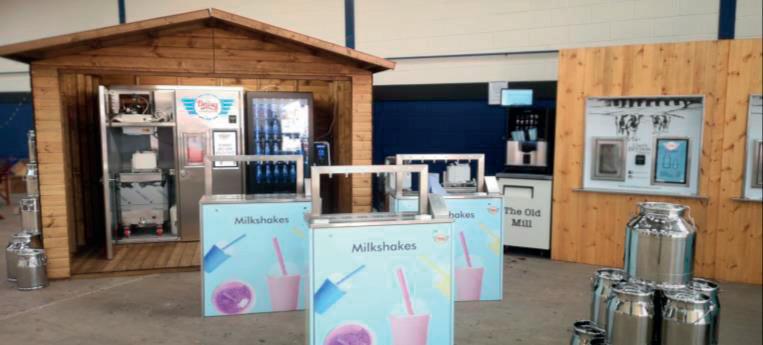


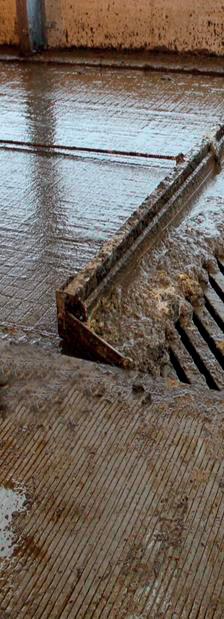





The Dairy Show will once again feature a series of seminars with the theme for this year’s programme being ‘muck’. Dairy Farmer reports.
The seminars at this year’s event are sponsored by EnviroSystems, with the company also presenting in two of the timetabled slots.
With a passion for slurry, producing and supplying SlurryBugs slurry inoculants to the UK and abroad since 2003, EnviroSystems jumped at the chance to sponsor this year’s seminar programme, says EnviroSystems’ founder and managing director Liz Russell.

She says: “To improve soil health and increase crop yields, the best place to start is with slurry.
“By properly understanding the composition of slurry and, in particular, the various forms of nitrogen within it, it allows farmers to optimise the amount of nutrients made available to their plants and maximise crop yield, without being wasteful or leading to over nitri cation.”
is ts perfectly into EnviroSystems’ BioCircle philosophy whereby everything a ects everything on your farm.

To demonstrate the improvements that have been seen on farms across the UK, Mrs Russell will present the results of a review conducted by Dr David Townsend, head of research at EnviroSystems, which assessed the nutrient value of 250 slurry samples from a range of di erent UK farms, independently analysed by NRM laboratories.
ber 2021 prices), equivalent to around 20% more.
Mrs Russell will reveal that the treated slurry also had a higher average dry ma er content of 7% compared to 5.6% for the untreated. is was due to the solidbrous crust being broken down by the bacteria’s enzymatic reactions, releasing smaller particulate ma er into the liquid section making a more homogenous slurry.
She says:“ e breakdown of the crust means slurry requires less ongoing agitation, therefore saving time and reducing diesel and wear and tear on machinery. e reduction in diesel and bought-in fertiliser also contributes to a reduction in a farm’s carbon footprint.
Just over half of the farms in the study had treated their slurry with EnviroSystems’ SlurryBugs, while the rest had not undergone slurry additive treatment.
Overall, the analysis showed that treated slurry had higher
total nitrogen (+27%), phosphate (+45%) and potassium (+16%) levels compared to untreated slurry. Economically the fertiliser value of the treated slurry was worth £2.25/tonne more than untreated slurry (based on Novem-
“At today’s prices, it takes 1,700 litres of milk to pay for one tonne of nitrogen fertiliser, compared to the 900 litres it took between January 2019 and June 2021.”
r
You can listen to Liz Russell speak at 11.40am-12.10pm.
JEnviroSystems’ biochemist and Director Dr Henry Russell will present the progress to-date of a Defra-sponsored slurry emissions research project which started in August 2021.
The project’s principal aim is to deliver a cost-effective biological solution for dairy farmers’ slurry ahead of ammonia reduction targets due to come in 2027.
Dr Russell will share how EnviroSystems aims to reduce ammonia emissions while simultaneously increasing the
homogeneity and the nutrient value of slurry - a critical area of focus due to the soaring cost of bought-in fertilisers.
He says: “This will be achieved through addition of naturally-occurring microorganisms using autodosing technology and it will represent the next generation of SlurryBugs slurry inoculants.”
Dr Russell will also introduce a new cutting-edge in-house slurry analysis service which is set to be officially launched at the show by EnviroSystems.

“It focuses on the fertiliser value of slurry and will help farmers to make the most of their slurry before spreading - allowing them to confidently reduce their bought in fertiliser applications.”
r
You can listen to Dr Henry Russell speak at 12.10pm-12.40pm.

J

While there are a couple milk buyers already paying or con rming 50ppl for our liquid standard litre* a burning question still remains unanswered; will the bulk of producer milk prices actually reach 50ppl this autumn?
With markets quiet through the summer holiday period, sluggish demand along with increasing headwinds, such as the cost of living crisis (of which the cost of in ation of food certainly seems to be shouldering a large proportion of the blame) has seen dairy commodity prices slip back from their record highs.
All is providing an overall picture which is mixed at the moment, with very much a feeling of ‘the jury is out’.





A growing number of milk buyers feel the key level will not be achived, but there is much (or in the case of the south of the country li le) water to go under the bridge and, while everyone will have their opinion,


there is no certainty and li le evidence still to go on.
Much will depend on how demand levels pick up a er the summer break leading into Q4 and the build-up towards Christmas.
At the same time, milk production will continue to be watched closely and, while the south of the country and good parts of Europe are burning to a crisp, north of Manchester appears to be having enough rainfall to keep their growing season nicely on track.
One company which still appears totally focused on achieving the 50ppl milestone is Arla Foods, which increased its conventional and organic supply by a further euro cent per kg from August, which is a further 0.86ppl through its currency smoothing mechanism. This takes the conventional price for August to 48.42ppl for conventional milk based on our liquid standard which represents an increase of 13.13ppl for the year to date.
JWhile Muller has increased its direct conventional milk price by 1ppl to 47ppl from September, the positive August move by Arla Foods has spurred a few liquid milk buyers with a little confidence to push their producer milk price on to 48ppl. Namely Yew Tree
Dairy, which, having held its ‘A’ litre milk price unchanged on 46ppl for August, has added a further 2ppl from September, with the other buyer being Crediton Dairy, which, after holding on 47.5ppl for August, has moved up by a further 0.5ppl.

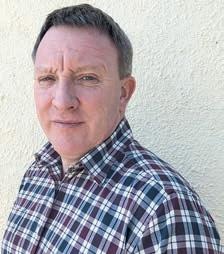
JThe combination of the August moves by Arla Foods and the push by Barber’s Cheesemakers, which increased its August price by 2.57ppl, has meant other cheesemakers have had little time to sit on their laurels from previous price increases.
In addition to increasing by 1.25ppl from August, Saputo Dairy UK has agreed a further 1.5ppl increase with Davidstow Creamery Direct from September.
Total

This price move is the 10th consecutive monthly price increase, totalling 18.35ppl (16.85ppl for the year to date), and takes our manufacturing standard litre up to 49.5ppl.
The new price is 18.35ppl higher than the 31.15ppl paid for September last year.
Our liquid standard increases by 1.44ppl to 47.72ppl.
Wyke Farms has followed its 1.77ppl increase for August with a further 0.51ppl for September, taking our manufacturing standard litre up to 49.2ppl. This latest increase is the company’s ninth consecutive increase for 2022, compared with 30.85ppl (+18.35ppl) paid for the same month last year, while 15.76ppl above its five-year September average price of 33.44ppl.

Our liquid standard increases by 0.5ppl to 47.5ppl.
First Milk increases by 2.14ppl
JFirst Milk has increased its member milk price by a further 2.14ppl from September.
The increase follows the 3.05ppl increase from August and takes our manufacturing standard
*Our liquid standard
litre up to 48.64ppl.
The price for our supplier in the Haverfordwest Tesco Cheese Group also increases by the same amount, taking the price up to 49.5ppl.




Cheddar cheesemakers not to be outdone
LIQUID PRICES (4% b/f & 3.3% prot)
Apr’22 May’22 12mth Diff Latest 4.0/3.3 4.0/3.3 Ave May’22 Confirmed Before Before Jun’21 v Milk Seas’lty Seas’lty May’22 Apr’22 Price
(i) (ii) (iii) (i) v (ii) (iv)
Müller Milk Group – M&S 40.02 41.21 37.08 1.19 46.27
UK Arla Farmers – Tesco 39.62 43.07 36.08 3.45 49.84
UK Arla Farmers – Morrisons (Grazing) 39.41 42.86 35.87 3.45 50.04
Müller Milk Group – Waitrose 38.85 41.10 35.66 2.25 47.70
UK Arla Farmers – Morrisons 39.18 42.63 35.64 3.45 49.81
Dale Farm NI 41.02 43.02 35.08 2.00 45.02
UK Arla Farmers 38.20 41.65 34.66 3.45 48.42
Müller Milk Group – Tesco 38.80 40.84 34.19 2.04 46.00
Arla Foods – Tesco 38.55 40.59 33.94 2.04 45.75
Müller Milk Group – Sainsbury’s 38.62 39.50 33.93 0.88 47.00
Arla Foods – Sainsbury’s 38.50 39.38 33.81 0.88 46.88
Müller Milk Group – The Co-op Dairy Group 37.97 40.11 33.26 2.14 46.33
Crediton Dairy 36.75 40.25 32.75 3.50 48.00
Dale Farm GB (Kendal) 36.64 40.39 32.49 3.75 46.39
Yew Tree Dairy 37.00 40.00 32.33 3.00 48.00
Blackmore Vale Dairy 36.50 38.70 32.22 2.20 45.50
Meadow Foods Lakes 36.50 41.00 31.98 4.50 46.00
Meadow Foods 36.50 41.00 31.96 4.50 46.00
Paynes Farms Dairies 37.00 40.00 31.92 3.00 46.00
Müller Milk Group – Müller Direct 36.50 40.00 31.90 3.50 47.00
Müller Milk Group – Müller Direct (Scotland) 36.29 39.79 31.69 3.50 46.79
Freshways 36.00 40.00 31.63 N/C 50.00
Grahams Dairies 36.00 40.00 31.54 4.00 46.00
Braeforge 37.00 40.00 31.54 3.00 50.00
Simple Average 37.81 40.71 33.46 2.74
Simple Average (excl. retail contracts) 36.99 40.41 32.41 3.14
UK Arla Farmers 39.72 43.30 36.03 3.58 49.45
Parkham Farms Tesco 39.67 42.72 35.07 3.05 43.70
First Milk – Haverfordwest Tesco Cheese Group 38.25 41.55 34.56 3.30 48.00
The Fresh Milk Company – Level Profile ‡ 38.55 42.18 34.25 3.63 47.78
The Fresh Milk Company (Lactalis) 37.98 41.61 33.68 3.63 48.00
Wyke Farms 38.31 41.41 33.61 3.10 49.42
Barber’s Cheesemakers 37.55 40.90 33.56 3.35 47.21
Saputo Dairy UK – Davidstow 38.00 38.75 33.50 0.75 48.69
Wensleydale Dairy Products 39.04 41.71 33.19 2.67 48.00
South Caernarfon 37.10 40.10 33.11 3.00 46.50
First Milk 36.75 40.05 33.06 3.30 48.47
Belton Farm 37.05 40.05 32.53 3.00 47.55
Glanbia – Llangefni (Constituent) 37.00 40.00 32.33 3.00 46.25
Arla Foods – Direct Manufacturing 36.80 40.72 31.85 3.92 46.86
Simple Average 37.98 41.08 33.60 3.09
Simple Average (excl. retail contracts) 37.82 40.90 33.39 3.08
StoneXMilkprices.com UKMFE (gross) 56.14 53.53 41.70 -2.61
*StoneXMilkprices.com UKMFE (net) 50.86 48.24 37.36 -2.62
**Delivered spot milk (net to the producer) 35.70 34.72 -0.98
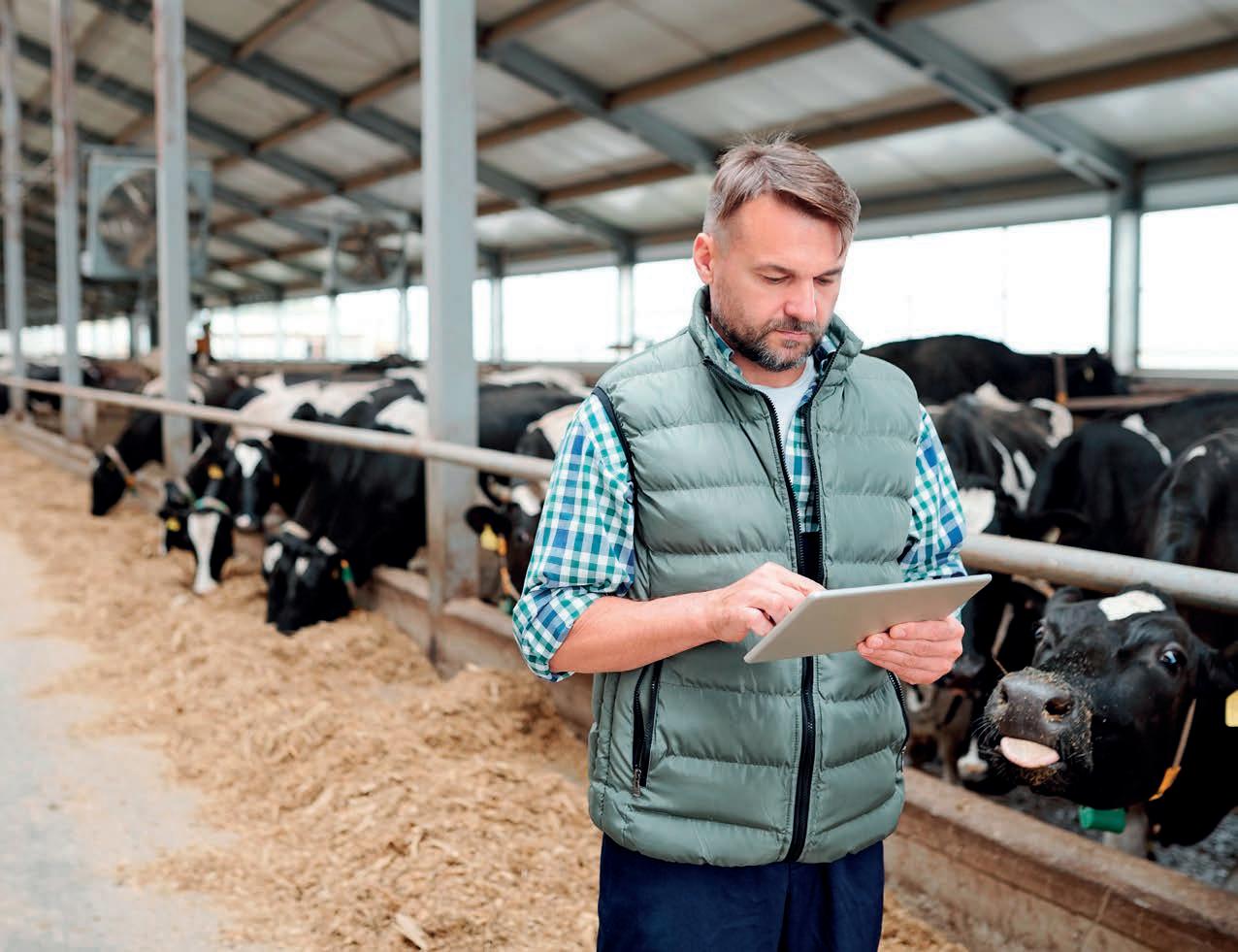

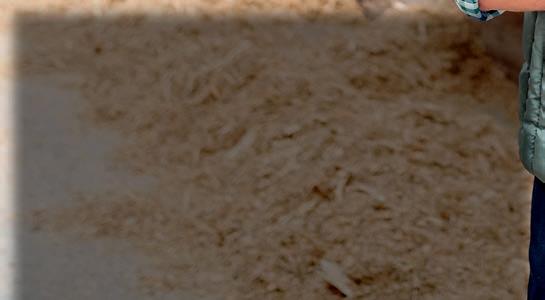
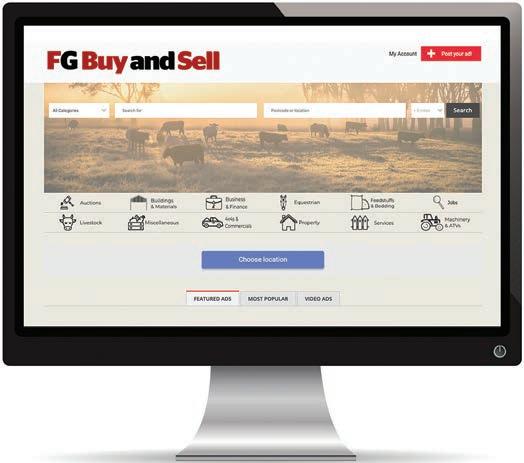


EU bu er and cheese prices are seemingly holding rm, especially compared with the dire situation on the GDT. Prices are dropping, but not signi cantly yet.
Traders say bu er is at €6,700-€6,800 per tonne (£5,652-£5,736/t), but the o cial prices as released by the German, Dutch and French dairy boards are signi cantly higher, so these prices are almost certain to dip in the weeks ahead. e bu er price in the UK is £5,800-£5,900.
Prices are therefore down
by about 10% from peak. In contrast, GDT bu er is down more than 25%.
Cream is seemingly remaining strong at €8,250 (£6,959), which equates to £2.80/kg in UK money.
Cheese also looks reassuringly stable, with edam, gouda and mozzarella all about €5,000 (£4,218), with some traders now quoting higher for Q4.
Cheddar prices in the UK are still at £4,900 for mild, but retail volumes are falling fast, according to the latest consumption data. is drop in demand is of considerable concern to manufacturers.
JAccording to the latest Defra stats for the first half of the year, liquid milk consumption totalled just more than 3,000 million litres, which is down 50m litres and 1.7% on last year, therefore continuing the steady decline which has been in play since 2017. Consumption over the last five years averaged 3,126m litres, so the latest figure is down 3.7%.
Cumulative cheese manufacture was 262,000 tonnes so far this year, which is within 1% of last year. Butter manufacture is 116,000t, down 3,000t and 2.7%, while powder manufacture is 52,000t so far this year, also down 3,000t and 5.9%. Yoghurt manufacture is 206,000t so far this year –down 17,000t and 7.6%.
It used to be the case that supply side concerns were at the top of their list of concerns, but not anymore. e impact on demand of rampant in ation and rising interest rates has overtaken it, to dominate sentiment.
Traders say we probably will not know where the true position is for dairy commodities until the holidays are over and the schools return in September.
Until then, the EU and UK markets are somewhat directionless. But as it stands today, the market could be whole lot worse than it is.
of milk used for liquid market in H1 (million litres)

JThe latest official Defra milk price for June is 42.66ppl at 4.07% fat and 3.32% protein, equating to 41.7p for a 4% fat, 3.3% protein standard litre.
The latest AMPE figure for July is 54.75p, which is down 1.68p on June, and equivalent to a farmgate price of 49p after an allowance for a margin and additional supply chain costs.
MCVE is at 53p, down 1p.
After a margin and costs, the farmgate equivalent is 45.67p.
The latest Milk Price Index figure, as calculated by the Ulster Farmers Union, is now 45.14ppl before transport and a processor margin, and about 39.64ppl afterwards. It is the first time the price has dropped below 40p since February.


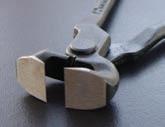
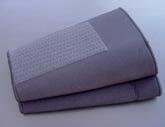
JThe GDT index was down by another 5% for the first August auction, the ninth out of the last 10 that has posted a decline.
The platform has lost 15% of its value in just three auctions and more than 20% since its March peak.
The average price has dropped below $4,000 (£3,312) for the first time since October 2021. WMP is at its lowest since February 2021 at $3,900 (£3,229) and SMP, butter and Cheddar are at their lowest since last October.
The GDT butter equates to €4,568 (£3,850). The differential is more than enough to make imports to the UK economic, even with hefty tariffs and shipment costs.
Indeed March saw the first imports of butter from New Zealand for four years, with
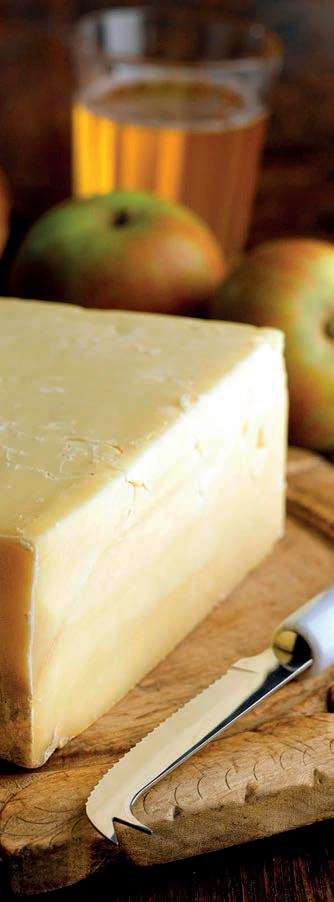



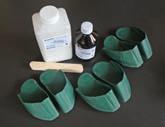


100 tonnes imported. There has not been any imported since though, but it is one to watch and Fonterra is known to have boots on the ground looking for opportunities in light of the new trade deal. Those opportunities might be now.
The commodities convert into an approximate UK milk
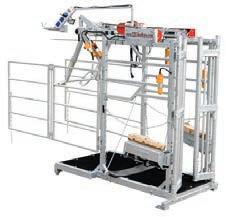

price equivalent of 37.6p and the difference between it and the average weighted non-aligned price is effectively the biggest on record.
This will inevitably pull down on UK farmgate prices unless the auction’s fortunes reverse, but traders do not expect it to do so anytime soon.

From farmer cattle crushes to wooden blocks, we have everything you need to keep your cows' feet healthy!
This month, we feature a new youngstock management app, a feed and forage calculator from Herdwatch, plus a new calving detection system which aims to improve general welfare and reduce the time and labour needed to monitor cows.
Five new varieties from Germinal are among those added to the recently published 2022/23 Recom mended Grass and Clover List. is year’s additions include: rAber ames – ideal for longterm performance and persistency, giving exceptional early spring grazing for early turnout, as well as excellent conservation yields in later years.
rAberDon – with the highest grazing energy yield (in MJ of metabolisable energy per hectare), this is the best option for those seeking outstanding animal performance through milk yield or liveweight gain.
rAberOpal – a high-yielding hybrid variety with a late heading date, making it useful for those who start mowing in the second half of May.
rAberSirius – a high-performing medium- to large-leaf white clover, important for farmers keen to capture the production
JNew products are featured in each issue of Dairy Farmer. Please send details and pictures to Hannah Park at hannah.park@agriconnect.com, or call 01772 799 450.
and environmental bene ts of including clovers in their grass leys.
rJaccar – an Italian ryegrass with

good all-round performance; bred in Europe, but available in the UK exclusively from Germinal.
rMore information at ahdb. org.uk/recommended-grassand-clover-lists
JA new calving detection system has been launched with a view to improving general welfare and reducing the time and labour needed to monitor cows during calving.
The BoviAid Calving Detection System, which won the ‘what’s next’ award for innovation at the Great Yorkshire Show this year, has been developed by Edward and Catriona Penty,
of Aldborough, over the last eight years. It incorporates sensors in a patch which is attached with animal-approved glue to a cow’s back. The patch communicates via a ceiling hub to alert farmers, via an app on a smart phone, when cows go into labour.
The sensors can be fitted up to three weeks before the due date and work by detecting when a cow’s movements change
to suggest she is in labour. After receiving the alert, the farmer can choose whether to watch, intervene or call the vet, or prepare the area for calving.
After calving, the patch is removed, the sensor recharged and then reused. For large herds, upt to 1,000 sensors can run off a single ceiling hub.
rMore information at boviaid.com
JFarm management software company Herdwatch has created a free tool for farmers to calculate the amount of forage they will need in winter, based on parameters including herd size and ages of animals.

Users of the tool can enter their winter feed to date, such as pit silage, silage bales, hay bales, straw bales,


maize silage, wholecrop cereal and forage crops, which is then converted to its equivalent value in tonnes of silage, with the aim of highlighting whether it is enough or not.
rThe calculator is free to use and can be found at info.herdwatch.com/ forage-calculator




JAgritech company Smartbell is launching a new app for easy recording and usage of youngstock data.
Free to use, it is designed to allow quick and easy entry of information such as treatments, weights and assessments on smartphone or tablet.
Reminders for future events, such as vaccinations, can be set, while multi-day treatments automatically generate a reminder in the app.
Batch treatments can be entered for multiple animals simultaneously and the calendar view illustrates how treatments vary within a particular month.
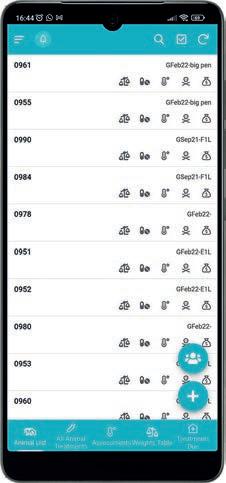
The app can also be used as a medicine book by recording medicine purchases and using the app fields to link these to treatments.
No purchase or commitment is required and the app is free to use. rDownload the app from wellcalf.com/ sb-lite-download

of Deutz
Deutz Fahr has an interesting history

when it comes to transmission choices.
Steadfast providers of mechanical transmissions with powershi options, the manufacturer launched a CVT model, the Agrotron V in 2001 and since has offered buyers these two transmission options across its tractor range.
Generally lower powered versions were o ered with a mechanical stick-shi with the larger models CVT only.
rough the manufacturer’s own admission, the brand has lacked the option of a full powershi o ering, something which is o ered by its competitors and is the transmission of choice from
some 70% of European buyers in the 120-150hp segment.
e Series 6C range provides a direct replacement for the current 6120, 6130 and 6140 models and includes a new Stage 5 emission rated engine, new cab speci cations and controls, and crucially for Deutz, a new transmission option.
e RC Shi full powershi option sits between the confusingly titled Powershi using ve mechanical gears with two or three electronic splits and the stepless V option.
e new RC Shi transmission shares a lot of mechanicals with its CVT cousin, and allows drive progression over its 20
Powershift Five mechanical, with two or three powershift steps
Optional creeper gears
Maximum 40kph
RC Shift 20 forward x 16 reverse
Optional creeper
Maximum 50kph
TTV Stepless transmission

Maximum 50kph
6115C 126hp

6125C 136hp
6135C 143hp
forward and 16 reverse steps to a maximum speed of 50kph.
An additional creeper box is available o ering forward speeds down to 20 metres per hour as a factory order or dealer activated option.

Presented as a tractor designed for easy of use, the new drive is operated through a simple arm-rest mounted joystick, which intuitively is pushed forward to increase the range and pulled backwards to reduce.
Rocking the stick towards the operator engages cruise control.
Alongside the drive joystick, bu ons on the console are used to select gearbox speci c functions including automatic power shi (APS) and mode control.
Two modes are o ered are Work and Transport which are

designed to hold the machine in a speci c range.
e maximum and minimum gears for each mode can be congured by the operator through the dash mounted colour screen.
e cab has been li ed from the smaller 5 Series but includes a complete re t across the three models, and is o ered in three main speci cations allowing for the di erent control interfaces for the transmission choices.
Puzzlingly, the smallest model in the range, the 6115C, uses a cab design identical to the smaller 5C range. is design is not shared with any other models in the 6C.
The new Series 6 models offer power outputs of 126-143hp.
Inset: The transmission is operated through a simple three-way joystick.
In use, the tractor is easy to drive and can be con gured to press and go on the thro le with the control of the gear shi ing le to the responsibility of the gearbox controller.

Visually the dash mounted colour screen is clear, but the information in slightly clu ered and it is not immediately obvious which range the machine is working in, or if the full automatic

Fine or bales
25kgs bales
Very Absorbent
60 pallet
Dusty and free flowing
Fine softwood
Bulk Home Grown bulk only
27 tons walking floors
Organic Green Sawdust
Softwood coniferous
Variable moisture
Easicattle bulk
tons
from
Organic
Kiln dry bulk or bales

13 tons walking floor
18-20 kg bales
bales / pallet
Fine non-dusty free
White and cream
Absorbent
clean
Bulk Lime Powder bulk




29 tons
Can be
transmission has been activated. Cab interior is well laid out and the controls clear and in keeping with the bright-colour grouping style of the Deutz range.

e 120 litres/minute hydraulic output is e ectively delivered to the loader control through the second joystick, with a precise and fast response of the Stoll sourced loader.
Visibility through the top vision cab to the loader at full height is good, with a relatively narrow cross bar between the windscreen and roof window.
In addition to the new transmission, the new cab layout includes an optional secondary joystick for front loader operation, front axle and mechanical cab suspension and Topcon sourced SDF guidance and steering.
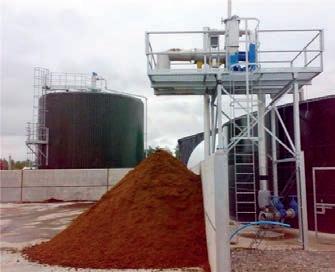
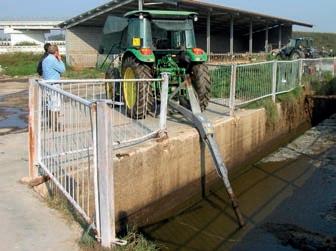

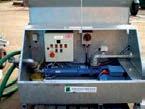
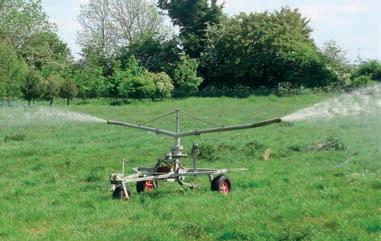






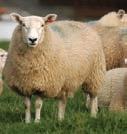
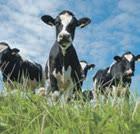







Agri Connect is the largest multi-platform agricultural information business in the UK. Our brands reach deeply into all the major agricultural sectors – arable, dairy, livestock, agricultural machinery, nance and equipment. We take a farmer-centric approach to media. Our job is to help farmers run their farms more e ciently and make better purchasing decisions. There are many ways in which we can do this –magazines, websites, webinars, podcasts, conferences, events, and marketplaces.

You will be a key member of an energetic, supportive, and enthusiastic team who are committed to building on our positive and dynamic culture.
The main function of the role is to develop business through growth in revenue, yield, and to increase customer numbers. You will be required to identify new opportunities and in uence companies’ media buying habits within the agricultural sector. Due to the ever-changing nature of the industry, this person will have the ability to spot new avenues and exploit market trends.
• Own, support and fully develop speci c market sectors
• Conduct sales presentations by telephone, email or face to face to existing and prospective clients in order to develop existing business and generate new business wherever possible.
• Advise existing and new customers on the most e ective solution to meet client needs within the Agri Connect portfolio.



• Continually seek and develop new sales & opportunities.
• Achieve all pre-set sales targets ensuring a successful contribution to the business performance.

• Keep abreast of all current trends, activities and relevant

agriculture.
This month, Roger Evans discusses the price of milk, whether it is viable for farmers to keep producing their goods, and gives a suggestion for what needs to happen in Westminster.
Yesterday on TV, the chair of one of the major supermarkets was being questioned about the rising cost of food and whether the supermarkets could do any thing about it. He said that his supermarket had made a commitment to freeze the cost of staple foods for 12 months.
This was bad news for dairy farmers. Milk is a staple food. If his shops keep the price of milk down, so too will all his competitors, there would not be the slightest chance they would go into a future where they were more expensive on milk.
Milk has always been a loss leader and so it will continue to be.
We are not selling milk at the moment, with no cows and no land to keep them on. But we will be in no rush to start up again if the signs are not good for the future.
We are going to concentrate our efforts on selling milk through our milk dispenser and see how that goes.
People often say the major supermarkets collude. Perhaps they do, but it doesn’t matter because they all have the same philosophy anyway, so suppliers, like dairy farmers, are squeezed.
We hope to be selling milk retail before too long, but our other enterprise is producing point of lay pullets.
Milk and eggs are predicted to be in short supply in the future – time will tell. There’s a part of me hopes that they will.
When I was a little boy, my father had a wealthy uncle in Canada. It was widely accepted in the family that he was to leave me all his money. This didn’t mean much
to me at the time, I didn’t understand money then.
As it happened, he had ill health and moved to Florida and physicians had all the money. But he used to send me a pack of newspapers and magazines for years. One of these was a Cana dian farming paper and I used to read it avidly.
They used to talk of people being paid ‘to raise hogs’. This was a new idea in this country, it was a sort of set aside. Could it be that we are about to enter an era when folk are better off not farming than actually producing food? I hope not.
I am writing this in the kitchen. It’s a good place to be writing because there is no-one else about. It’s the time of year when our kitchen door is open all day. It’s a brave person who would go out of our kitchen door, because the space outside is ruled by a very cheeky robin that we call George.
There used to be about 100 sparrows out there. It’s all stone walls and creepers, ideal for a lot of sparrows, but there are only about 10.
George comes in the house whenever he wants. I quite like to watch the news on TV at midday and George comes down to watch it with me. He perches on a table lamp and finds it all quite fascinating.
If I have time, I quite like Prime Minister’s Questions on Wednesdays. George likes this as well, he reckons that politicians are a bit like sparrows, they make a lot of noise but have very little to say.
I remember once I went to a meeting and didn’t say a word. When it was finished the chair came up to me and said: “You didn’t say much today, Roger.” I replied: “No, neither did these others.”
It is natural to go to a meeting with a question to ask, but if someone else asks it I don’t see any need for you to repeat it, but if you see these politicians at work I would be ashamed to ask some of the questions they ask and if I couldn’t think of something better than that, well I wouldn’t bother.
Back to George. There is a squeak and a fluttering of wings and two little blue tits come into the kitchen, hotly pursued by George. They go onto the draining board and George gives them a spiteful peck before he leaves by the open door.
The blue tits fly about the kitchen, resting occasionally on some of the units. They are
much too high for me to catch on my own so I decide to leave them for now until there is a solution.
We use those old-fashioned sticky fly papers in the kitchen and this week we have put two up. As good as gold, these two blue tits fly on to these papers, get stuck there and it is a simple matter for me to pluck them off.
I make sure their feathers are all clean before I release them.
Perhaps they should fit some at Westminster, it might sharpen them up a bit, which would be no bad thing.


“Milk has always been a loss leader and so it will continue to be
Browse, list and apply for hundreds of the latest roles at jobsinagriculture.com
Normally milk production increases when there is an increase in milk prices. But that has not happened over recent months despite values reaching record levels.
Between June 2021 and June 2022 the average milk price increased by 40%, according to Defra, with further increases since then. Between 2012 and 2013 prices rose by 30%. Within two and a half years production had risen by 15%, prompting a drop in values. is time round, high costs and, more la erly, dry weather, has reduced output. e AHDB’s latest forecast is that British milk production in the 2022 calendar year could fall by 1.6% to 12.25 billion litres, but the decline could be much greater.
e AHDB has published scenarios for GB production in the current milk year. ey range from a low impact 1.4% decline in milk production as the result of further pressure on cash ows because of high feed costs to a 3.8% decline as the result
High feed costs, coupled with a lack of feed brought on by the dry weather, mean that forecasts suggest milk production in the 2022 calendar year will fall.
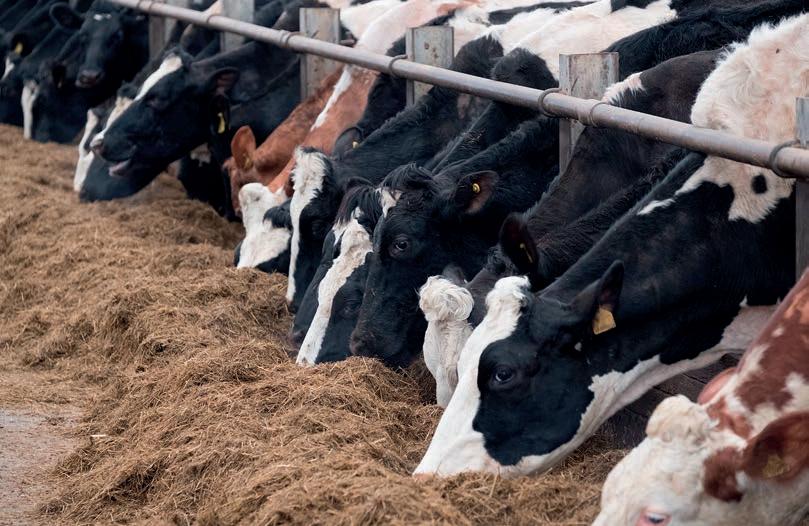
of a drop in yields driven by continued rising costs, a lack of feed and destocking. Under no scenario is there an increase in output.
“So far milk prices have largely kept pace with the increase in costs of production, but if they come
under pressure or feed and other costs increase then production will start to fall faster than it has,” says Pa y Clayton, senior dairy analyst at AHDB.
“Meanwhile, the very dry weather means that later cuts of

silage are di cult and some producers are already feeding forage they cut in the spring.”
EU milk production has also started to ease, although the decline has not been quite so great as in the UK so far, with European Commission predicting a 0.6% drop in output for the whole of 2022. Analysis by the AHDB, predicts a 0.5% decline in milk output by the world’s largest dairy exporting countries this year.
US production should hold relatively steady, but a 2.4% or 208 million litre reduction in Australian output is expected, with a 0.7% or 251m litre drop in New Zealand production. Argentina is the only country of the major exporters that is expected to increase its output this year, by 173m litres or 1.7%.
Dairy analyst Chris Walkland sees
li le on the horizon to encourage an increase in global milk production, especially in the traditional exporting countries.
“In the past markets have been driven by a lack of supply for a very short period of time, with producers responding to high prices by increasing output. It looks like the pressure on supply this time is much more fundamental and could last for a much longer period of time.”


He says that the cost of inputs and dry weather may be holding back production in the short-term, but other issues could curtail output in the longer term.
“ e lack of labour continues to be an issue for dairy farmers across the world, with some of them abandoning expansion plans or even giving up because they cannot nd the sta they need. However, environmental measures are also starting to have an impact. In Wales NVZ restrictions could limit production,
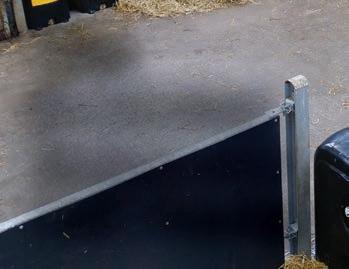



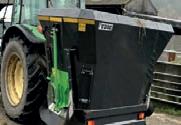
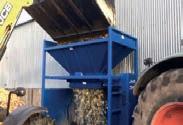
while further a eld the Netherlands is also pu ing limits on nitrate usage and the EU’s new Farm to Fork policy will limit the amount of fertiliser and pesticides that can be used. Meanwhile, carbon usage rules and other environmental measures could reduce New Zealand’s dairy output.”

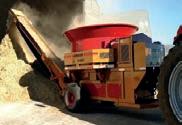
New Zealand could be one of the rst countries to tax methane
emissions in ca le. e number of NZ dairy ca le increased by 82% between 1990 and 2019 to 6.3m head, according to the country’s statistical service. Greenpeace has called for a halving of the number of New Zealand dairy ca le, although others have suggested a 10 to 15% drop is more likely.
Global milk usage is expected to increase by 1.4% a year over the
JWorld dairy production grew by 16.7% between 2012 and 2021, according to the UNFAO/ OECD. It is expected to increase by a further 16.9% between 2021 and 2030, but that growth will be focused in consuming countries rather than exporting ones.
Indian milk production jumped by 51% between 2012 and 2021, and is expected to be up another third by 2030.
Growth in African milk production is also expected to be strong for the rest of this decade, with moderate growth in North and South America. In contrast, EU output is expected to increase by just 4.4%, with UK production up 0.1% and production in Oceania (NZ and Australia) down 0.3%.
There is the potential for extra milk production in the UK. By 1987 the UK’s 3.042 million dairy cows were producing
next ten years, according to the most recent outlook by the UN’s Food and Agriculture Organisation and think-tank the Organisation for Co-operation and Development. e dairy market is mature in high income countries, with consumption growth of just 0.4% a year expected for the next decade. at contrasts with 2% a year in low-middle income countries.
14.718 billion litres of milk. In 2021 there were 1.850m dairy cows, a 40% drop on the 1987 level, but they were producing 14.983bn litres of milk, slightly more than production in 1987.
If the UK dairy cow herd were to return to its peak of 3.333m in 1983 and deliver the current average UK milk yield of 8,100 litres a cow a year then total production would be nearly 27bn litres.
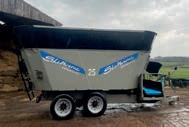


A £50,000 investment to support British agriculture on its Journey to Net Zero has been announced by the School of Sustainable Food and Farming (SSFF).
The SSFF’s Journey to Net Zero competition is supported by Bradford Estates, Harper Adams University, McDonald’s, Morrisons, the NFU and Trinity Ag Tech and Trinity Global Farm Pioneers.

With a total prize fund of £50,000, awards of between £5,000 and £20,000 will be made to competition winners this autumn. Entrants will need to explain how they plan to implement a scalable system or processes which will have a positive and measurable impact on how they farm in a sustainable way.
In addition to the prize money, winners will have access to sector experts and mentoring. SSFF was established in October 2021 to support the agricultural sector to reach net zero.
Announcing the competition, Prof Michael Lee, deputy vice-chancellor of Harper Adams University said: “SSFF at Harper Adams University is delighted to launch this competition.
● A shared prize fund of £50,000
● Access to experts and mentors from SSFF and steering partners to support them on their journey
● Free access to Sandy, Trinity Agtech’s smart

“Harper Adams University, working through our new SSFF and supported by our industry partners, is committed to delivering the training and research needed for a just transition to support all UK agriculture, be that through: reducing methane emissions of ruminant livestock; improving soil health; or realising biodiversity improvement in mixed cropping systems.

“We are working with some of UK’s brightest and most innovative farmers and we really look forward to expanding this network through the competition. We realise that the greatest take-
● Opportunity to become part of a network which is committed to farming in a more sustainable way to reach net zero
● Opportunity to be become an ambassador or advocate for the school
up of technology and interventions is through seeing these implemented on real farms, hence the excitement around this competition.”
Innovate Head of agriculture for Morrisons, Sophie Throup, said SSFF acknowledged getting closer to net zero was hard and required a whole farm approach and refreshed ways of thinking. She said it was import-

● Applicants can be from any area of the farming supply chain; they do not have to be a farmer themselves, but they must demonstrate they are farm-based with the project to be carried out on a farm they are associated with
● Applicants can be from urban or rural settings
● The types of projects considered should have potential
ant to innovate and think creatively about problem-solving.
“We can all try and make changes on-farm, targeting fertiliser applications more thoroughly, tracking feed efficiency more effectively and focusing on breed improvements.”

Harriet Wilson, agriculture and sustainable sourcing manager for McDonald’s, added: “Net zero and climate challenge is probably the biggest driver of necessity to change that we will face over the next 10 years and the inventive farming mind is well-placed to come up with some of the solutions.”
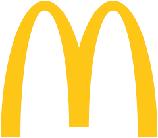
Visit FGinsight.com/ NetZeroCompetition and complete the entry form no later than September 30, 2022. Shortlisted entrants will be selected by late October and winners will be announced by the end of the year.
to measure big impacts through small changes which could be easily scaled, adopted and further developed by others

● The projects should be commercially viable to support knowledge sharing and adoption by others
● The application can be for a new project or to further develop one which has already started

